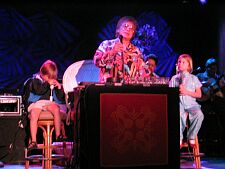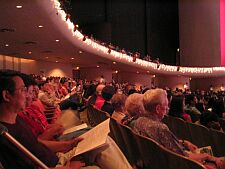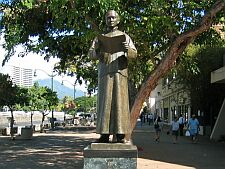28 December 2002
27 December 2002
Last Day at Sam's
we spent the last day at sam's doing little errands and going over music for the wedding. the kids worked with my sister on the gingerbread creche. and then we packed up our stuff to move to the hotel in waikiki.




usually, my sister the ex-architect works up a gingerbread house for the holidays. often really a castle! but since she was away from home, the design was more modest. of course, the rest of us were still wowed by her creative talents. the humidity played havoc with the design though. the first evening, the "icing" wasn't completely dried, and ended up running down the side of the gingerbread wall.




driving to waikiki, there was a lot of mist in the air, and we saw dozens of rainbows. literally dozens. they were so beautiful.
in the evening, we went to see the don ho show. growing up, we'd listened to his songs and heard stories from my aunt and uncle and cousins who have lived in hawaii for the last 30 years or so. so it was cool to hear him. and despite his age, he did a pretty good job, made lots of cracks on his age, and went on for almost two hours. amazing stamina really. the rest of us were ready to call it a night.




26 December 2002
Merry Christmas!!




after our late night, we had a lazy Christmas morning. of course the kids were up around 7am. but everyone else gradually wandered down hours later. Windy did her early morning laps. the kids played games with environmentally conscious themes (progress!). and i downloaded pictures.
the kid's game was pretty interesting. the pieces included animals, hunters, trees, etc., and basically i think it teaches a consciousness about how easy it is to upset the fragile balance of nature.




after everyone had breakfast, we gathered in the room with the tree to open presents. sarah's kids had already had their real Christmas before they arrived. so they got to celebrate a second Christmas. it seems like such a long time ago when i would have been so ecstatic and anxious for Christmas day. oh, to be a kid again. ignorance is bliss.


after all the presents were opened, sam started the grill and there was more swimming, hanging out in the jacuzzi, and the construction of a few Lego contraptions with 'Chungking Express' playing in the background. what a lazy day. Merry Christmas everyone!!
25 December 2002
Christmas Eve




went back to the Hale Koa to check out reception arrangements. this time my sister and her husband came along to check everything out. the fake snow trees and santas looked like they'd melt and i felt hot just looking at all those clothes!


in the evening, we went to the airport to meet my aunt. our fourth trip, with only three more to go! afterwards, we parked near the Blaisdell Concert Hall, and walked to a pretty good Hong Kong restaurant nearby.




After dinner, we went back to the Blaisdell for the Christmas Eve service done by Honolulu First Presbyterian. my aunt was helping to coordinating the staff and logistics for the show. so we hardly got to see her. what a lot of work! the performances were impressive though. Merry Christmas everyone!!


East Coast White Christmas
Watch What You Wish For, Including a White Christmas
By SARAH KERSHAW
http://www.nytimes.com/2002/12/26/nyregion/26SNOW.html
A northeaster battered the East Coast yesterday with sleet, freezing rain and snow that closed airports and major airways and gave New York City its whitest Christmas since 1909.
It was not what Irving Berlin had in mind. It was wet, slippery and dangerous. Whipping winds and icy slime shut down the city's two airports, made traveling by car perilous and kept people who were planning to venture out for a holiday meal holed up at home.
As of 7:15 last night, 4.5 inches of snow had fallen on Central Park, the only significant snow on Christmas inside the city since 1969, when 2.1 inches fell. That made it the first official white Christmas — defined by meteorologists as a Dec. 25 with one inch on the ground — in 33 years.
The only other New York City white Christmas of the 20th century came in 1909, when there were seven inches, according to Todd Miner, a meteorologist at Pennsylvania State University.
There have been dustings and traces, to use the technical terms, in the city on several Christmases past, and some New Yorkers may be positive that they have, in fact, frolicked through many a white Christmas in the 1970's, 1980's and 1990's.
The snowfall came as the storm pounded much of the Northeast, turning from icy rain and sleet into snow in the late afternoon, as temperatures fell below freezing.
Immediately outside the city, up to six inches of snow was expected to fall by the storm's end, by around midnight, with records for Christmas Day set in Buffalo and other parts of upstate New York. Some parts of the state reported more than two feet of snow, forcing officials to close a 100-mile stretch of the New York State Thruway from Syracuse to Amsterdam, near Albany.
Once the snow began, it fell at a furious pace — at least two inches an hour — and it was met with a mixture of delight and misery.
For anyone trying to travel — or work — on the holiday, there was the unpleasantness of having snow spraying into their faces, or their shoes sliding across the sidewalk, their cars trundling slowly across slippery, unplowed roads or their flights delayed or canceled.
"Life is very miserable," said Mutfar Rasman, 54, a Bangladeshi immigrant who was pumping gas at a Sunoco station in the Van Cortlandt section of the Bronx late yesterday, as the snow that had soaked his gloves so much he removed them began to fall faster and faster. "It might be good for Americans, but for me, it's very difficult."
There was a clear difference of opinion across the region yesterday as to whether snow on Christmas — the kind of snow that fell yesterday, anyway — was something to cherish or something to curse.
For Juan Carlos Alvarez, 34, who moved to Manhattan from Miami six months ago, the notion of a white Christmas made him giddy.
"Yeah, snow — it's perfect," he shouted into his cellphone yesterday, as he stood in Rockefeller Center and chatted with a friend in Utah while the snow began to fall. "I couldn't have planned it any better. This is Christmas in New York, right? That's what it's all about."
Throughout the day, the city Sanitation Department deployed 500 workers and 359 salt spreaders, officials said. But they did not start plowing the roads until about 4 p.m. and waited to plow until between an inch to an inch and a half had accumulated, prompting some city residents to question the speed of the response.
But Vito Turso, a spokesman for the department, said the city reacted "right according to plan," with 1,000 pieces of equipment out on the streets by about 9 p.m., including salt spreaders and dump trucks, and a total of 1,600 workers deployed overnight to clear the streets.
As of 9:30 p.m., La Guardia and Kennedy Airports remained closed, and Newark airport was reporting 40-minute delays. Alan Hicks, a spokesman for the Port Authority of New York and New Jersey, said that the runways were being plowed and that he was awaiting word from the Federal Aviation Administration on whether and what time to reopen the airports. He said that Christmas was not a heavy travel day.
About 9,000 people on the Rockaway Peninsula of Queens lost electrical power yesterday, although officials said it was unclear whether the problem was related to the storm. In Westchester, 1,200 Con Edison customers lost power in the morning in what officials said was a weather-related incident, and an additional 300 homes in the Seagate neighborhood of Brooklyn lost power because of ice on the wires.
On the Upper West Side, a few hours after the snow began to stick, the streets were quiet. Parents wearing pained-looking expressions held hands with children wearing puffy coats, trying to hurry them home. Winds whipped snowflakes into people's eyes, and men with wool hats shoveled snow at bodegas.
Snow collected gracefully on the branches of trees along Riverside Drive, but the winds were so fierce — reaching 40 miles per hour — that there were few people around to appreciate the wonderland effect.
Blanca E. Salazar, 31, a Mexican immigrant visiting from North Carolina, stood on 101st Street and videotaped the scene as cars, most of them taxis, streamed down a Broadway sprinkled with snow. She had no hat, and snowflakes collected on Ms. Salazar's shiny black hair. But that was a small price to pay, she said, for the joy her relatives in Mexico would get from watching a home movie of a snowy New York.
"I love snow, I love it," said Ms. Salazar, slipping her video camera into her jacket. "I think it's a great day, a beautiful day."
In the suburbs, where the storm dropped as much as half a foot or more, people able to stay inside said they felt cozy, but many plans were changed. Danielle and Robert Goodman held a holiday party in Hastings-on-Hudson, N.Y., but three out of the four families they invited could not make it last night because of the bad driving conditions. But for those who were there, said Ms. Goodman, "the spirits are high. It's beautiful, like a fairyland outside."
The snowstorm, which moved out of the central Plains, was blamed for at least 14 deaths since Monday. The intense weather system moved east Tuesday night, from the Midwest into Pennsylvania and then into New York and New England.
Most of the storm-related deaths were caused by traffic accidents. Since Monday, six people were killed in Missouri, four in Oklahoma, three in Kansas and one in New Mexico.
Yesterday, New England was hit particularly hard. By midafternoon, road conditions in Massachusetts had deteriorated significantly on several major highways. "We've got a mess out here," said Trooper James Ryan at the Westfield barracks in western Massachusetts. "Cars are sliding all over the place."
Pittsburgh had about an inch of snow, and areas just south of the city, had six inches. Snow also fell on northern Ohio and Indiana, where Indianapolis had a record snowfall of 7.6 inches. Baltimore had a mix of steady rain and sleet replaced by midmorning with cotton-ball-size flakes of swirling snow that turned to thick slush as it hit the ground. Slush forced officials at Baltimore-Washington International Airport to temporarily close the two major runways temporarily. Six inches fell on parts of western Maryland.
In Baghdad, There's Little Romance in Music by Candlelight
In Baghdad, There's Little Romance in Music by Candlelight
By NEIL MacFARQUHAR
http://www.nytimes.com/2002/12/26/international/middleeast/26BAGH.html
BAGHDAD, Iraq, Dec. 25 — The musicians of the Iraqi National Symphony Orchestra, elegant in black tie or long black skirts, were just settling into their places on the final night of their Christmas week concerts when the electricity failed and the performance hall was plunged into darkness.
For a while afterward, the performance unrolled with a dreamlike quality. A note from the oboe floated through the pitch black, guiding the players tuning their instruments, until candles affixed to the music stands illuminated their scores. The musicians played an initial overture and then the tenor soloist, Emad Jamil, sang the Agnus Dei from Bizet's "L'Arlésienne."
But with each turn of the sheet music, the players grew increasingly nervous about the risk of igniting the barely legible pages. So they stopped before the final Bach piano concerto.
"We might as well have been playing in Bach's time," Mr. Jamil later joked ruefully. "But at least I could forget myself in the music. For a short period of time there was nothing but music. It's very hard living with the thought that soon we will have another war."
Baghdad used to pride itself as the living soul of "1,001 Nights," a cosmopolitan place where sophisticated music, theater or cabaret acts spun on long into the night, and where the Iraqi middle class kept every publisher in the Arab world afloat.
Since the beginning of the eight-year Iran-Iraq war in 1980, however, Iraqis have ricocheted from one crisis to the next. The once thriving middle class has been groping through an especially long dark night of plunging living standards since economic sanctions were imposed after Iraq invaded Kuwait in 1990.
Now they find themselves bracing for yet another conflagration in which they have little voice. In response, they cling to what normalcy they can, defiant one minute and utterly gloomy the next.
"In life, sorrow tends to last just a little longer than joy," said Abdul Razak al-Alawi, who helped found the orchestra in 1950 and has been its conductor since 1974. His son and daughter, elementary school students, died in 1985 when their home took a direct hit from an Iranian missile.
"So we try to just touch the joy to alleviate the sorrow."
Most Iraqis seek any brief escape, although even the jokes tend to swirl around their desperation. Audiences have been packing the National Theater every night for a show called "Vagabonds," which gently mocks Iraqis for having become a nation of beggars.
The show starts with a beleaguered intellectual staggering on stage and waving a book while lamenting, "People just want to eat and earn money; nobody is thinking about reading."
A gyrating belly dancer replaces him, caterwauling about her rise from penury to plenitude. Baghdadi intellectuals bemoan the fact that most of what passes for a play these days is thin on plot and long — up to four hours long — on song-and-dance.
Much of it is slapstick. When the dancer's handlers say they need to change her name to enhance her attractiveness, one character suggests they name her after any brand of Iraqi beer. Some jokes poke fun at the tendency of Iraqi television — one of 14 available channels — to play bootlegged American movies.
But the loudest laughs come for characters who reflect the sad changes that have beset a once wealthy country, like the man reduced to selling plastic bags.
"Imagine the difficulty of making people laugh after 20 years of war and 12 years of sanctions," says Abed Ali Qaed, the show's writer and director, weighing in with his own twist on an oft-heard political remark, "The conspiracy against our people by the Zionists and the Americans is to kill our ability to laugh."
Iraqis sense they are caught in a twilight zone. The Draconian sanctions imposed in 1990 were alleviated somewhat by an oil-for-food program started in 1996, but virtually everything the country wants to buy must be approved by the United Nations.
When the last two passengers holding up a plane from Amman to Baghdad were stopped at security, the officer rummaging endlessly through their bags asked the airline agent, "Are they journalists?"
"Of course, they are journalists," the agent shot back. "Who else would want to go to Baghdad?"
Sahar N. Kharrufa, a Baghdad University architecture professor, finds that his students have a far narrower view of life than previously. "They have never been to a museum, never been to a theater, never been to the movies, nor to a library," he says. "The general quality of all these kinds of places has degraded."
Abdul Sattar Jawad, chairman of the university's English department, comes back from a class teaching Sophocles' Theban Plays and offers herbal tea. Asked what the term "regime change" — the Bush administration's phrase for ousting Saddam Hussein — means to him, he scoffs.
"This is wishful thinking," he said, saying real respect for human rights should mean the United Nations would lift its sanctions. "What is the benefit of changing the regime if you bring another group of quislings?"
It is difficult to gauge the mood in Baghdad toward what the Bush administration says and does about Iraq. Virtually every interview for this article took place in the presence of one of the shepherds from the Ministry of Information who guide the flock of foreign journalists.
No doubt Iraqis dread the deprivations another war would bring, and few would want to be American colonial subjects. But in unguarded moments — in parking lots and elevators and amidst grocery store shelves — they will suddenly let rip with an unvarnished opinion.
"If it weren't for the Americans, the prisons would not have been emptied," said one man, referring to the general amnesty the government granted in October.
Another points to a typically crumbling cement apartment block with broken windows and says, "This should be the richest country in the world, so why are people living like that?"
The story of Iraq's lone symphony orchestra follows the arc of the country's development and subsequent decay. Formed with a few strings, woodwinds and horns, by the early 1970's it blossomed into a full 70-piece orchestra with 20 to 30 foreign members.
It has by now shrunk to some 45 musicians. Big booming pieces like much of Tchaikovsky, Brahms's Fourth Symphony or Beethoven's "Eroica" are out of reach. Most of the best instruments have been taken abroad for sale, and replacement parts are rare and costly.
When the orchestra started, its members got the then princely sum of 10 dinars, or $30, a month. Now they get 25,000 dinars, which is worth $12. That's a little less than the cost of a new set of strings.
Every member of the orchestra has another job. The tenor grinds coffee beans. One horn player drives a cab. The man who plays the bassoon also fixes electric heaters.
They try to give one concert a month, but sometimes too many miss practice because of their jobs. The audience turns up faithfully whenever they perform.
"The good musicians have all retired or left Iraq," said one man in his 60's, a patron for decades. "Still, it's better then spending a lonely evening at home where you don't know when the electricity might be cut."
Moments after he spoke on Monday night, the power failed in the performance hall. Mr. Jamil, the tenor, stepped to the edge of the stage before his solo to say the candlelight made the night seem blessed, expressing his wishes for a Merry Christmas and a far happier New Year for all.
"Everybody always makes wishes, but nothing ever changes," said a voice in English from the dark.
Persistent Drop in Fertility Reshapes Europe's Future
Persistent Drop in Fertility Reshapes Europe's Future
By FRANK BRUNI
http://www.nytimes.com/2002/12/26/international/europe/26FERT.html
FERRARA, Italy — On a recent night at the Blue Elephant recreation center here, a clutch of parents watched adoringly as dozens of 3- and 4-year-olds sprinted through a colorful playroom, bounced on the cushioned floor or doodled on drawing pads, aglow with creative pride.
It was Italy as outsiders still imagine it: child-worshiping and family-loving.
But there was something wrong with the picture. Most of the parents were gazing at one, and only one, child.
In no West European country did the rate reach 2.1 — the marker that, demographers say, means an exact replenishment of the population. By contrast, the United States had a 2.0 rate, which demographers attribute to greater immigration.
That was true of Gianluca Valenti, who said that giving his son any siblings would be too exhausting and expensive, and of Barbara Lenzi, who said that more than one child "doesn't seem to make sense."
It was also true of Rosa Andolfi, who responded to a question about having an additional child as if a vampire were near.
"Basta!" Ms. Andolfi more or less yelped, then made a cross with her index fingers and thrust it forward.
That gesture was not just funny but telling; it touched on an increasingly worrisome reality for Italy and other European countries whose fertility rates have plummeted over the last decades, shifting one-child families close to the statistical norm.
In Spain and Sweden, Germany and Greece, the total fertility rate — or the average number of children that a woman, based on current indicators, is expected to give birth to — was 1.4 or lower last year, according to the World Health Organization.
In no West European country did the rate reach 2.1 — the marker that, demographers say, means an exact replenishment of the population. By contrast, the United States had a 2.0 rate, which demographers attribute to greater immigration.
While that trend has been evident for many years, its slow-building consequences are now coming into starker relief, as more West European countries acknowledge and take new steps to address the specter of sharply winnowed and less competitive work forces, surfeits of retirees and pension systems that will need to be cut back deeply.
In Italy, where the fertility rate last year was 1.2, according to the health organization, Labor Minister Roberto Maroni has announced that the cost of the state pension system will need to be reduced. Mr. Maroni said the government would offer incentives, which he did not specify, to keep people at work past the minimum retirement age of 57.
The United Nations recently published data suggesting that the population of Spain could decline to about 31.3 million in 2050 from about 39.9 million now. According to the World Health Organization, Spain's fertility rate last year was 1.1, the lowest in Western Europe.
Many provinces in Italy's wealthy, well-educated north have rates well below that.
The rate in the province of Ferrara, which includes the city of Ferrara, has been under 0.9 for each of the years since 1986 that Italy's National Institute of Statistics kept track.
Ferrara officials talk about the dearth of young children in the streets, the closing of elementary schools over the last decade and a pervasive sense that something is missing.
"There's a lack of energy," Deputy Mayor Tiziano Tagliani said in a recent interview here. "The society is colder without children."
Nationwide, Italy's fertility rate has been so low for so long — under 1.5 since 1984 — that the country offers an especially good glimpse into the dimensions and dynamics of the trend.
For example, Italy now has the world's oldest population. The percentage of people 60 or older is 25, compared with 16 percent in the United States, according to the population division of the United Nations.
The division's experts project that by 2050, if current trends hold, 42 percent of Italy's population will be 60 or older.
Antonio Golini, a professor of demographics at the University of Rome, Sapienza, said that would be "unsustainable, from a cultural and even psychological point of view."
That sense of alarm was reflected in Pope John Paul II's first-ever address to the Italian Parliament in November. The pope said "the crisis of the birthrate" in Italy was a "grave threat that bears upon the future of this country."
In Italy, as in other West European countries, the low fertility rate is interwoven with an array of other issues — immigration, for one. While many people and many politicians in Europe would like to clamp down on the rising tide of new arrivals over the last decade, they may be forced to accept it, simply to fill jobs and maintain levels of productivity.
Europe stands out as the continent with the lowest fertility rates. The numbers are now starkest in East European countries like Bulgaria, Latvia and Ukraine, each of which had a rate of 1.1 in 2001, according to the World Health Organization. (Its figures sometimes differ slightly from those of individual countries, but provide a yardstick.)
But the trend hit Western Europe earlier, and has had more time to produce hand-wringing and soul-searching. Apart from welcoming more immigrants, no one knows precisely what to do.
Many governments have expanded tax breaks for parents, child care alternatives or maternity and paternity benefits, acknowledging that a high cost of living and more women in the work force can be obstacles to large families. In some of those countries, like France, the fertility rate has nudged slightly upward.
Spain is considering a variety of ways to address those obstacles: cheaper utility bills for large families; assistance for young couples who are trying to afford homes; the creation of hundreds of thousands of new preschools and nursery schools; and longer hours for existing schools, an accommodation for working parents.
Although the Italian government provides mothers with nearly full salary compensation for about a half-year of maternity leave, the city of Ferrara, like several other north Italian cities, added benefits that kick in after that period. They include cash supplements of about $350 a month for mothers who want to stay at home an additional nine months. Ferrara also has pumped millions of dollars into nursery schools and child care centers like the Blue Elephant.
But Italy's low fertility rate persists, suggesting that the reasons go well beyond the arithmetic of salaries and schedules.
"People are studying longer, and thus are finding work later, when there is work, and then are marrying later, which doesn't necessarily mean having a baby anymore," said Valerio Terra Abrami, head of the department of social statistics for Italy's National Institute of Statistics.
Contraception and abortion are more readily available. Divorce is more common.
Moreover, decades of prosperity have altered people's assumptions and expectations. Older people once poised to look after grandchildren now pursue other activities and travel more. As for would-be parents, their attachments to leisure time, conveniences and indulgences do not easily accommodate multiple children — or sometimes, for that matter, any children at all.
"It's never been at the top of my list," said Teresa Ginori, 41, a fashion magazine consultant who lives outside Milan. "It's never been in the top 200 things."
Ms. Ginori and many women she knows have never married, in part, she said, because of a facet of Italian life that she cited as one possible explanation for the especially low fertility rate here.
Many Italian men, she said, live with their mothers into their 30's. When they marry, they are not prepared to help out at home in ways that take pressure off women, especially if those women want to have children.
"Even the most open-minded guy — if you scratch with the nail a little bit, there's the mother who did everything for him," she said. "I hate the mothers of these men. These mothers are a disaster."
Parents also seem to feel that they owe more opportunities to the children they do have, a conviction that discourages large families.
That partly explained the prevalence of only children in Ferrara, where one-child parents at the Blue Elephant center mentioned siblings who had also stopped at one child. The center's coordinator, Monica Viaro, 37, has only one child, an 8-year-old son.
Ms. Andolfi, 32, who has a 3-year-old son, said a second child would limit her son and limit the baby.
She conceded that her family's definition of what it needed was expansive.
"The cellphones aren't enough and the televisions aren't enough," she said. "It's a little selfish."
Ms. Lenzi, 32, who is also part of a two-career couple, said she liked to read to her 3-year-old son, adding, "It doesn't make sense to have three just to tuck them in at night and say, `Ciao, stella,' and that's it."
Making Robots, With Dreams of Henry Ford
Making Robots, With Dreams of Henry Ford
By SCOTT KIRSNER
http://www.nytimes.com/2002/12/26/technology/circuits/26newlabb.html
SOMERVILLE, Mass. - ONE robot was tossed into an abandoned building in Afghanistan by soldiers from the 82nd Airborne Division. Another shimmied through a thin air shaft in the Great Pyramid of Giza. A third hunted dust bunnies under Helen Greiner's bed.
Field testing for products made by the iRobot Corporation takes place in settings both exotic and mundane. "When you put robots into situations where there haven't been robots before," said Ms. Greiner, the company's president, "you very quickly find out whether they're up to the job, and what design changes you might need to make."
Ms. Greiner and her co-founders, Colin Angle and Rodney Brooks, who met at the Massachusetts Institute of Technology, have spent 12 years introducing their robot prototypes into new environments and then working to make them better.
Ms. Greiner envisions a world in which robots handle tasks that are too difficult, dangerous, or time-consuming for humans. She describes iRobot's goal as "doing for robots what Apple did for computers, making them available to anyone who wants to use one."
IRobot is perhaps the only company in the world that develops and sells robots to the military, researchers, large corporations, and consumers. Most robotics makers focus on just one segment, and 2002 has been a busy year for the company.
Four of its rugged PackBots were shipped to Bagram Air Base in Afghanistan to help soldiers clear caves and compounds that had been occupied by the Taliban; one of them discovered a buried antipersonnel mine. A custom-built robot called the Pyramid Rover starred in a National Geographic program called "Pyramids Live: Secret Chambers Revealed," poking its fiber-optic camera into long-forgotten spaces. And retailers report that the company's Roomba Intelligent FloorVac, the autonomous cleaning machine that was put through its paces beneath Ms. Greiner's bed, sold briskly during the holiday shopping season.
But as iRobot has tried to nudge robots out of the domain of tech-savvy hobbyists and into the mainstream, it has occasionally struggled as a business. Developing first-of-a-kind robots is expensive, and the executives at iRobot have long sought to put one of their inventions into profitable high-volume production, like the original Apple II computer. "When we left M.I.T., we wanted to create robotic products that would touch people's lives on a daily basis," said Mr. Angle, who studied at the university's Artificial Intelligence Laboratory with Ms. Greiner. "We were just profoundly naïve, and had no idea how hard it would be to get there."
As a child growing up in London, Ms. Greiner dreamed of building robot companions like R2-D2, the dome-headed droid from the "Star Wars" series. And indeed, on a visit to iRobot's headquarters in this city just north of Boston, the cluttered office resembled a prop warehouse for those films. (The company was about to move to more spacious quarters in Burlington, Mass.) Several small treaded tank-bots were parked in the reception area. A "No Pictures Allowed" sign shielded the company's sensitive development work for the military. Inside, a visitor often had to step over robots in various stages of construction or deconstruction.
The robots rely on human guidance by remote control, as the PackBot does, or have a low-level ability to respond to stimuli in their environment, as the Roomba does when its downward-facing infrared sensor notices a staircase and signals the device to steer away from it.
When the company was founded in 1990, "we didn't know what we were doing," said Mr. Brooks, who serves as iRobot's chairman and as co-director of the Artificial Intelligence Lab at M.I.T. "We just knew that robotics was interesting and exciting." Back then, the company was based in Mr. Angle's living room. Its first contract was to build a six-legged insectlike robot named Attila for NASA's Jet Propulsion Laboratory. NASA was trying to decide whether robots for Mars exploration should have wheels or legs. The agency eventually settled on wheels, but it still buys equipment from iRobot for research purposes.
The company took its name from an Isaac Asmiov science fiction book called "I, Robot," and its early revenue came from research contracts with government agencies like the Defense Advanced Research Projects Agency, or Darpa, at the Pentagon. But more recently, iRobot began developing products with commercial partners, like a doll designed with Hasbro called My Real Baby that was able to convey through sounds and facial expressions whether its owner was providing adequate care. The company has also financed some projects on its own, like the Roomba, a $200 device that got its name from the dancelike circular movements it makes as it cleans.
As the year's end approached, the company's 100 employees were racing to build and test new add-on modules for the PackBot that would eventually be delivered to Darpa and the British Defense Ministry, while also ensuring that enough Roombas would be manufactured to meet the initial demand.
Tom Frost, the PackBot project manager, spent six weeks last summer in Afghanistan with the 82nd Airborne Division soldiers who deployed PackBot to help explore caves and buildings. In a rural village called Nazirah, the robot team "sent PackBot into a suspicious compound, and using the robot's cameras, they were able to sketch a map of the compound that the soldiers could use when they went in," Mr. Frost said. That led to a project to develop a laser scanner module that could be plugged into the PackBot, allowing more precise maps of rooms to be created automatically and sent to the laptop computer used to control PackBot.
A shorter-term project involves building an extendable neck and head module for the PackBot. "One thing we encountered often in Afghanistan was piles of ammo or explosives or junk," said Col. Bruce Jette, who directs the Army's Rapid Equipping Force and supervised the PackBot's use there. Because the PackBot's cameras are only about six inches from the ground, "you'd have to drive the robot up on a pile of explosives in order to see past it, which is not the greatest idea," Colonel Jette said.
The new module, dubbed Explorer, looks like a cigar box balanced atop a shortened signpost. It folds down into the PackBot's low body when not in use, then pops up to get a look around, with numerous cameras in front of and behind its square head. There is infrared illumination for improved vision in dark places, a laser pointer to indicate to people working with the PackBot what its operator is looking at, and a zoom camera capable of reading small text on packages.
The PackBot's designers are proud of its durability - it can be pitched over fences or out second-story windows - and its svelte body. At 42 pounds, it can be carried in a backpack. "When we looked at which robots to bring to Afghanistan," Colonel Jette said, "other candidates were either too heavy, or the lighter ones weren't robust enough."
The soldiers, he said, "were pretty successful driving the PackBot off cliffs and into ravines." It was only after a plunge down a 30-foot cliff that a PackBot suffered enough damage to put it out of service. "But it only stopped working two days after the fall," Colonel Jette said.
Another PackBot module, a multijointed vertical arm, will be sent to Britain early next year for a second round of demonstrations for the Defense Ministry. This module was designed to investigate, handle and help detonate explosive devices safely for bomb squads.
In early December, the military projects were put on a fast track after the Army approved the purchase of more PackBots. But other groups at iRobot were concentrating on development in other areas. One project, a partnership with the Halliburton Company and the Intelligent Inspection Corporation, aims to create robots that will descend into oil wells to find leaks or other problems and, eventually, perform repairs. Another project, for a corporate customer iRobot says it cannot name, involves outfitting a vehicle used for farming or landscaping so that it can be driven or operate on its own, guided by the Global Positioning System.
The company has not been unscathed by the downturn in the technology sector, however. An expensive effort to create a robotic dinosaur was killed last fall after toy companies decided that consumers' "appetite for cool $100 electronic toys was gone," Mr. Angle said. Last spring the company eliminated about a dozen jobs. "It felt like we were stalled," Mr. Angle said.
But by late summer, the PackBots were stationed in Afghanistan and in September, on the same day the company unveiled the Roomba, the National Geographic special was shown. Twenty-five iRobot employees gathered at Mr. Angle's house to watch the Pyramid Rover perform live. "We were drinking heavily, hoping everything would go O.K.," Mr. Angle said. During commercial breaks, they called the iRobot employee who was at the site in Egypt to see if the robot was working properly. (The robot did its job, but nothing spectacular was discovered.)
Since September, Mr. Angle has been absorbed with identifying any incipient problems with the first batch of Roombas. The robotic vacuum cleaner has been marketed through a 30-minute infomercial and a spot on the Home Shopping Network (285 Roombas were sold in 15 minutes), and has received generally positive reviews. ("The only glitch is that it stops to watch soap operas all afternoon," Entertainment Weekly said.) Mr. Angle hopes that the Roomba will prove to be the first mass-market profitable product that iRobot has developed on its own.
"There have been prior attempts to have robots do things like cut the lawn, but this is truly the first practical one that solves an everyday problem and isn't difficult to set up," said Steve Schwartz, a divisional merchandise manager for Brookstone, which sells the Roomba and other gadgets. "Our problem in October and November was that we didn't have enough inventory."
IRobot's founders say that ever since they started the company, people have asked them when a robot would be able to help with housekeeping. Now, Mr. Brooks says, people ask when Roomba "will be able to mop or wax the floors."
That could come next. In the meantime, Roomba's warm reception in shopping malls and the PackBot's accomplishments in Afghanistan have helped restore iRobot's sense of momentum.
"Robots used to be things that were bolted to the floor in factories, and ordinary people didn't interact with them," Mr. Brooks said, "just like computers in the 1960's and 1970's were locked away behind glass walls. In 50 years, I think the world is going to be full of robots, and we want iRobot to be one of the companies that's building them."
Mayor Donates 'Strike Bike' To an Ailing Boy in Brooklyn
Mayor Donates 'Strike Bike' To an Ailing Boy in Brooklyn
By CLIFFORD J. LEVY
http://www.nytimes.com/2002/12/26/nyregion/26MAYO.html
The scheming began a few days ago. There was a flurry of furtive phone calls between City Hall and an otherwise unremarkable household in Canarsie, Brooklyn. High-level officials got involved, as did their aides. Reporters were notified that something was up, though details were guarded. No one wanted the secret to leak: Michael Pruitt, a 16-year-old who has weathered his share of tough times, was going to have a Christmas that he would not soon forget.
And so it was that yesterday morning, Mayor Michael R. Bloomberg walked into the Pruitt home on Foster Avenue wheeling a gleaming, almost-new Cannondale F300 mountain bike, the likes of which Michael had only dreamed of.
No longer would he have to pedal to his favorite aunt's house on a jury-rigged contraption that he had assembled from spare parts.
Mr. Bloomberg, who had bought the bicycle on Dec. 13 in anticipation of a transit strike that never happened, ceremoniously presented it to Michael in his family's living room as his beaming mother looked on in her bathrobe and slippers.
This was one teenager who was happy that it was a snowless Christmas in Brooklyn, at least in the morning. As he took the 24-speed bike for a maiden spin around the block, it seemed as if he could not stop grinning.
"I never thought I would be able to say good morning to the mayor on Christmas, let alone get a bike from the mayor," said Michael, who has diabetes and has been a regular patient at Kings County Hospital Center.
His mother, Deborah, had succeeded in keeping him in the dark about the gift until shortly before the mayor arrived. He appeared at first a little awestruck by the attention, but soon was thanking the mayor and joking about how it must have been difficult for the mayor to part with the bicycle.
Mayors often play Santa on Christmas, but this was a gift with a peculiar history. Mr. Bloomberg had bought the bicycle, a helmet and other accessories for $663 this month as the subway and bus strike was threatened, hoping to set an example for the public on how to cope should the system cease running.
"I was jokingly calling it `the strike bike,"' Mr. Bloomberg told Michael. "All of these people wanted to see me ride it, but I think that most of the people in the city are glad that we didn't have to."
The bike was not wildly expensive as far as bikes go, but some political experts said the purchase made the billionaire mayor appear out of touch because he did not seem to realize that many people could not have afforded it.
After the strike was averted, the administration resolved to give it away. Deputy Mayor Dennis M. Walcott, seeking a recipient for the bicycle, spoke to Richard E. Green, president of the Crown Heights Youth Collective, who put him in contact with officials at Kings County Hospital Center.
They suggested Michael, knowing that he loves bicycles and has seemed somewhat depressed lately because of the constant medical treatment he has to undergo.
Thus ensued several phone calls between Mr. Walcott and Michael's mother, with Mr. Walcott always fearful that Michael might pick up the phone or see "City Hall" flashing on the caller-ID box and begin asking questions.
Administration officials said Michael, a student at Canarsie High School, was also ideal because he had no young siblings. (Talk about a public relations disaster: holding a Christmas Day news conference as a child wails in the background, "How come the mayor gave him a bike and not me?")
In addition to the bicycle event, Mr. Bloomberg spent his first Christmas in office helping to package hot dinners for the Citymeals-on-Wheels program, which delivers them to people who are alone for the holiday, and visiting police officers and firefighters on the Upper East Side. Throughout the day, he spoke of how New Yorkers needed to "remember those who are not as lucky as the rest of us."
Reporters left Michael's house in Canarsie soon after the mayor did, but it is probably safe to say that he will be spending the coming days riding and examining and fiddling with his present.
It may be some time, though, before anyone else can use it. Asked whether his mother could, he had a quick response. "She can ride my old bike," he said.
At the America's Cup, a Battle of Boat Sheds
At the America's Cup, a Battle of Boat Sheds
By WARREN ST. JOHN
http://www.nytimes.com/2002/12/26/garden/26CUPP.html
AUCKLAND, New Zealand
IT wasn't so long ago that America's Cup bases were simply forts disguised as boat sheds. In an event notorious for espionage —scuba-diving spies have inspected rivals' keels — protecting millions of dollars' worth of yacht design secrets always took precedence over playing host to corporate sponsors, to say nothing of the public. Bases were windowless boxes ornamented with chain link and razor wire.
But glasnost has arrived, if creepingly, at the America's Cup, thanks mainly to the need for sponsors to support the monster budgets of the current campaigns, some of which have exceeded $100 million. For their millions, corporate donors like BMW, Computer Associates and UBS Warburg expect more than team hats and sweatshirts: they want to be near the action.
As a result, a few big-money teams have turned their boatyards — cranes, sail lofts, sheds, corporate offices and mess halls big enough to feed 140 employees — into architectural statements with grand rooms for entertaining honchos.
In the case of Alinghi, the Swiss syndicate, there are even exhibitions and rides designed to draw the public: the first such attractions in America's Cup history.
"You have to have your fans, and your sponsors feel that they're involved with the team and that you're not perceived as being untouchable," said Joanna Ingley, a spokeswoman for Oracle-BMW. When the cup is over in March, the bases will be torn down to make room for more luxury apartments on Auckland's Viaduct Harbor, a decrepit fishing wharf rebuilt into a shiny new restaurant-ringed marina for the last America's Cup, in 2000. Contracts with the government agency that runs the America's Cup village in Auckland require the teams to leave only parking lots when they depart.
For now though, nine bases line a quarter-mile stretch of Halsey Street, with their backs and docks facing the water. Each base reflects the personality of the syndicate it houses. Almost all are built of corrugated steel, which is to New Zealand what stucco is to Southern California.
The base of the Swedish team Victory Challenge is a model of Nordic practicality. It has a black facade painted with the yellow cross of the Swedish flag, and the interior is a minimalist aggregation of particle-board and metal shelving. Larry Ellison's Oracle-BMW team has a huge crescent-roof barge tied up in front of its base, the kind of glass-and steel-entertainment center you might expect from a Silicon Valley corporation. OneWorld, the Seattle syndicate financed by Craig McCaw, dedicated its campaign to the oceans. Its base is covered in environmentally safe paints and has a large rooftop funnel to collect rainwater for washing boats.
"The philosophy was to create something that was completely functional, economically practical and environmentally sensitive," said Bob Ratliffe, the executive director of OneWorld.
But the most ambitious base is that of Alinghi, the Swiss syndicate, which looms over the harbor like a cloud and looks more Epcot Center than a boatyard. The syndicate, which is financed by the pharmaceuticals mogul Ernesto Bertarelli, rented twice as much space as other teams, and its base has not just a plan but a plot.
In 2000, Mr. Bertarelli hired away two New Zealand heros to sail for his landlocked nation: Russell Coutts, the skipper who won the America's Cup twice, and his tactician, Brad Butterworth.
The defection of the local stars went over in Auckland the way Walter O'Malley's decision to move the Dodgers to Los Angeles went over in Brooklyn. Imagine if O'Malley had had to build a pavilion at the 1964 World's Fair, and you'll get a sense of the predicament Alinghi faced when it came to town. The syndicate held a competition and awarded the base to the architect Ugo Brunoni, best known for the round Ste.-Trinité church in Geneva, and gave him a mandate to take the public inside the base. Michel Hodara, an Alinghi spokesman, said the open base was meant to generate good will with a nation whose citizens would prefer to see the Swiss boat sink.
"If you do something nice for the people, if you show them you can do something for them, their emotions are tempered," he said. "If they come in here and see all these Alinghi people, they'll say, `I don't like them, but O.K.' "
The result is the ultimate multipurpose dwelling. The building is sided in two layers of translucent corrugated plexiglass with a sheet of light-permeable foil in the middle, which blocks out heat while allowing sunlight in, just as the roofs of United Parcel Service trucks do. As a result, it is possible to work in Alinghi's two boat sheds in natural light. Even the material, Mr. Hodara said, was intended to carry a message to a skeptical public. "It's transparent because we want to be transparent as a team," he said.
Half of the building is for the public. There's an "interactive plaza" with computerized sailing games and a ride that simulates the experience of being a bowman on an America's Cup boat: the yachting equivalent of a mechanical bull, it jerks and bobs, and it heaves visitors onto thick foam mats. Upstairs there's a cafe, sleekly decorated in the team's gunmetal gray and red, with views of Viaduct Harbor and large-screen television sets and computers for watching the races.
The rest of the structure is for the syndicate — part office building, part urban gym and, of course, part boat shed. Design and business offices are on the second floor, behind locked doors, to keep the public out. The area for the sailors is laid out to accommodate their daily routine seamlessly. The gym opens onto the locker room and showers, which lead to a dehumidified drying room for foul-weather gear. Sailors pass through a door into their mess hall and from there downstairs to their briefing rooms, the sheds and eventually the docks. The layout, Mr. Hodara states, makes the base not just a fancy shed but a "tool for victory."
John D. Barnitt, an Alinghi crewman, said that along with offering the team everything it needed, the souped-up building was another chit in the subtle psychological warfare between teams. Not surprisingly, it has given rise to a new Cup phenomenon: base envy.
"I've never been to this level of facility," Mr. Barnitt said. "Before, the bases were made of porta-cabins stacked one on top of the other. Here the gym is integrated, the boat-building and modification facilities are amazing, and we have the designers in-house. Launching and covering the boats takes half the time."
The old paranoia surrounding the bases has not completely abated. When Larry Ellison's Oracle-BMW team docked its barge at the end of its base, its next-door neighbors, the Italian team Prada, sued, charging the barge was a ploy to peek over the walls and get a glimpse of Prada's secret goings-on. (Prada withdrew the suit when it was reminded that taking the competition to court was against the rules.)
The principle design problem facing the architect of any America's Cup base is how to let the public feel welcome without letting it see anything that actually matters. While guests can see the boats being launched in the morning and hauled out in the afternoon, they are not permitted to enter the sheds, where top-secret modifications to the hull and rigging are conducted throughout the night.
"Certain parts of the base are out of bounds, partly for sensitivity and partly for safety," said Ms. Ingley of Oracle. "We're not going to allow access within the boat sheds."
But for a sport that can seem exclusive, if not hopelessly obscure — the races take place in the Hauraki Gulf, far out of sight of Auckland — the corporate hospitality suite of a cup base is as close as many people will ever get to the action.
As Mr. Hodara of Alinghi put it, "If you want to open the sport of sailing to a greater number of people, you have to give them more than just the game."
For New Single Women, Fewer Problems, More Books
For New Single Women, Fewer Problems, More Books
By PATRICIA COHEN
http://www.nytimes.com/2002/12/25/books/25COHE.html
Want to cash in on the latest publishing trend? Here are a few tips on how you too can write a book about single women and their often angst-filled quest to get married.
With this latest book, Ms. Whitehead, who is now a co-director of the National Marriage Project at Rutgers University, focuses her attention not on the problems created by getting out of a marriage, but the problem of getting into one in the first place.
What Ms. Whitehead has chosen to focus on is how the social infrastructure that was designed to help young women meet marriageable men no longer exists. One can laugh at traditionally elaborate courtship rituals, but they accomplished their task of getting young men and women paired off.
1) Mention those tough-as-nails, heart-of-gold singles on "Sex and the City" as soon as possible, quickly followed by references to "Bridget Jones' Diary" and the infamous 1986 Newsweek article that mistakenly said 40-year-old women had better odds of being killed by a terrorist than getting married.
2) Point out that although there are scads of books arguing that the blame lies with a) women b) men c) Darwin d) the 60's e) your mother, no one before you has really bothered to pay attention to (insert your theory here).
3) Interview a small, unrepresentative group of smart, beautiful, accomplished white women and then explain why "Blair's" or "Betty's" particular experience has universal meaning for women everywhere.
4) State your thesis, and then keep repeating it until the reader wants to throw the book and herself out the window.
Now get ready for your close-up on the "Today" show.
Whether or not Barbara Dafoe Whitehead has already been booked by NBC, her "Why There Are No Good Men Left" fits quite comfortably among the avalanche of pop sociology and advice books about women and marriage — or rather, their lack thereof.
Ms. Whitehead caused something of a furor back in 1994 with an article she published in The Atlantic Monthly, titled "Dan Quayle Was Right," arguing that divorce irreparably damaged children.
With this latest book, Ms. Whitehead, who is now a co-director of the National Marriage Project at Rutgers University, focuses her attention not on the problems created by getting out of a marriage, but the problem of getting into one in the first place.
The complaint about the lack of good men is certainly familiar to urban middle-class baby boomers, not to mention anyone who has access to a television and a bookstore. Indeed, she understands that what makes the slew of pulp novels about single woman notable is not their artistry or accuracy but their popularity. As she says, "if not sociologically true, Chick Lit nonetheless captures an emotional truth about women's dissatisfactions with men and the contemporary dating scene."
Yet those looking for an answer to the question posed in the book's title are likely to be disappointed. Ms. Whitehead doesn't so much explain why there are so few good men as why there are so many great women.
The generation of "new single women" are the result of what Ms. Whitehead calls the "Girl Project," a three decades long undertaking that has amounted to a "broad-based overhaul of girl-rearing practices," preparing women to be self-sufficient, independent and sexually liberated.
Actually the refreshing celebration of these high-achievers is what distinguishes Ms. Whitehead's work from similar efforts. Instead of reciting dreary statistics about how tough it is to find a mate, Ms. Whitehead points out that women with college degrees are actually more likely to marry and less likely to get divorced. She cites one study by two sociologists at Princeton University and published in The American Sociological Review last year, that said, "We predict that marriage levels will be highest for those women who are, in theory, most able to live well alone — the most highly educated."
Of course very little of this is new. It's just that the plight-of-the-single-woman genre tends to portray the most glorious achievements of the women's rights movement as bitter Pyrrhic victories, turning these extraordinary women into pathetic victims of a feminism that fooled them into thinking they could have it all.
Whether that emphasis is a calculated marketing strategy or not is tough to say. Perhaps it is too cynical to note that the example of Sylvia Ann Hewlett's recent book, "Creating a Life: Professional Women and the Quest for Children," must weigh heavily on the minds of publishers. Ms. Hewlett's book — a media sensation — nonetheless sold few copies, which some in the business attributed to its depressing message about the dangers of ignoring your biological clock in order to pursue a career.
Opportunistic or not, though, Ms. Whitehead is to be commended for the cheerleading.
The problem is that once you get past that useful booster, there isn't much that you haven't heard or read many times before: women's gains in education, jobs and sports; the later age of marriage; how men can now get all the benefits of marriage without any of the responsibility; the competition with younger, less accomplished women; the cautionary tales of disappointed women and so on.
What Ms. Whitehead has chosen to focus on is how the social infrastructure that was designed to help young women meet marriageable men no longer exists. One can laugh at traditionally elaborate courtship rituals, but they accomplished their task of getting young men and women paired off. Now, since women are marrying later, after they have left college with its ready-made pool of single men, they are left to accomplish this formidable task on their own. Many then make the mistake of co-habiting, deluding themselves into thinking it will lead to marriage.
So far, the only ones who have tried to provide sorely needed match-making services are those looking to make a buck — tech entrepreneurs who have created Internet dating services or the jewelry industry, which invented "pre-engagement rings" to help ease men slowly toward the real thing. Ms. Whitehead thinks all these are great, and the rest of society is going to have to catch up. (Some, it seems, are already working on it: Judith Regan, the high-powered, 40-something publisher, has enlisted Howard Stern to use his radio show to help her find a man.) Meanwhile, women who really want to get married and have kids need to plan and focus on getting married earlier — essentially the same advice that the alarmist Ms. Hewlett gives.
And while Ms. Whitehead tries to give her book historical and sociological heft, her attempts often fall flat. Noting how a new technology and a new social or economic trend can influence each other, she compares the emergence of Internet dating and the growing number of older singles to the creation of atomic weapons and the start of the cold war. Huh?!
If you want an insight into the single girl's life, try ordering in Chinese food and switching on "Sex and the City." It may not be true to life, but it is more fun.
24 December 2002
Lott's Replacement Steals Democrats' Thunder
Lott's Replacement Steals Democrats' Thunder
By KATHARINE Q. SEELYE
http://www.nytimes.com/2002/12/24/national/24DEMS.html
WASHINGTON, Dec. 23 — Democrats around the country say the replacement of Trent Lott with Bill Frist as Senate Republican leader greatly complicates their task of taking advantage of the racial furor sparked by Mr. Lott as they try to reassert themselves in a town dominated by Republicans.
Even while they have tried to highlight what they say are examples of Dr. Frist's insensitivity on some racial issues, Democrats acknowledge that he puts a friendlier, more moderate face on the Republican Party. Moreover, with President Bush's dominance over the political landscape, there is some uncertainty over how much room a Republican Party eager to appear racially sensitive will give the Democrats and how much opportunity they will really have. Beyond that, Democrats are debating among themselves how aggressive to be without overplaying their hand.
"Frist will defuse the negatives," said Art Torres, chairman of the California Democratic Party. "He's basically a modern-day leader, and the Republicans will try to co-opt some of these issues by appearing compassionate and moderate even though their policies are not."
Donald L. Fowler, a South Carolinian and former chairman of the Democratic National Committee, reflected the uncertainty the Democrats face. "What I hope that you get on our side is a smart approach to this, so that we can maximize the potential advantage," Mr. Fowler said. But, he added, "I'm not sure that the potential advantage is all that great."
The Republicans are determined to smooth over the volcanic political disruption caused by Mr. Lott's remark that the country would have been better off if it had elected Strom Thurmond in 1948, when he ran for president as a segregationist.
The Democrats, relatively silent while Mr. Lott fought to save his job in hopes that he would keep it and provide them with an easy target, instinctively swooped in when he quit. The party machinery also clicked into gear, churning out "opposition research" on Dr. Frist. They repeated assertions that the National Republican Senatorial Committee, under his guidance last month, had approved intimidation tactics against black voters, and they portrayed the party as historically racist.
In a statement, Terry McAuliffe, chairman of the Democratic National Committee, demanded to know Dr. Frist's involvement in the "many disgraceful incidents of minority voter intimidation in the '02 elections, particularly in the Louisiana, Arkansas, Texas and New Jersey Senate campaigns."
Mr. McAuliffe added: "If the Republican Party is sincere in wanting to reconcile its poor record on race, it's not enough to get rid of Trent Lott. The time has come for the Republican Party to reconcile its empty rhetoric on race with its troubling record of civil rights suppression and support for economic and social policies that are harmful to African-American families."
But some Democrats say the party should leave well enough alone.
"Do we exploit this?" asked David Axelrod, a Democratic strategist based in Chicago. "I don't know that we need to," he said, noting that race will now automatically inform every step the Republicans take.
Mr. Axelrod added that President Bush would be imperiled by "cross-pressures" in his own party as he tried to appear moderate on racial issues even as he needed to satisfy his right wing.
Donna Brazile, a get-out-the-vote expert who steered Senator Mary L. Landrieu, Democrat of Louisiana, to victory this month in part by spurring black voters to the polls, said the Democrats had to focus on the future, not the past.
"Our civil rights agenda can't be based on what happened 30 or 40 years ago," Ms. Brazile said. "This country is already polarized along racial lines, and dwelling on that doesn't play to our advantage. What plays in the middle is sensible, sound ideas of how to move America forward." This means focusing on issues that help all races, like educational opportunity and the economy, she said.
She said President Bush already complicated the task for Democrats when he rebuked Mr. Lott in a speech before a black audience in Philadelphia. In that speech, she said, he did more than just distance himself from Mr. Lott's views on segregation.
"The president set the tone in Philadelphia when he condemned Lott," Ms. Brazile said. "How do we match that? We have to get out there and set a high moral tone for what we stand for. Yes, the Republicans have stepped on their own honeymoon. They gloated after November, they did an overkill in Louisiana and lost, and now Lott. But the last time I checked, we lost the Senate, we don't have the House, and the White House is still out of reach."
Others believe that now is the time for Democrats to press an agenda that had little hope of passage before Mr. Lott embarrassed his party. With Republicans nervous about being perceived as racist, they could tie themselves in knots over how to respond to Democratic calls for an increase in the minimum wage, financing for historically black colleges and tax breaks that help lower-income Americans.
Senator Edward M. Kennedy, Democrat of Massachusetts, and Representative George Miller, Democrat of California, citing the problems that Mr. Lott has generated for his party, immediately asked the president to join them in supporting the University of Michigan as it defends its affirmative action policy in the Supreme Court. At the same time, Representative John Conyers Jr., Democrat of Michigan, asked Attorney General John Ashcroft to investigate the accusations of suppression of the black vote.
As the party tries to regroup for 2004, Democrats also see pluses and minuses from the Lott episode for Democratic presidential candidates. For example, they say, with Mr. Bush's consolidation of power, the Democrats can more easily blame him if the Republicans fail to demonstrate racial sensitivity.
Some Democrats warn that Americans are loath to see their leaders engage in race-based tactics for political gain and say that Democrats face dangers in an overly aggressive approach.
"I don't think the country wants us to beat this into the ground," Mr. Axelrod said. "I don't think there's anything that we can or should do other than push issues of social equity and force Republicans to make a choice. And if they make the right choice, by God, Trent Lott will have been a force for good."
Terror Suspect's Departure From Germany Raises Concern in Other Nations
Terror Suspect's Departure From Germany Raises Concern in Other Nations
By DESMOND BUTLER
http://www.nytimes.com/2002/12/24/international/europe/24BERL.html
BERLIN, Dec. 23 — A German man under investigation for links to top figures of Al Qaeda slipped out of the country last month, withdrawing his four children from school, terminating his lease and obtaining visas for Saudi Arabia without attracting any attention from the police, according to German officials.
Christian Ganczarski, 36, a Polish immigrant who until recently lived in the western German city of Mülheim, had been under investigation since the German police overheard a telephone call from Nizar Nawar, shortly before Mr. Nawar detonated a bomb on April 11 in front of the Ghriba Synagogue on the Tunisian island of Djerba. The blast killed 21 people, including 14 German tourists.
Prosecutors overseeing the investigation say that under German law, the evidence tying Mr. Ganczarski to the bombing and his own confession of recent contact with Qaeda leaders were insufficient to keep him under constant surveillance or to prevent him from traveling. They say those limitations are the consequence of a Constitution devised to prevent the reoccurrence of the country's totalitarian past.
The case has caused concern among officials in France and Tunisia involved in an investigation into the Djerba bombing and illustrates the complexities of fighting a global network like Al Qaeda.
Last week, the Tunisian justice minister complained openly about Mr. Ganczarski's departure. "Investigations into the attack on Djerba have moved forward very well, and I hope that the flight from Germany of an accomplice of the suspected perpetrator of the attack will not hamper inquiries," the minister, Bechir Tekkari, told Agence France-Presse.
In a recent interview a high-ranking French official, who insisted on anonymity, expressed frustration that Mr. Ganczarski had not been detained. Under French law, the official said, "he would have been."
Mr. Ganczarski is a figure who German prosecutors say may have been able to provide unique knowledge of Qaeda cells. Under interrogation, he has admitted to traveling five times to Qaeda camps in Afghanistan, including once about a month after the Sept. 11 attacks.
"This suspect stands out from all others because he has had contact with the inner circles of Al Qaeda," said Kay Nehm, Germany's chief federal prosecutor, in a recent interview. "We do not find such a witness every day. He is someone who knows a lot."
He is also a European Muslim convert, which might pose some concern to investigators. "The blond-haired, blue-eyed Al Qaeda terrorist is an investigator's nightmare because he does not fit the typical profile," Col. Nick Pratt, a professor at the George C. Marshall European Center for Security Studies in Garmisch-Partenkirchen, Germany, said in an interview.
Until recently, Mr. Ganczarski, who was unemployed, lived in Mülheim, near the industry of the Ruhr Valley. As a child, he immigrated to Germany from Poland under laws providing for the return of ethnic Germans from Eastern Europe.
In the mid-1990's, Mr. Ganczarski converted to Islam. The police believe that he was recruited by Al Qaeda in nearby Duisburg. The suspected recruiter, Elfatih Musa Ali, also under investigation in connection with the Tunisian blast, left Germany for Sudan in May, according to the German weekly Der Spiegel.
In the weeks following the bombing on Djerba, Mr. Ganczarski was questioned on a number of occasions. The German police had been monitoring him because he had been seen in the company of known extremists at a mosque in Duisburg.
However, they did not realize the potential significance of the telephone call until after the bombing. Although Mr. Ganczarski admitted to having met Mr. Nawar while in Asia, he denied any connection to his plot, and the police, who have released parts of the transcript, say his involvement was impossible to prove.
"Don't forget to remember me in your prayers," Mr. Nawar told Mr. Ganczarski, according to the transcript.
"God willing," replied Mr. Ganczarski. "Do you need anything?"
"No thanks," came the reply from Mr. Nawar. "I need your blessing."
"God willing, O.K.," Mr. Ganczarski said.
Shortly before the blast, Mr. Nawar had also called Khalid Shaikh Mohammed, who is widely believed to be one of the chief planners of the Sept. 11 attacks.
The deaths of the German tourists on Djerba prompted German legislators to revamp terrorism laws intended to combat domestic terrorism during the 1970's and 80's. But Mr. Nehm said he could not use new laws, which allow the prosecution of members of foreign terrorist organizations, in Mr. Ganczarski's case because they were passed after the Djerba attack and were not made retroactive.
The failure to monitor Mr. Ganczarski occurred after he had confessed to the police that he had been in Afghanistan five times and that he had met on occasions with Mr. Mohammed and once with Osama bin Laden.
In their parallel investigation, the French police recently arrested a number of suspects, including Mr. Nawar's brother Walid Nawar, in connection with the Djerba attack. They say Walid Nawar bought the satellite phone that Nizar Nawar used to call Germany and Pakistan.
Before the Djerba attack, investigators say, Nizar Nawar traveled to diverse parts of the world including Afghanistan and Montreal. Investigators say a Qaeda cell in Montreal, led by Mohambedou Ould Slahi, conceived the failed 1999 plot to bomb Los Angeles International Airport. Mr. Slahi, reportedly related by marriage to Mr. bin Laden and now in American custody at Guantánamo Bay, Cuba, was often seen in the late 1990's with Mr. Ganczarski in Duisburg.
United on the Risks of a War With Iraq
United on the Risks of a War With Iraq
By Paul Wolfowitz
Monday, December 23, 2002; Page A19
http://www.washingtonpost.com/wp-dyn/articles/A27396-2002Dec22.html
A Dec. 18 front-page article "Projection on Fall of Hussein Disputed" attempted to describe a split that simply does not exist between the senior civilian and military leadership over planning for potential war in Iraq. The Post's reporter attributed variously to me, to the "Wolfowitz School" and to the "Wolfowitz view" the contention that Saddam Hussein's government "will fall almost immediately upon being attacked."
That has never been my view, nor is it the view of the senior civilian leadership in the Department of Defense. The Post's reporter had access to those facts, but The Post's readers, including influential people here, in Baghdad and around the world, also are entitled to them.
Secretary of Defense Donald Rumsfeld and Gen. Tommy Franks have been pushing others hard to think through all the implications of the possible use of force, to think carefully about all the ways in which things can go wrong. That is the only prudent way to plan.
The day before the story appeared, Rumsfeld was asked in a press conference about the assumption that "Iraqi forces might fold quickly." He said that is "not the way to look at this situation. First of all, any war is a dangerous thing, and it puts people's lives at risk. And second, I think that it is very difficult to have good knowledge as to exactly how Iraqi forces will behave." (Those who are interested in seeing all of these views at greater length are invited to visit www.defenselink.mil.)
President Bush has not made any decision about the use of force to achieve the goal of disarmament of Iraq's arsenal of terror. We still are trying to achieve that goal by peaceful means precisely because we understand the risks involved in any use of force.
Saddam Hussein has demonstrated an unparalleled ruthlessness, unpredictability and willingness to sacrifice his military and his people for the sake of his own survival. He has shown no compunction about using weapons of mass terror in the past, either against his own people or Muslim neighbors. He has shown a willingness to use sacred Muslim religious sites to hide his weapons, thereby committing sacrilege. And he has no conscience or mercy when it comes to the weakest and most innocent members of society -- the children of Iraq. For these reasons, we in the Department of Defense -- at all levels, military and civilian -- have been thinking carefully for months about all the ways in which things can go wrong, because that is the only prudent way to plan.
It is also true that it would not be responsible to plan only for the worst case. Things could break in a more favorable direction, and we need to be prepared for that too so that we do not proceed on assumptions that lead to unnecessary American or Iraqi deaths. But the best way to handle that is to be prepared for the worst things that could happen -- which I and other administration officials have been emphasizing repeatedly.
Every significant aspect of the military planning has been the subject of intense discussion among Rumsfeld, Franks, Gen. Richard B. Myers and the president. They have no differences concerning the size or nature of the military forces required, should it become necessary to disarm Iraq by force. Nor do they have any false sense that anyone can predict the course of events. It has never been so.
One concern that is much greater than it was during the Persian Gulf War 11 years ago is the danger that Saddam Hussein might actually use his most terrible weapons. This serious threat leads us to conclude that this regime is too dangerous to leave indefinitely in possession of those weapons of mass terror while it acquires even more.
War is brutal, risky and unpredictable; anyone who does not understand that should not be involved in military planning. On the wall of my office I hung a painting depicting the Civil War battlefield of Antietam on the day after what was the bloodiest single day in U.S. history. It is a reminder of what it means for Americans to risk their lives in combat for their country.
The president needs no reminder about what a terrible thing war is. He has had to comfort the widows of brave men killed in Afghanistan, and he knows what it would be like to comfort widows if there were a war in Iraq. But he also has comforted the families who lost loved ones in the World Trade Center and at the Pentagon. He can imagine what it would be like to face the survivors of a catastrophic terrorist attack on the United States with chemical or biological or even nuclear weapons.
No course open to the United States is free of risk. The question is how to weigh the risks of action against the risks of inaction and to be fully aware of both.
One risk that is often exaggerated is the risk of what might happen in Iraq after the removal of the Saddam Hussein regime. It is hard to believe that the liberation of the talented people of one of the most important Arab countries in the world from the grip of one of the world's worst tyrants will not be an opportunity for Americans and Arabs and other people of goodwill to begin to move forward on the task that the president has described as "building a just and peaceful world beyond the war on terror."
The writer is deputy secretary of defense.
Evangelicals on the Rise in Land of Mao
Evangelicals on the Rise in Land of Mao
Despite Crackdowns, Protestant Religious Groups Flourishing in China
By John Pomfret
Washington Post Foreign Service
Tuesday, December 24, 2002; Page A01
http://www.washingtonpost.com/wp-dyn/articles/A31459-2002Dec23.html
WENZHOU, China -- "Jesus Saves!" Zhang Conghua exclaimed. "Believing in Jesus, you have to pay a price, but don't be afraid!" he intoned, throwing open his arms in a wide embrace.
Zhang's audience sat in rapt attention: Ten girls in ponytails on one side of the aisle, six boys in near crew cuts on the other. Bibles were stacked neatly, two by two, on their desks. "Amen," they replied.
Outside was Communist China, clanging with the sounds of mom-and-pop workshops that ring Zhang's seven-year-old church and detonations from a rock quarry not far away. Inside, it was Sunday school.
Zhang's class was one of hundreds that meet every Sunday in churches across this city of 6.9 million, which lies 200 miles south of Shanghai in one of China's wealthiest districts. The area is famed for entrepreneurs, an impenetrable local dialect and, increasingly, the Protestant Gospels. On a recent Sunday at Zhang's church, seven classes -- with students ranging in age from 5 to 18 -- met all day, singing, painting, praying and reading.
Zhang and scores of other Protestant pastors and believers here have since last year conducted an unprecedented campaign of organized civil disobedience against city authorities attempting to close the church schools. Along the way, they have been arrested, forced to sign documents promising never to hold such classes again and seen some churches shuttered. They have also pored over Chinese law books, traveled around the country to lobby businessmen, officials and religious figures, and huddled with lawyers in Beijing. Through it all, they have continued teaching.
"We haven't stopped for one Sunday!" Zhang proclaimed. "Thank the Lord!"
The battle for Sunday school in Wenzhou is part of a war between the exploding number of China's religious believers and its officially atheist government. At its broadest, the war is over the soul of China, where the official ideology of Communism is being fast replaced by a confused mix of hedonism, materialism and faith. It is also about creation of civil society in a country where the Communist Party still fears unofficial associations. And it concerns the rights of ordinary Chinese to peacefully oppose government policies.
This article, part of a series of occasional stories on power in today's China, examines how it works in the small but growing spiritual realm. Although change is slow and uneven, the growth in the number of believers over recent years has meant more power for organized religion, forcing the Communist Party to relent in some places. In addition, China's commitment to signing international human rights covenants means the central government can no longer openly endorse the repressive campaigns of the past.
The subject is of particular interest to the Bush administration. During talks in Beijing last week, Lorne Craner, assistant secretary of state for democracy, human rights and labor, pushed the government to increase religious freedom, specifically access to religion for young people. Chinese officials this year had told John Hanford, ambassador at large for international religious freedom, that religious practices by the young are legal. But the truth is more complicated.
China's policies on religion have fluctuated between bloody repression and grudging tolerance. Freedom of belief is enshrined in the constitution for five approved religions, Buddhism, Islam, Taoism, Catholicism and Protestantism. These official religions were established at the founding of Communist China in 1949 within government-sanctioned organizations. But the government barred -- and on paper still does -- folk religions, fundamentalist Muslims and Christian denominations outside the government-controlled organizations, whose members traditionally have gathered in unauthorized "house churches."
Over the past several years, the government and the party have been forced to reconsider some of their repressive policies, partly in response to foreign pressure as well as the enormous growth in the number of religious practitioners. Also important has been lobbying by influential Chinese intellectuals. They have argued that mainstream religions can help fill a moral void in Chinese society and also help meet the enormous need for social services caused by the collapse of health care and education in the countryside and the bankruptcy of state-owned industries in the cities that left millions unemployed.
Some local and regional governments around the country now encourage faith-based charities and turn a blind eye to proselytizing. Evergreen Family Friendship Services, a Protestant charity, is the biggest in Shanxi province. Meanwhile, educational institutions have knowingly hired thousands of Christian missionaries from the United States as English teachers over the years.
"They are the cheapest teachers we can find," said the dean of a university in the southwestern city of Kunming. "As long as they don't proselytize too openly, everybody winks at it."
Top government officials no longer recite the Marxist saw that "religion is the opiate of the masses." In a speech at a religious affairs conference last December, President Jiang Zemin said religion "may outlast the party and the state," a stunning acknowledgement from a man supposedly committed to wiping out religion.
Despite the softer tone, no significant laws or regulations have been rewritten. In theory, China's religions are still subject to party guidelines issued in 1982. And anti-religious crackdowns continue unabated in some places.
Hundreds have been killed in the campaign that began nationwide in July 2000 against the Falun Gong spiritual movement. A government-sanctioned Protestant preacher from Henan province said authorities, following orders from Beijing, have conducted a withering crackdown against Christians of all stripes there for three years, sending hundreds to labor camps for crimes as mundane as possessing foreign books.
Outside the Mainstream
Protestant denominations are the fastest-growing religious groups in China. In 1949, when Mao Zedong's Communists seized power and vowed to wipe out independent religions, there were fewer than 1 million Protestants in China. The Bureau of Religious Affairs, which monitors religion, recently estimated the country now has 25 million Protestants. Western researchers estimate there are at least 50 million, if unauthorized churches are taken into account.
Protestantism has far outstripped Catholicism, which claims 10 million followers. Beijing's longstanding concerns about Catholics' relationship to a "foreign power" -- the Vatican -- has made expansion difficult for Catholics. In addition, most foreign missionaries operating clandestinely in China are Protestant.
Christianity's growth has been rapid all over China, however, from the richer east coast to the central plains to the rust belt in Manchuria. In Heilongjiang, in the far northeast, for example, there were 5,000 registered Protestant worshipers in the early 1980s. Today there are 1.3 million, according to a government-authorized pastor in that province.
Within Protestantism, the evangelical approach has taken China by storm. Membership has skyrocketed in groups practicing faith-healing, laying-on of hands, prayer sessions lasting three days and three nights, speaking in tongues and full-body baptism. This is partly because of the collapse of rural health care and partly because some of evangelical Protestantism's practices echo those in Chinese folk religions.
In the cities, many intellectuals interested in political change have embraced Protestantism and its strongly individualistic message. "China needs a system that stresses individual responsibility and equality of all individuals in the eyes of God, the state, whatever," said a Chinese religious activist and participant in the 1989 demonstrations at Beijing's Tiananmen Square. "Protestantism meets these criteria."
But the growth of evangelical Christianity has presented an enormous challenge to the Three-Self Patriotic Movement and the China Christian Council, the two government-sanctioned Protestant organizations.
In the past, Protestantism could be neatly divided into two categories. On one side was the official church that practiced a mainstream Protestant theology that stressed good works. Anglican Bishop K.H. Ting, long-time leader of the China Christian Council, once even wrote that ardent Communist Party members could go to heaven because they were good people, too. On the other side were unauthorized churches, meeting in houses discreetly and stressing faith-healing and individual salvation.
Now, the evangelical movement is taking over the mainstream church. In Wenzhou, for example, there is no clear distinction between house and official churches.
On a recent Saturday, in the city's Ouhai district, hundreds of youths gathered for an afternoon of Christian rock music at a massive government-sanctioned church. "Lord, I Worship You," read a banner above the altar. Between rousing tunes with a heavy backbeat, the assembled -- young families, clean-cut boys straight from Wenzhou's shoe factories and pink-cheeked girls fresh from the countryside -- were treated to a string of stories about how faith-healing could cure cancer.
"Hallelujah," bellowed one preacher. "Hallelujah! Believe in Jesus and He will heal you!"
Some Chinese churches push the envelope of Protestant doctrine. Eastern Lightning, for example, is a fast-growing group started several years ago that believes the Bible is passé. In a throwback to a 19th-century Chinese rebellion led by a man who said he was Jesus's younger brother, Eastern Lightning holds that Jesus's sister has come to Earth and is Chinese.
The group has grown quickly in the central plains by abducting house church leaders and persuading them to join. Last year, Eastern Lightning kidnapped more than 30 leaders of an underground church, the China Gospel Fellowship, according to fellowship leaders and government officials.
"The government is in a fix," said a government-sanctioned preacher in Hebei province. "They won't allow the normal religions to grow so, of course, the abnormal religions grow instead. They are creating serious problems for us and for themselves."
Wenzhou Cracks Down
On June 12 last year, churches throughout Wenzhou received a document from the city's Religious Affairs Bureau banning Sunday school. It said it was based on a regulation "To Prohibit Various Religion Groups And Organizations from Organizing Religious Classes for Minors."
"Those disciplined religions with morality, belief, culture and vision should let minors enjoy a relaxed summer vacation," it said. Otherwise, the state would fine the churches and shut them down.
The government followed the document with raids. Several churches were shuttered and believers were detained. At one church, believers struck back, locking a government official inside the church because he came with no search warrant, witnesses said.
After six weeks of the crackdown, the government consented to a meeting with church officials from several districts on July 27. Church officials presented the government with six points, including complaints that churches had been closed illegally, that police and other government officials had overstepped their authority and that nowhere in Chinese law did it stipulate that minors could not be involved in religion.
This last point was the most explosive. For years, Chinese officials have told Westerners that people under 18 are banned from religious involvement. But according to Ma Jing, an official in the Religious Affairs Bureau legal department, no such law exists. Nevertheless, this ban has been in effect for decades as part of the party's efforts to limit religion's growth -- especially Islam, Tibetan Buddhism and Christianity.
"We said there are 13-year-old monks in China who are respected, why can't you have young Christians?" a participant in the meeting recounted. "The government didn't have anything to say. They knew we knew the law."
Wenzhou's government called an emergency meeting to deal with the mounting resistance.
"I believe they had religion fever," said Ouyang Hechao, a Wenzhou religious affairs official involved in the campaign. "We are a socialist country and we are atheists. These children must be educated in the right way."
On Aug. 9, four Wenzhou preachers met with Bishop Ting in Nanjing, 275 miles to the northwest. A robust 88-year-old with a thick shock of white hair, Ting is a controversial character among China's Christians. Some call him a traitor for remaining loyal to the Communist Party. Others recognize that he has lobbied behind the scenes to modify religious policies.
Ting was instrumental, for example, in helping to free the man who started Sunday school in Wenzhou, Pastor Chen Guoguang, when he was jailed in the 1990s. "My help, if you can call it that, was very simple," said Ting, in an interview in his home in Nanjing, next door to the Nanjing Union Theological Seminary, which he heads. "I wrote a letter."
Ting's letter was to the Chinese People's Political Consultative Conference, a government advisory body. The letter described Wenzhou's difficulties and pointed out that "stopping children under 18 from entering the church was something impossible to defend," Ting said. He called for an end to government officials -- "willingly or unwillingly" -- misinterpreting the law on this point.
"I suggested that there should be a relaxation," Ting said. He received no reply.
The representatives' next stop was Beijing, where they met with Paul Wang, a young pastor who, like scores of other young believers, embraced Christianity following the Tiananmen Square crackdown. At a restaurant in eastern Beijing, Wang and the four representatives mapped out a cautious legal strategy.
"We wanted to make our point," said one of the four preachers. "But we didn't want to open ourselves to questions about our patriotism. We needed to do it quietly but firmly."
"We came up with a principle," Wang said. "Don't provoke the government, so no more locking their officials inside our churches, but don't give in."
Wang and the team drew up a petition asking the Wenzhou Religious Affairs Bureau to reconsider its ban. Wang also helped the team draw up a document informing Wenzhou authorities of the intention to challenge the government order in court. "When they presented it to the official in question," Wang said, "he ripped it up."
But the church leaders had lobbied elsewhere, in government bureaus and business associations such as the All-China Federation of Industry and Commerce. Wenzhou businessmen, some of the richest in China, play an important role in that group.
Wenzhou's government looked to Beijing for support, but did not get it, a government source said. The central government had been telling foreign officials, including Americans, that Sunday school was legal. Indeed, tightly restricted pilot projects had been started in churches in Beijing, Shanghai and Hangzhou. And, the source recalled, China has committed to signing the International Covenant on Civil and Political Rights, which gives parents the right to teach their children religion.
"We couldn't help them," said a government official.
Wenzhou backed off.
But the fight, it turned out, was not over. This year, the government took the fight into the elementary schools, warning children not to attend Sunday school and banning government teachers from teaching there, cutting their salaries and stopping their promotions if they did.
"We've asked the teachers in elementary schools to persuade their students not to go to church, and we talked to parents as well," said Xiang Yuenian, another Wenzhou religious affairs official. "We don't have strong or clear law to support us, so it's hard to do this job . . . . But we must take strong measures to stop such schools. We must take compulsory means to stop such wrongdoing!"
Several weeks ago, the government also demanded that each church fill out a form listing all activities for 2003, saying that from now on each activity must get approval. "We're not going to fill this thing in," said the chief pastor at one Wenzhou church. "If they want to fight us, we will fight them. Jesus is on our side."
Researcher Jin Ling in Beijing contributed to this report.
Qaeda Suspect Was Taking Flight Training Last Month
Qaeda Suspect Was Taking Flight Training Last Month
By PATRICK E. TYLER
http://www.nytimes.com/2002/12/23/international/middleeast/23TERR.html
WASHINGTON, Dec. 22 — The man said to be chief of operations for Al Qaeda in the Persian Gulf region, Abd al-Rahim al-Nashiri, was taking flight lessons near the strategic shipping lanes in the Strait of Hormuz when he was arrested last month by authorities of the United Arab Emirates and turned over to the C.I.A., officials here and in the region said in recent days.
Mr. Nashiri has been identified by intelligence officials as a major planner of the October 2000 attack on the American destroyer Cole in the harbor at Aden, Yemen, and the 1998 bombing of the United States Embassy in Nairobi. He was said by the United Arab Emirates to be planning new terror strikes against United States interests in the Persian Gulf at the time of his capture, including shipping targets, the officials said.
After his arrest, he was flown to a special C.I.A. interrogation site that the agency had set up in Jordan to keep Qaeda operatives for questioning in a jurisdiction removed from the United States, officials said. There, cooperative Arab intelligence services can assist in debriefing suspects and captives under wartime rules, officials said. A C.I.A. spokesman declined to discuss the interrogation facility, which was described by officials of Arab governments who are cooperating with the United States.
The disclosure by law enforcement officials in Persian Gulf countries that Mr. Nashiri was engaged in flight training in the tiny emirate of Umm Al-Qaiwain, population 35,000, is the first public indication that a Qaeda operative may have been preparing for possible aerial attacks since the Sept. 11 strikes on the United States.
Attempts to reach the flight school by telephone were unsuccessful.
Senior Bush administration officials said, however, that they knew of no warnings that had been issued to friendly governments in the wake of the arrest to alert law enforcement agencies in countries where flight training services were readily accessible to check their enrollments against information on wanted Qaeda operatives.
The arrest of Mr. Nashiri was first reported to Secretary of State Colin L. Powell on the evening of Nov. 8 by Sheik Hamdan bin Zayed, the foreign minister of the United Arab Emirates and son of the ruler, Sheik Zayed bin Sultan al-Nuhayan. A senior administration official said Mr. Powell thanked Sheik Hamdan and agreed to keep news of the arrest secret.
News of the arrest leaked to Arab newspapers two weeks later, and American officials thereafter confirmed that Mr. Nashiri had been picked up in the Persian Gulf region, but they declined to state exactly where the arrest had taken place. They also withheld details of Mr. Nashiri's activities, including his flight training.
In September, the United States Navy's maritime liaison office in the Persian Gulf warned that Al Qaeda was planning attacks on merchant shipping in the region. On Oct. 7, suspected Qaeda members rammed a boatload of explosives into the French-owned supertanker Limburg off the coast of Yemen, setting the vessel afire, after it had taken on 400,000 barrels of crude oil at Saudi Arabia's main oil terminal.
At the time of his arrest, Mr. Nashiri was carrying two false Saudi passports and a number of false identification documents. Officials confirmed earlier reports that they had also seized a laptop computer and several cellular phones that contained the telephone numbers of some of his contacts in the region.
Though he was born in Mecca, in Saudi Arabia, Mr. Nashiri is said by intelligence officials to be of Yemeni parentage. He was first identified as a Qaeda operative in February 1998, after Saudi authorities captured a group of suspected militants smuggling in Soviet-era antitank missiles from Yemen, said Saudi Arabia's former intelligence chief, Prince Turki al-Faisal. Under interrogation, the suspects identified Mr. Nashiri as their leader, Saudi officials said. The militants' plan, the officials said, was to use the armor-piercing missiles to attack the armored limousines of members of the Saudi royal family.
Over the last four years, Mr. Nashiri's ability to operate openly in Yemen, flying in and out of the country to Pakistan and Afghanistan, led to a diplomatic rift between Saudi Arabia and Yemen.
American officials say he recruited one of his cousins to drive the truck that exploded outside the American Embassy in Nairobi on Aug. 7, 1998.
It was not clear how Mr. Nashiri, 36, entered the emirates this fall and from where, but he was said to have been under close surveillance for several weeks before his arrest. Officials said he was living rather lavishly — at least insofar as he was driving expensive cars.
Mr. Nashiri's interrogation thus far has yet to yield information about Qaeda plans or clues to the whereabouts of Osama bin Laden, officials said.
A number of other Qaeda suspects were arrested with Mr. Nashiri, including one who was described as being in school to get an international seaman's license that would allow him into any port in the world without a visa, one official from the United Arab Emirates said. The other suspects remain in custody in the emirates and were not turned over to the C.I.A.
The rulers of the United Arab Emirates, the tiny collection of city states at the mouth of the Persian Gulf, have been closely cooperating with the United States in its antiterror campaign. They are said to fear reprisals by Al Qaeda against the tourist industry they have developed in the desert — including golf courses, racetracks and beach resorts that have become a magnet for European vacationers.
Dubai, the largest commercial center in the country, has become a huge air transport hub and Middle Eastern crossroads. Many flights out of Afghanistan, Iran and Pakistan go through Dubai, where the C.I.A. operates a significant overseas station.
Ailing China Rights Advocate Is Released and Sent to U.S.
Ailing China Rights Advocate Is Released and Sent to U.S.
By ERIK ECKHOLM
http://www.nytimes.com/2002/12/24/international/asia/24CND-CHIN.html
BEIJING, Dec. 24 — China released its most prominent pro-democracy prisoner today, sending him to exile and medical treatment in the United States.
The release of Xu Wenli, 59, who spent more than 16 of the last 21 years in prison for his irrepressible advocacy of civic rights, was seen as a signal of Beijing's strong desire for good relations with the United States, coming one week after a visiting American diplomat made pleas on his behalf.
American officials and human rights groups abroad have repeatedly sought Mr. Xu's release since late 1998, when Mr. Xu received a 13-year sentence on subversion charges after he helped organize an independent political party, the China Democracy Party. The appeals grew more urgent after 1999, when prison doctors discovered that Mr. Xu had a chronic and progressive hepatitis B infection.
While other prominent dissidents have been released over the years on what often appeared to be trumped-up medical grounds, Mr. Xu's liver disease is serious and worsening, family members said.
Officially, he was granted medical parole so that he could seek advanced medical treatment in the United States, said John Kamm, the head of an American rights foundation, who said he was authorized by the Chinese to announce Mr. Xu's release.
"This was directly related to the Chinese government's desire to improve relations with the United States," said Mr. Kamm, founder and chairman of the Dui Hua Foundation in San Francisco, which monitors Chinese political and religious prisoners.
This evening, with no publicity here, Mr. Xu and his wife of more than three decades, He Xintong, boarded a plane for an undisclosed location in the United States. The couple's daughter has lived for years in Boston.
The Associated Press reported that the daughter, Xu Jin, a schoolteacher, was en route to Chicago to meet her parents and planned to take them to New York for a meal in Chinatown. "It's a very merry Christmas," she said. "First, I'm getting some food for them, because my dad doesn't have much teeth left, so can only eat soft food."
Last week, during a bilateral meeting on human rights here, Lorne Craner, the assistant United States secretary of state for human rights, placed Mr. Xu at the top of a list of political prisoners whose release the United States sees as a priority. The American ambassador and other officials have often called for the release of Mr. Xu and other prominent dissidents.
While welcoming Mr. Xu's freedom, rights advocates abroad noted that dozens of others who pushed for a new democracy party in 1998 remain imprisoned and that overall, thousands of people are in jail for peaceful expressions of dissent or efforts to organize.
Among them are Qin Yongmin, 49, a close associate of Mr. Xu's, who received a 12-year sentence in December 1998, and Wang Youcai, 36, the main founder of the ill-fated China Democracy Party that year, who was sentenced to 11 years.
American officials have also sought the release of Rebiya Kadeer, a prominent Uighur Muslim businesswoman from the western province of Xinjiang, who is imprisoned after being accused of fomenting Uighur independence.
Born in 1943, Mr. Xu described himself as an idealistic Marxist during the 1960's, and in the revolutionary spirit of that era, he decided to get his learning in society rather than attend university.
He spent time in the Navy, then as an electrician with the Beijing railroads. But in the late 1970's he emerged as a leader of the "democracy wall" movement, a brief outpouring of calls for political rights that was soon dealt with harshly. Mr. Xu spent 12 years in prison, with long stretches in solitary confinement, before his release in 1993.
Mr. Xu could be a prickly figure, and he publicly feuded with another democracy wall activist, Wei Jingsheng, who became well known abroad for his eloquent calls for democracy and who was sent into exile in the United States in 1997, after spending much of his adult life in prison.
But Mr. Xu's single-minded devotion to democratic principles never flagged, and in person, he was known for his steely analyses of the Communist government's half-measures and frequent flouting of its own constitution.
In 1998, during what appeared to be a political softening around the time of a friendly visit to China by President Bill Clinton, Mr. Xu and Mr. Qin together made open calls for free labor unions and independent political parties. In the face of intense surveillance and repeated brief detentions, they tried to set up a domestic human-rights-monitoring network using e-mail and faxes.
Then, as the fledgling China Democracy Party attracted followers and attention, the two joined forces with Mr. Wang — a younger activist who had cut his teeth in the crushed 1989 Tiananmen Square protests.
Late in 1998, the party was formally banned and the authorities rounded up scores of its followers around the country. The quick, harsh sentences dealt to Mr. Xu, Mr. Qin and Mr. Wang triggered angry words from Washington and other Western governments.
The day in December 1998 that he received his 13-year sentence, after a three-and-a-half-hour secret trial, Mr. Xu was allowed a half-hour with his wife.
"He told me he'd be able to handle the pain," Ms. He said in an interview. "He said that this would give him time to think things over and calmly reflect on what has happened."
Earlier, Mr. Xu rejected proposals to go into exile. But his worsening medical condition, as well as his lengthy new sentence, apparently led him to change his mind.
A Holy Night Prayer in Bethlehem: Send More Tourists
A Holy Night Prayer in Bethlehem: Send More Tourists
By IAN FISHER
http://www.nytimes.com/2002/12/24/international/middleeast/24MIDE.html
BETHLEHEM, West Bank, Dec. 23 — The baby Jesus figurines are stacking up on a table at a workshop here, unsold and not even completely carved. Why bother? asked William Khano, who has been carving biblical figures from olive wood for 35 of his 47 years. There are few tourists to buy them anyway.
"There is no Christmas," he said. "There is no joy. There are no festivals, no celebrations. Only prayers."
In this conflict, there is always another measure of how things have worsened. Last year, it was Christmas in Bethlehem without Yasir Arafat, the Palestinian leader, who had been coming here to celebrate the holiday with pilgrims from around the world every year since 1995, when the city was turned over to the Palestinians.
This year, with Mr. Arafat still barred, it is Christmas with the Israelis, whose army reoccupied Bethlehem last month.
But for the next few days anyway, that army is lifting the residents' curfew and staying well out of sight. Under international pressure — and fearing television images of Midnight Mass in sight of Israeli tanks — it has pulled out of the city center. It even says foreign tourists are welcome in this city of 100,000 people, where Christians believe that Jesus was born and where, every year, people of all faiths gather for Christmas Eve celebrations.
Today, Israeli officials announced that they would provide free public transportation to any Christian Arabs — in Israel, the West Bank or the Gaza Strip — who want to visit Bethlehem in the next few days. (There are about 40,000 Christian Arabs in the Bethlehem area.)
Raanan Gissin, an adviser to the Israeli prime minister, said tonight that although Israel would like to allow greater freedom, Bethlehem had been the origin of 15 attacks on Israelis in the last year, including a suicide bus bombing last month that prompted the reoccupation.
"It's regrettable," he said, "because we are doing all in our effort to provide for normalcy in that city, which has been a center for worship by Christians and a tourist attraction. Unfortunately we don't see any effort to cooperate."
Palestinians in this city are not impressed by the Israelis' holiday largess.
"It's just public relations," grumbled Adel Dweib, 33, who tries to make a living giving tours. "This is Bethlehem, you know."
Around Israel, tourism is suffering. Only 900,000 people have come this year, down from 2.6 million in 2000, a record year until that September, when Israelis and Palestinians began fighting again.
Visitors to Bethlehem this Christmas need at least enough determination to make their way past an Israeli checkpoint, which this morning was guarded by two armored personnel carriers. The soldiers are mostly polite, but still Morgeta Bahta, 46, a businessman from Eritrea, was delayed for an hour this morning.
Those who do enter are swarmed by peddlers who offer — with a real edge of desperation — postcards, Arab headgear and necklaces. In the tourist industry alone, the conflict has swelled the ranks of unemployed Palestinians here to as many as 1,500. Many of those without work depend on relief for food. This morning a begging child had to be dragged, gently, out of a bus carrying a small group of tourists from Spain.
"We are not pushing," said one of the necklace peddlers, Khaled Abu Shanab, 33, who has three children and was more than a little insistent that tourists buy his trinkets. "But there is no work. Two years — no tourists."
His comments were echoed by Joseph and Mary Giacaman, an aptly named Christian Arab couple well enough off to own a tourist shop. Though theirs is the oldest such store in Bethlehem, the couple had only grim predictions for the season.
"No tourists, no money," Mrs. Giacaman said. "We only work for tourists."
Manger Square is bereft of its usual decorations. There are no lighted trees; the only flourish is a red star atop the municipal building and a vertical "Merry Christmas" in green neon. But the sign has been up since millennial celebrations of 2000. For a festive atmosphere, someone just flicked it on.
Then there is the cave in the Church of the Nativity, which according to Christian belief was a stable 2000 years ago. For 40 days last spring, the church itself became a battlefield. Palestinian militants holed up inside and Israeli soldiers besieged them.
This morning, it was possible to walk into the cave — one of Christianity's holiest sites, in one of its holiest seasons — and find it completely empty.
Mr. Dweib, the tour guide, said that in good years, the wait to visit the cave could be an hour long. Today, there was no one else to give his usual speech to, so Mr. Dweib obliged free of charge.
Pointing down to the spot said to be where Jesus was born, Mr. Dweib said, "After he was born here, his mother wrapped him in swaddling clothes and laid him in the manger." The spot was marked with a star of 14 points, which Mr. Dweib said signified the 14 Stations of the Cross.
"It's dead," he added. "It's sad to see a place of peace without peace."
A handful of tourists finally did wander in, though they were in equal numbers to reporters documenting just how few tourists there were.
"Bethlehem is very nice at Christmas," offered one, Elena Anastasi, a 21-year-old Greek Cypriot, who with her family was on her first visit here. But, she added, "we find it very empty."
Still, Palestinians took advantage of the day without Israeli soldiers. The well-known Abu Shanab restaurant, which means "Father of the Mustache," was open for two days running, though with almost no customers. The five Khano brothers, all woodcarvers, took in a delivery of 11 tons of olive wood, their first in two years.
If the current pace persists, it will take nearly three years for them to carve enough camels, cows and crèches to use up all this wood. By then, they hope, better times will finally come.
Chinese Officials Study Broadway Musicals
Chinese Officials Study Broadway Musicals
By JESSE McKINLEY
http://www.nytimes.com/2002/12/23/arts/23BWAY.html
Yu Ping, a senior delegate from the Chinese government, said his mission in New York last week was clear: to uncover the secrets of a powerful and uniquely American invention, a creation with the awesome capability to communicate, devastate and sometimes even set your feet a tappin'.
In short Mr. Yu and the three other members of his team had come to discover the essence of the Broadway musical.
During a six-day tour of the city, Mr. Yu, who is deputy director general of the Chinese Ministry of Culture's department of arts management, and his fellow delegates spent almost every waking moment taking in Broadway shows, meeting with Broadway producers and casting a scientific eye on such marvels as show tunes, sequins and jazz hands.
They went to "Aida," where they seemed highly impressed by the set and a sequence involving women in a swimming pool, and "The Lion King," which at least one delegate suspected might have been influenced by an ancient Chinese opera. They took in "The Phantom of the Opera," where the show's special effects bewitched them, and "Mamma Mia!," the Abba musical, which just confused them. They saw "The Producers," which made them laugh, and "Les Misérables," which made them cry.
It didn't matter to them that some of these shows are not American at all. They were more interested in the activity at the box office.
"We want to know how your Broadway musicals could attract such large audiences," Mr. Yu said through a translator. "And why our comprehensive art forms — with singing, dancing and drama — could not attract such a large audience."
Specifically, Mr. Yu and his team had come to New York hoping to find a way to stem a troubling loss of audience from hundreds of traditional, state-supported Chinese opera houses. Attendance at these houses has dwindle as more modern, youthful entertainments have multiplied.
"The audiences are aging and fewer," said Yin Xiaodong, deputy director of the ministry's department of drama. "We definitely see the musical, as a contemporary art form, as a way toward the rejuvenation of the ancient art forms."
That is a refrain, oddly enough, heard almost daily on Broadway and in theaters around the United States, which have also wrestled with the graying of the audience base, said Kathy Evans, director of the National Alliance for Musical Theater, which was host to the delegates in New York. "That was one of the areas where we shared a real common concern," Ms. Evans said.
"But while I think we've been tackling the issue successfully and updating our classics," she added, citing productions like the long-running "Cabaret" and "Chicago," "I think that's a new concept to them."
It wasn't the only new concept. As in any cultural exchange, each side discovered things about the other, including one shocking revelation for the Chinese delegation.
"We thought that Broadway musicals always make money," Mr. Yu said. "We discovered that 80 percent did not. We had some misunderstandings."
One could argue that the Chinese might have been better served by a place other than Broadway, where the cost of a musical can be more than $10 million, where a ticket can go for $480 and where the vast majority of shows never recoup their initial investments. Nonetheless, the group found plenty to study, ranging from the overtly creative elements, like how dancers are trained, to the more pragmatic financial details of how the shows are marketed.
Besides the profit issue, the delegation expressed surprise at two other concepts that torment Broadway producers: acid-tongued critics and enormous production costs.
"There are critics in China," said Shu Xiao, an official from the consulate general in New York who escorted the team. "But they are somewhat different. It's a kind of respected profession, like a reporter." (Then again, maybe they do have acid-tongued critics in China.)
Broadway's devotion to expensive stage magic impressed the Chinese team, but some effects — for instance, a hydraulic road that lifts two lovers toward the moon at the end of "Mamma Mia!" — left them perplexed. "That may be not so relevant to the story," Mr. Yu said. "We would probably use that money for something else."
There were also a few moments of cultural tension. At a meeting on Wednesday with a half-dozen producers from nonprofit theaters, one American participant, Tony Stimack, artistic director of the Helen Hayes Theater, began to opine on the beauty of the "very sexual dance techniques" of Bob Fosse and Gwen Verdon. That sent a momentary chill through the room as the translator blushed, then struggled to explain the notion to the Chinese delegation.
"Here comes the international incident," said John LaRock, a producer with the North Shore Music Theater in Beverly, Mass. He was, fortunately, wrong.
Compared with the United States, which has a relatively meager national arts budget, China has a heavy investment in its cultural heritage, with 2,600 state-sponsored arts groups. Of those, some 1,500 are xiqu (pronounced shee-chew) operas, local groups that perform pieces in strict adherence to traditional forms.
Since the late 1980's, however, those groups have faced increased competition from independent arts groups, which now outnumber state-run groups nearly two to one.
"It seems so far that those private, nongovernment groups seem more market orientated, more self-supporting and more energetic," Mr. Yin said. "They have a clearer sense of the interests of the audience."
What the delegates seem to believe that audience wants is the song-and-dance and spectacle that Broadway does well. Mr. Yin said some state-run companies had already begun to graft Broadway-style showmanship onto traditional Chinese operas, creating a form he described as "musicalized opera."
While many critics in the United States might question the artistic value of many Broadway shows, the visitors seemed impressed by Broadway's current offerings.
There were, each delegate said, moments of pure transcendence. For Mr. Yin, it was the swimming pool scene in "Aida," in which a stage trick makes actors appear to be floating in a pool when they are actually floating in the air. For Mr. Yu, it was a stampede of wildebeest in "The Lion King." For Deng Lin, another delegate, it was the music of "The Phantom of the Opera."
The Broadway musical "has developed and combined aspects, all of a very high standard," said Mr. Yu, his face lighting up. "The performance, the skill, the dance, the setup. Everything."
The Chinese team left for Washington yesterday and will return to China on Thursday to report its findings, which Mr. Yu said will probably include a recommendation that the government encourage increased private investment in the arts.
Does that mean that China might soon have its own version of Broadway, where the lights are bright, the tickets expensive and the odds of recouping almost nil?
No, Mr. Yu said.
"We've learned that Broadway is unique," he said. "Even if other countries model their system on musicals, there may be better models."
Many Tools of Big Brother Are Up and Running
Many Tools of Big Brother Are Up and Running
By JOHN MARKOFF and JOHN SCHWARTZ
http://www.nytimes.com/2002/12/23/technology/23PEEK.html
In the Pentagon research effort to detect terrorism by electronically monitoring the civilian population, the most remarkable detail may be this: Most of the pieces of the system are already in place.
Because of the inroads the Internet and other digital network technologies have made into everyday life over the last decade, it is increasingly possible to amass Big Brother-like surveillance powers through Little Brother means. The basic components include everyday digital technologies like e-mail, online shopping and travel booking, A.T.M. systems, cellphone networks, electronic toll-collection systems and credit-card payment terminals.
In essence, the Pentagon's main job would be to spin strands of software technology that would weave these sources of data into a vast electronic dragnet.
It is XML, a refinement of the Internet's original World Wide Web scheme, that has made it possible to consider welding thousands of databases together without centralizing the information. Computer scientists said that without such new third-generation Web technologies, it would have never been possible to conceive of the Total Information Awareness system, which is intended to ferret out the suspicious intentions of a handful of potential terrorists from the humdrum everyday electronic comings and goings of millions of average Americans.
Technologists say the types of computerized data sifting and pattern matching that might flag suspicious activities to government agencies and coordinate their surveillance are not much different from programs already in use by private companies. Such programs spot unusual credit card activity, for example, or let people at multiple locations collaborate on a project.
The civilian population, in other words, has willingly embraced the technical prerequisites for a national surveillance system that Pentagon planners are calling Total Information Awareness. The development has a certain historical resonance because it was the Pentagon's research agency that in the 1960's financed the technology that led directly to the modern Internet. Now the same agency — the Defense Advanced Research Projects Agency, or Darpa — is relying on commercial technology that has evolved from the network it pioneered.
The first generation of the Internet — called the Arpanet — consisted of electronic mail and file transfer software that connected people to people. The second generation connected people to databases and other information via the World Wide Web. Now a new generation of software connects computers directly to computers.
And that is the key to the Total Information Awareness project, which is overseen by John M. Poindexter, the former national security adviser under President Ronald Reagan. Dr. Poindexter was convicted in 1990 of a felony for his role in the Iran-contra affair, but that conviction was overturned by a federal appeals court because he had been granted immunity for his testimony before Congress about the case.
Although Dr. Poindexter's system has come under widespread criticism from Congress and civil liberties groups, a prototype is already in place and has been used in tests by military intelligence organizations.
Total Information Awareness could link for the first time such different electronic sources as video feeds from airport surveillance cameras, credit card transactions, airline reservations and telephone calling records. The data would be filtered through software that would constantly look for suspicious patterns of behavior.
The idea is for law enforcement or intelligence agencies to be alerted immediately to patterns in otherwise unremarkable sets of data that might indicate threats, allowing rapid reviews by human analysts. For example, a cluster of foreign visitors who all took flying lessons in separate parts of the country might not attract attention. Nor would it necessarily raise red flags if all those people reserved airline tickets for the same day. But a system that could detect both sets of actions might raise suspicions.
Some computer scientists wonder whether the system can work. "This wouldn't have been possible without the modern Internet, and even now it's a daunting task," said Dorothy Denning, a professor in the Department of Defense Analysis at the Naval Postgraduate School in Monterey, Calif. Part of the challenge, she said, is knowing what to look for. "Do we really know enough about the precursors to terrorist activity?" she said. "I don't think we're there yet."
The early version of the Total Information Awareness system employs a commercial software collaboration program called Groove. It was developed in 2000 by Ray Ozzie, a well-known software designer who is the inventor of Lotus Notes. Groove makes it possible for analysts at many different government agencies to share intelligence data instantly, and it links specialized programs that are designed to look for patterns of suspicious behavior.
Total Information Awareness also takes advantage of a simple and fundamental software technology called Extended Markup Language, or XML, that is at the heart of the third generation of Internet software. It was created by software designers at companies like Microsoft, Sun Microsystems and I.B.M., as well as independent Silicon Valley programmers.
The markup language allows data that has long been locked in isolated databases, known in the industry as silos, to be translated into a kind of universal language that can be read and used by many different systems. Information made compatible in this way can be shared among thousands, or even hundreds of thousands, of computers in ways that all of them can understand.
It is XML, a refinement of the Internet's original World Wide Web scheme, that has made it possible to consider welding thousands of databases together without centralizing the information. Computer scientists said that without such new third-generation Web technologies, it would have never been possible to conceive of the Total Information Awareness system, which is intended to ferret out the suspicious intentions of a handful of potential terrorists from the humdrum everyday electronic comings and goings of millions of average Americans.
Civil libertarians have questioned whether the government has the legal or constitutional grounds to conduct such electronic searches. And other critics have called it an outlandishly futuristic and ultimately unworkable scheme on technical grounds.
But on the latter point, technologists disagree. "It's well grounded in the best current theory about scalable systems," said Ramano Rao, chief technology officer at Inxight, a Sunnyvale, Calif., company that develops text-searching software. "It uses all the right buzzwords."
People close to the Pentagon's research program said Dr. Poindexter was acutely aware of the power and the invasiveness of his experimental surveillance system. In private conversations this summer, according to several Department of Defense contractors, he raised the possibility that the control of the Total Information Awareness system should be placed under the jurisdiction of an independent, nongovernmental organization like the Red Cross because of the potential for abuse.
Dr. Poindexter declined to be interviewed for this article. A Darpa spokeswoman, Jan Walker, wrote in an e-mail reply to questions that "we don't recall ever talking about" having a nongovernmental organization operate the Total Information Awareness program and that "we've not held any discussions with" such an organization.
The idea of using an independent organization to control a technology that has a high potential for abuse has been raised by previous administrations. An abortive plan to create a backdoor surveillance capability in encrypted communications, known as Clipper, was introduced by the Clinton administration in 1993. It called for keys to the code to be held by an organization independent of the F.B.I. and other law enforcement agencies.
Speaking of Dr. Poindexter, John Arquilla, an expert at the Naval Postgraduate School in Monterey on unconventional warfare, said, "The admiral is very concerned about the tension between security and civil liberties." He added that because of the changing nature of warfare and the threat of terrorism, the United States would be forced to make trade-offs between individuals' privacy and national security.
"In an age of terror wars, we have to learn the middle path to craft the security we need without incurring too great a cost on our civil liberties," he said.
Computer scientists who work with Darpa said that Dr. Poindexter was an enthusiastic backer of a Darpa-sponsored advisory group that had been initiated by a Microsoft researcher, Eric Horvitz, in October 2001 in the wake of the Sept. 11 terrorist attacks.
The group, which was composed of 41 computer scientists, policy experts and government officials, met three times to explore whether it was possible to employ sophisticated data-mining technologies against potential terrorist attacks while protecting individuals' privacy.
A number of the scientists proposed "black box" surveillance systems that would alert human intelligence analysts about suspicious patterns. Once the alerts were issued in such a system, they suggested, legal processes like those used for wiretapping could be employed.
But a number of the scientists and policy experts who attended the meetings were skeptical that technical safeguards would be adequate to ensure that such a system would not be abused.
The debate is a healthy one, said Don Upson, who is senior vice president of the government business unit of a software company in Fairfax, Va., webMethods, and the former secretary of technology for Virginia.
"I'm glad Darpa is doing this because somebody has to start defining what the rules are going to be" about how and when to use data, he said. "I believe we're headed down the path of setting the parameters of how we're going to use information."
Lab Monkeys May Reveal the Secrets of Childhood Depression
Lab Monkeys May Reveal the Secrets of Childhood Depression
By MARY DUENWALD
http://www.nytimes.com/2002/12/24/health/psychology/24DEPR.html
A rhesus monkey, only 4 months old, has been pried from the shoulders of its sedated mother and let into a small steel cage. Within minutes the fright in its little brown eyes softens into curiosity, and stepping tentatively, the monkey makes its way across the cage.
But when a man with a white hood over his head strides in and stops two feet away, the baby freezes. It pulls its body close to the bars and quietly looks the other way, appearing to ignore the man until, two minutes later, he leaves.
"This is a very inhibited response," says Dr. Judy Cameron, a neurobiologist and the director of the University of Pittsburgh's primate laboratory, watching the monkey through an opening in a curtain. "Obviously, the intruder caused this animal a great deal of anxiety."
Other young monkeys, placed in the same situation, act braver, Dr. Cameron knows from having observed more than 150 of them. Some at least exhibit their fear by grimacing with bared teeth. Others smack their lips in a gesture of submission. The bravest open their mouths wide, a threatening expression for a monkey, and may even lunge toward the intruder. That this little female would be so utterly passive makes her typical of a small subset of Dr. Cameron's laboratory population — 8 percent to 10 percent — that show high anxiety.
More important, for Dr. Cameron's purposes, the baby monkey can be compared to a highly anxious or depressed human child. Monkeys as fearful as this one produce less growth hormone than the average monkey does when injected with substances that bring on the hormone's release, Dr. Cameron has found by testing blood samples.
Though scientists do not believe that the growth hormone causes depression, it seems to be a marker. The same blunted response has been found in depressed adolescents. This means not only that rhesus monkeys provide a good model for studying depression in children but also that some biological underpinnings of the disorder may be in place years before adolescence. Though scientists have long suspected this, finding the early signs of depression in human children has been difficult because they do not seek treatment until symptoms arise, like lack of motivation, lethargy, concentration problems and irritability.
Adolescent depression was long disregarded by scientists because dark moods and dreary thoughts were assumed to be natural parts of being a teenager. But in the last 25 years, scientists have come to realize that some 14- to 18-year-olds — about 8 percent — suffer from clinical depression.
Their symptoms can be different; young people are likely to exhibit very low energy or a lack of enthusiasm rather than outright sadness. Still, adolescent depression has come to be seen as essentially the same disorder as adult depression.
Now researchers are putting a spotlight on teenage depression, hoping that by learning how the disorder takes root, they can find ways to keep it from growing into a debilitating and lifelong problem for 9.5 percent of adults.
The monkey studies, it is hoped, will add to the effort to discern which aspects of brain function are involved in adolescent depression. In monkeys, depression is difficult to diagnose because, obviously, the animals cannot talk about feelings. Anxiety, though, is fairly easy to measure by observing behavior.
The kinds of anxious behavior the monkeys demonstrate — not only inhibition when facing a stranger but also increased fearfulness and vigilance — are like the actions of children with anxiety, Dr. Cameron said. In children, anxiety and depression are closely related and are thought to arise from the same biological mechanisms.
"Now, we can do all sorts of studies with the anxious monkeys that are harder to do in humans," Dr. Cameron said. "We can observe their behavior every day. We can take blood samples and look at their hormones. We can assess how they respond to stress. We can ask what's different about their brains. And ultimately, we can search for genes that underlie their anxiety."
Dr. Cameron and her colleagues are careful to say they do not believe adolescent depression is strictly a biological disorder.
"It may begin with a genetic liability, but when the early episodes of depression happen, it probably has to do with psychosocial stressors," said Dr. Neal D. Ryan, a psychiatrist and a leader of a 20-year study of adolescent depression at the University of Pittsburgh.
The kinds of stress that can bring about depression in adolescence, psychiatrists have found, can include both negative experiences and the lack of positive experiences — the death of a family member, for example, and perhaps a dearth of love, warmth or support from others.
"We'd like to understand the biological piece not because we think it's all of the story or even most of the story," said Dr. Ronald E. Dahl, a psychiatrist and an investigator for the Pittsburgh study. "It's because there probably is this interaction between biological systems and stress; we'd like to get insights into the brain systems involved." The ultimate goal is to find ways to nip depression in the bud.
"Our hypothesis is that there is some degree of plasticity in these brain systems, and that to intervene early in anxiety and depression may have greater potential than intervening late," Dr. Dahl said.
Only about 2 percent of children under the age of 12 suffer from depression.
"Childhood, it seems, is relatively protective," Dr. Ryan said."And then there's a clear increase in depression at puberty. Then, once you've had one episode, there is sort of a kindling effect. It makes the next depression even easier to get, and that continues through adulthood." About 70 percent of adolescents with depression go on to have recurring episodes, he said.
Vulnerability to depression mushrooms when children begin producing significant amounts of reproductive hormones. At puberty, too, suddenly twice as many girls as boys have the problem. The same female-to-male ratio holds through adulthood.
"This interaction with maturation may offer clues to depression," Dr. Ryan said. "It suggests that one of the things you're going to look at is the effects of steroids on the brain."
But, he added: "The social roles of sexually mature females are different from the social roles of immature females. There's lots more interesting stuff going on than just estrogen causing depression."
Although growth hormone is a marker for depression, it is probably not directly involved in the disorder, Dr. Ryan said. Rather, the growth hormone seems to be under the control of certain neurotransmitters — substances released by brain cells — that also affect behavior.
Cortisol is also regulated differently in adolescents who have depression. This hormone probably has a more direct effect, Dr. Ryan said. The body releases cortisol in varying amounts throughout the day to help provide energy. Cortisol levels in the blood are typically high in the morning, but wane toward evening. The adrenal glands will secrete extra cortisol if needed for more energy and in response to stress.
Dr. Ryan and others have found that in depressed teenagers, in the late afternoon, cortisol levels do not regularly drop as low as they do in other teenagers.
"This may not be just an empty phenomenon," Dr. Ryan said. "The regulation of cortisol is certainly one of the important aspects of how we control stress," he said, adding that it is related to developing other psychiatric disorders.
In the last five years, with the advent of functional magnetic resonance imaging, researchers have also been able to look at brain differences in depressed adolescents.
Recently, for instance, Dr. Wayne Drevets, the laboratory chief of neuroimaging and mood and anxiety disorders at the National Institute of Mental Health in Bethesda, Md., has found that a part of the brain's prefrontal cortex just behind the forehead is smaller than average and abnormally structured in mothers with depression, as well as in their children and adolescents.
"It may be that the children have inherited some biological vulnerability to having these structural and functional differences in the brain," Dr. Drevets said.
The amygdala, deep in the middle of the brain, is another area that is smaller and functions differently in people with depression. This part of the brain is involved in regulation of emotion, response to stress and recognition of fear.
In a study conducted by Dr. Drevets, Dr. Dahl and others, children with both anxiety and depression demonstrated abnormal activity in the amygdala when they were shown pictures of people with fearful expressions on their faces.
The hippocampus, another part of the midbrain, also looks somewhat different in people with depression. Both the hippocampus and parts of the prefrontal cortex seem to be involved in thought processes having to do with rewards — anticipating, striving for and feeling satisfaction about earning rewards. Scientists would like to understand how operations in both these brain areas might correlate with the abnormal way in which depressed adolescents often think about rewards.
Depressed adolescents typically lose their motivation to seek rewards, Dr. Dahl said. They may, for example, feel no desire to attend a party. Yet if they are given rewards anyway, they enjoy them. "If you take them to the party, they'll have a pretty good time," Dr. Dahl said.
Depressed adults, in contrast, lose both the motivation to seek rewards and any feeling of satisfaction upon receiving them.
"I think that's actually a hint about one part of depression," Dr. Dahl said. "The capacity to enjoy rewards probably is intact at least early in the course. Kids are still able to brighten up quickly."
Perhaps, Dr. Dahl said, it may be possible to minimize adolescent depression by helping teenagers avoid the "downward spiral" of negative experiences, bad feelings about themselves and lost motivation.
"If you could get them out there and doing things and feeling good about themselves, it may be easier to rescue the system," Dr. Dahl said. "Rather than think of adolescence as only a period of vulnerability, it may also be a period of opportunity."
An important next step in the research is to look for genes that underlie anxiety and depression.
Dr. Cameron has just received a five-year grant from the National Institutes of Health that will enable her to examine the genes of the baby monkeys who exhibit anxiety in response to the human intruder as well as other stressful situations in the laboratory. Already, Dr. Cameron has seen that the trait can be inherited and passed on; it clearly runs in monkey families.
Because her monkeys — 400 of them in Pittsburgh and 3,500 at the Oregon National Primate Research Center in Beaverton, Ore. — are part of research colonies that have existed since the 1960's, Dr. Cameron knows which monkeys are related, making it easier to trace the traits and ultimately to home in on genes that are inherited.
Along with other scientists, she will look for places on the monkey genome where the anxious animals appear to have patterns in common. If genes that correlate with anxiety can be identified, researchers can look for them in human adolescents with depression.
Finding genes and ultimately figuring out what those genes do could provide a much more detailed understanding of the biological mechanisms of depression. But it is likely that a dozen or more genes are involved in depression, scientists say, because the disease is complex and varies in appearance and intensity among the people who suffer from it.
"The model that makes sense," said Dr. Ryan, "is that there are genetic variations in how you handle stress or how you react to this or that. Some combination of those genes makes you more liable for getting depression or anxiety."
Why would such genes evolve in the first place?
Dr. Ryan suspects that the biological roots of depression may have evolved simply as a propensity to be inhibited or anxious. "There are probably plenty of circumstances in which being more inhibited or anxious could protect people," he said.
Viewing depression as a disorder that arises from adaptive characteristics makes it seem like less of a stigma, Dr. Cameron said.
"When it interferes with your life, we are going to call it a problem and find ways to treat it," she said. "But there's nothing inherently bad or wrong with you for being a little anxious or inhibited. I think that's actually a very accepting perspective."
War And the Fickle Left
War And the Fickle Left
By Robert Kagan
Tuesday, December 24, 2002; Page A15
http://www.washingtonpost.com/wp-dyn/articles/A31724-2002Dec23.html
"Must the decision to use force always be made multilaterally?" Michael Walzer -- the renowned liberal philosopher, ethicist and just-war theorist -- posed this question not so long ago in an article in the New Republic. And his answer was, unequivocally, no. Noting that "the argument against unilateralism" was the "favorite argument of Americans who opposed an attack on Iraq," Walzer argued that the opponents were wrong. "Some unilateral uses of force can be justified," he insisted. "Some might even be morally necessary."
Iraq was such a case. "When a state like Iraq is known to possess weapons of mass destruction, and is known to have used them in the past, the refusal of a U.N. majority to act forcefully isn't a good reason for ruling out the use of force by any member state that can use it effectively." In fact, Walzer concluded, "if we are not ready, sometimes, to act unilaterally, we are not ready for real life in international society."
Walzer's short essay was full of wisdom and clear thinking, but before I go any further, I need to reveal two facts: First, Walzer's article was published in April 1998, a couple of months after the Clinton administration nearly went to war over Saddam Hussein's refusal to allow U.N. weapons inspectors access to certain suspicious sites; and second, Walzer apparently no longer holds this view. But more on that in a moment. Let's get back to wisdom and clarity.
Walzer's simple but profound point in 1998 was that the anarchic nature of the international system makes some unilateral action unavoidable. He attacked the Wilsonian fallacy that international society operates according to the same principles as domestic society. In domestic society, "the democratic state possesses a monopoly on the legitimate use of force and a near-monopoly on the actual use of force." Individuals have no need to act unilaterally to defend themselves because the state defends them. Therefore, they have no justification for acting unilaterally. They can submit to the democratic process and the rule of law without fear that something "absolutely awful" will happen to them.
But the international system is different. Because no international authority holds a monopoly of power, Walzer argued, nations cannot entrust their fate to international institutions or to international law. No nation can allow questions affecting its vital interests to be decided by a majority vote in the U.N. Security Council, because the U.N. Security Council cannot protect that nation in the event the majority makes a mistake and something "absolutely awful" happens. According to Walzer, American unilateral action was justified in some cases because "absolutely awful things happen all the time in international society, and anyone who can stop them or prevent them surely has a right, perhaps a duty, to do so."
Walzer had disdain for those who denied this "obvious" argument. Their denial stemmed "in part from a wish that international society be more like domestic society, and then from the wishful belief that it is actually becoming more like domestic society -- and won't unilateral action interfere with this happy process?" Nor did Walzer believe the United States could rely on arms control regimes. "One might well hope for an international regime banning or regulating" weapons of mass destruction, he argued. And it made sense to work for one. But until such efforts produced "a reliable result," which manifestly they had not, then "unilateral action" was still "a legitimate recourse."
Walzer thus made the case for "preventive" war in certain situations -- situations such as Iraq. True, preventive wars had "generally been ruled out" under international law. Before the proliferation of weapons of mass destruction, nations had other ways to meet evolving threats short of preventive war. But "the argument looks different" in an era of nuclear, biological and chemical weapons, "which are developed in secret, and which might be used suddenly, without warning, with catastrophic results." In such a world a nation such as the United States could act preventively and unilaterally to stop such weapons from being used or even developed, and be morally justified in doing so. This was an unpleasant prospect, perhaps, but as Walzer put it, such is "real life in international society."
Anyway, that's what Walzer thought in 1998. Today Walzer opposes war against Iraq as "neither just nor necessary." He argues (again in the New Republic) that the United States has no compelling case either for unilateral action or for preventive war. The United States does not face a "real threat" from Hussein's weapons of mass destruction. Israel and Iraq's other neighbors do, but they "have not authorized" the United States to defend them. So the once "obvious" arguments for action seem to have melted away. Today Walzer still insists that "there was a just and necessary war waiting to be fought back in the 1990s when Saddam was playing hide-and-seek with the inspectors." But no longer.
What changed? Certainly not "real life in international society." Certainly not the nature of the threat posed by Iraq's weapons of mass destruction. Saddam Hussein has never stopped playing hide-and-seek with the inspectors. Iraq's neighbors hadn't "authorized" the United States to defend them in 1998 any more than they have now. And to suggest that the American case for preventive war is weaker today, after Sept. 11, 2001, than it was four years ago is manifestly absurd.
Walzer's illogical about-face is embarrassing but, sadly, not unique. Yesterday's liberal interventionists, in Bosnia, Kosovo and Haiti, are today's liberal abstentionists. What changed? Just the man in the White House. Intellectual consistency, even for great thinkers, is no match for partisan passions.
Robert Kagan, a senior associate at the Carnegie Endowment for International Peace, writes a monthly column for The Post.
The Good Guys
The Good Guys
By PAUL KRUGMAN
http://www.nytimes.com/2002/12/24/opinion/24KRUG.html
Time magazine's persons of the year are three whistle-blowers: Sherron Watkins of Enron, Cynthia Cooper of WorldCom and Coleen Rowley of the F.B.I.
They deserve to be celebrated. After all, thanks to Ms. Watkins and Ms. Cooper, Jeff Skilling, Ken Lay and Bernie Ebbers have been indicted, and the politicians who did their bidding have been disgraced. Thanks to Ms. Rowley, incompetent officials at the F.B.I. and C.I.A. have been removed from their posts, and we've had a searching inquiry into what went wrong on Sept. 11.
Oh, I'm sorry. None of that actually happened. The bravery of the whistle-blowers was real enough, but Time seems to be celebrating what should have been, not what was.
This past year brought shocking revelations about how American institutions, from corporations to government agencies, really operate. But the whistle-blowers haven't been rewarded; Time makes it clear that Ms. Cooper and Ms. Rowley are personae non gratae in their organizations. And those on whom the whistle was blown have mostly gone unpunished. Last week one F.B.I. official singled out by Ms. Rowley — he blocked an investigation that might have averted Sept. 11 — received a special presidential award.
I'm a history buff, so the events of 2002 made me think of a historical parallel — the English peasant rebellion of 1381. The rebels very nearly took London, but were turned aside by King Richard II, who promised to end the oppression of the common people by the aristocracy. As soon as the danger had passed, however, he made it clear that promises to little people don't count. "Villeins ye are, and villeins ye shall remain."
During the late spring and summer, amid corporate scandals and tales of F.B.I. ineptitude, Americans received many promises of reform. But once the political danger had passed, all those promises — even, incredibly, the promise that families of victims would get to choose one member of the Sept. 11 commission — became non-operational. Villeins ye are . . .
Yet some good guys did win victories.
Time named New York's attorney general, Eliot Spitzer, "crusader of the year." Mr. Spitzer's achievement shouldn't be overstated; he didn't "save capitalism," as some would have it. The $1.4 billion settlement he wrung out of the securities industry was a small fraction of what investors lost on highly touted stocks, stocks that insiders knew were worthless. And while the settlement requires that investment banks pay for some independent stock research, it probably won't be enough to erase suspicions that analysis is slanted in favor of big customers.
But Mr. Spitzer achieved far more than anyone else, and more than anyone could have expected. With no help from federal regulators, who should have been taking the lead, he used the limited powers of his office — the power to investigate and to publicize the outrages he found —— brilliantly. It's a tribute to his effectiveness that powerful congressmen tried to shut him down, by inserting language into reform legislation that would have stripped state attorneys general of the right to carry out Spitzer-type investigations. (What about states' rights? Oh, that only applies when states want to, well, you know.)
You also have to admire Mr. Spitzer's style. Key to his success was the discovery of incriminating internal communications. Addressing an investment industry dinner, he told the audience, "It is wonderful to be here this evening, because I really want to put faces to all those e-mails."
So I'm glad that Mr. Spitzer has gotten his due. But let me put in a plug for another group of good guys who haven't gotten their due: California's long-suffering electricity regulators.
Back during the crisis of 2000-2001, those regulators were ridiculed for saying that energy companies were manipulating the market. Nobody except an Op-Ed columnist or two believed them. But over the course of 2002, as incriminating memos and tapes came to light, they were fully vindicated. As with Mr. Spitzer, the compensation they have recently managed to extract — $1.8 billion in refunds — falls far short of the tens of billions looted from the public. But also like Mr. Spitzer, they've done very well given the lack of cooperation, and often active hostility, from Washington.
If truth be told, 2002 was a very good year for cynics. But it's the day before Christmas, so let's be thankful for our gifts: the good guys who made a difference.
In Praise of Snowmobiles?
In Praise of Snowmobiles
By NICHOLAS D. KRISTOF
http://www.nytimes.com/2002/12/24/opinion/24KRIS.html
WEST YELLOWSTONE, Mont.
Environmentalists have savaged President Bush for overturning Clinton administration plans to ban snowmobiles in Yellowstone National Park. They conjure an image of rabid rednecks roaring around the geysers, terrifying the elk and leaving even the bison in need of gas masks.
"Yellowstone will continue to be polluted and degraded, simply to placate the snowmobile industry," the Fund for Animals declared, denouncing "the Bush administration's latest handout to industry."
But come to Yellowstone when it is covered in a dazzling blanket of snow, through which hot springs toil and trouble, and it looks as if President Bush did exactly the right thing. He fended off zealous environmentalists who would have closed off the park to most humans in winter, when Yellowstone's roads are closed to cars.
I rented snowmobiles here to see just how dreadful they are, and the bottom line is that they're the most efficient way to get around in the winter. (They're also fun, but I'm not sure I should admit that.) On one outing, while negotiating old logging roads outside West Yellowstone, I came across two bull moose. I stopped, and they were polite enough not to display any resentment at the intrusion. Should I really feel guilty that I rode a snowmobile to get to them, when otherwise I would never have seen them at all?
The campaign against snowmobiles in Yellowstone gathered momentum in the 1990's, when the snowmobiles were very loud and polluting. But faced with eviction from Yellowstone and perhaps other national parks, the manufacturers quickly developed something they had previously insisted was impossible: a more environmentally friendly snowmobile.
The new machines use smoother-running four-stroke engines like those in most cars, rather than the old two-stroke engines, and are quiet enough that you can have a conversation as several of them whiz by — and quiet enough that moose and bald eagles do not flee at the sound, as I can confirm. The four-stroke machines also do not churn out nauseating blue fumes, as two-stroke engines do.
So President Bush's compromise very sensibly will ban two-stroke machines in Yellowstone but will permit four-stroke snowmobiles, confined to the same roads that cars use in the summer. In the meantime, environmental groups are still trying to evict snowmobiles from Yellowstone by going to the courts.
But when the roads are closed in winter, the only alternative to snowmobiles is snow coaches, which are like vans on treads. Some of the snow coaches are themselves very noisy (much more so than four-stroke snowmobiles), and one study found that they are also more polluting —even per passenger — than four-stroke snowmobiles.
I took a snow coach to Old Faithful, and it's basically a bus that stops for bison and restrooms. Taking a bus through a national park and trying to peer through fogged-up windows leaves you so removed from nature that you might as well rent a Yellowstone video instead.
"We're also snow coach operators, and we advertise equally, and 95 percent of our customers take snowmobiles," said Clyde Seely, a hotelier in West Yellowstone. It's pretty clear that without snowmobiles very few Americans will get the thrill of seeing Yellowstone in winter.
"We're outdoors people," said Heidi Keller, a nurse from Illinois who came with her husband, Jim. "We camp all summer, but we don't do anything in the winter. So we thought we'd try snowmobiling. And it's great. I enjoyed every minute of it."
Sure, some snowmobilers chase elk or try to catch a bison by the tail. (That's when the bison charge and send the errant snowmobiler flying through the air; more power to the bison.) But bad behavior occurs in the summer too; there was the driver who tried to push a bear into his car for a picture beside his wife.
Some environmentalists have forgotten, I think, that our aim should be not just to preserve nature for its own sake but to give Americans a chance to enjoy the outdoors. It's fine to emphasize preserving roadless areas and fighting development in the Arctic National Wildlife Refuge, both of which are good causes, but 99 percent of Americans will never benefit from those fights except in a psychic way.
And as for Yellowstone, the moose and bison should share it each winter with humans — even humans on snowmobiles.
Resigned to Quit
Resigned to Quit
By WILLIAM SAFIRE
http://www.nytimes.com/2002/12/23/opinion/23SAFI.html
HARPERS FERRY, W.Va. — An epidemic of quittingitis is sweeping the country. Neither the vaccine of denial nor the palliative of apology works. Irate bloggers and righteous scourges call it retribution as the objects of their derision call it quits.
In the aftermath of this flood of lachrymose leave-taking, this tsunami of tsoris, observers of cultural phenomena are obliged to judge the art of quitting. How do the major quitters in this wave of resignation rate on the Way to Go?
Harvey Pitt, the S.E.C. chairman whose long-awaited thunderclap started the avalanche of departures, crept away under cover of Election Day. If the quit's timing was calculated to be overwhelmed in coverage by the election results, the strategy worked. He gets a B in quitsmanship for shrewdness in slinking out of town under a cloud of other news.
William Webster, former head of the C.I.A. and F.B.I. who was knocked over by the swing of Pitt's pendulum, resigned from the S.E.C.'s accounting oversight board with reputation unbesmirched. Rather than blast the accounting firm that was out to get him for refusing to pay its whopping fees, Webster stepped away with quiet class. Grade: A. Can't wait for his intelligence memoirs.
Dick Gephardt stepped up to the need to step down as permanent House bridesmaid. No hesitation; no smarmy regrets; a solid B for knowing when to move on.
Treasury Secretary Paul O'Neill and economic adviser Larry Lindsey were fired, but their formal resignations are worth weighing: Lindsey took the political gas pipe as a Bush loyalist, rating a gentleman's C for silence in suffering. But O'Neill, furious at being dumped, shot a curt note to the president and bolted home, making his dismissal by the White House appear not merely abrupt but brutal. Grade B plus for forthright one-upmanship.
George Mitchell, former Senate majority leader, suddenly and mysteriously quit what was then the Kissinger Commission looking into the failures of our defenses on Sept. 11. Nobody wondered why, even after his commission chairman soon self-defenestrated. For departing without stimulating a whisper about what his conflicts were, Mitchell's tiptoe exit pre-empting any criticism rates an artful A.
Henry Kissinger, who stood the gaff for a long generation, refused to take further flak from unforgiving editorialists as he approached octogenarianhood. I give my friend Henry a D for judgment in putting clients' privacy above the opportunity to put a historic capstone to his career with a brilliant commission report, but a B plus for quitsmanship in cutting his losses promptly and with relatively little recrimination.
Al Gore was the Great Unpushed. He coulda and shoulda but wouldna. Rather than issue a cool Coolidge "I do not choose to run," he zigged with a hilarious appearance on a TV laff-in and zagged with a stunningly sobersided withdrawal on the highly rated "60 Minutes." This was the first one-two punch resignation, and its pioneering technique deserves an A plus.
If dovish Kerry and hawkish Lieberman wound each other in a shootout; if Daschle and Gephardt turn out to be all charisma and no cattle; if Edwards continues his lightweight dance on a charlotte russe; and if Hillary, awaiting an easier moment, rejects the liberal's desperate call — then Gore's graceful exit while leading the pack in the polls will be remembered in a draft-Gore movement at the convention. (Lot of ifs.)
Trent Lott, doomed from the delayed start of the firestorm, failed to see how his paean at Strom Thurmond's centennial, in Nixon's rueful post-Watergate phrase, "gave 'em a sword" — provided Democrats with the means to besmear the current G.O.P. with the pitch of the past.
As a serial apologizer, the hapless Lott not only failed to appeal to his detractors but turned off his supporters, in a classic example of how not to step aside. He is saved from an F first by his willingness to continue to serve in the Senate and protect the narrow Republican majority. (He'll feel better when the White House has to court his support in a squeaker vote.)
But the Mississippian is bumped up to a passing D mainly because of the way Lott's wife looked back at TV reporters staking out the house of the leader who had finally quit. She distributed a handwritten statement from her husband that turned them into pillars of salt: "Please go home."
Retrenching Guggenheim Closes Hall in Las Vegas
Retrenching Guggenheim Closes Hall in Las Vegas
By CELESTINE BOHLEN
http://www.nytimes.com/2002/12/24/arts/design/24GUGG.html
The Guggenheim Las Vegas, a soaring exhibition hall that opened just 15 months ago to the roar of a celebrity motorcycle cavalcade, will go dark on Jan. 5 for an indefinite period while the Solomon R. Guggenheim Museum in New York looks for a sponsor for the hall's next exhibition.
The temporary closing of the boxlike space designed by Rem Koolhaas, which is in the Venetian Resort-Hotel-Casino, puts the Guggenheim's shrinking ambitions in perspective as New York's most flamboyant museum undergoes a severe retrenchment.
"We are working on securing funding for our next exhibitions," said Lisa Dennison, the Guggenheim's deputy director. "Until we are in a state where we have the right show and the right sponsorship, it will remain closed."
In the last year the Guggenheim's operating budget has constricted drastically, followed by an equally dramatic reduction in staff, to 181 full-time positions from 339 in November 2001. In all, 102 people have lost their jobs through layoffs, including 23 this spring, when the New York museum cut its operating hours. Attrition and resignations account for the rest, museum officials said.
Last month the museum's prime benefactor, Peter Lewis, an automobile insurance magnate from Ohio, came to its rescue with a last-minute infusion of $12 million, just enough to start 2003 with a balanced budget. But the money came at a price: Mr. Lewis put the museum's director, Thomas Krens, on notice to either live within his means or start looking for another job.
With its operating budget down to $24 million — half what it was at the end of the 1990's — the Guggenheim has already learned to make do with less. Its exhibition schedule for the coming year includes two shows that were postponed from 2002 — a long-anticipated solo show by the New York artist Matthew Barney, which is to open in February and run until May, and an exhibition of works by the Suprematist artist Kasimir Malevich, which is to run from May until September.
Some of the museum's operations — its educational division, for instance — have emerged from the cuts relatively untouched. But for the most part, the pain has been spread across the museum's departments, from technology to corporate relations, museum officials said.
Yet they also insist that the Guggenheim is now at the size that suits it best.
"The discouraging thing is that the focus has been on the reductions in spending and the reduction in force, which have been significant and stressful," said Judy Cox, deputy director for external relations. But referring to what she said was a leaner operation, she added, "That makes you lose sight that in fact the institution is much stronger, and the programming is lively and interesting."
Hardest hit have been the museum's off-site ventures, which in a more boastful period were the stuff of the Guggenheim's far-flung ambitions. First to close was the SoHo branch, which shut its doors late last year. Next went the lavish offices of the Guggenheim Foundation — the core of the international empire — near Grand Central Terminal.
In the last few months the Guggenheim's Internet venture, a private company known Guggenheim DotCom, has officially turned into "vaporware," the computer industry's term for promised products that never materialize or, in this case, literally vanish from cyberspace.
Begun in the spring of 2001, Guggenheim DotCom was going to unite on one Web site works not only from the Guggenheim's collections, but also from the Hermitage State Museum in St. Petersburg, Russia, and the Kunsthistorisches museum in Vienna, two museums that have also been its partners in Las Vegas.
In its giddy heyday, the Web operation was attractive enough to draw $20 million in investments, which helped cover an estimated $5 million royalty fee that was paid by the dot-com to the museum for the right to reproduce its artworks digitally. "It was a very interesting idea that attracted $20 million, and it didn't work," Mr. Lewis said. "It was also very good for the Guggenheim."
But more than any other project, the Las Vegas venture — consisting of two separate museums inside the Venetian, smack in the middle of America's gaudiest playground — somehow came to symbolize Mr. Krens's dreams and schemes. Opened in October 2001 with a party that attracted Guggenheim supporters from all over, including Russia and Hollywood, the project got off to a heady start.
In a statement issued by the Venetian recently, Robert G. Goldstein, the hotel's president, noted that nearly a million visitors had come to the museums since they opened. "We look forward to continued growth and future cultural endeavors that will please and delight our patrons," the statement said.
Mr. Goldstein was not available for further comment, but according to the Guggenheim's financial statement for 2000 and 2001, the Venetian — which paid for the construction costs for both museum spaces and for the initial installations — has yet to be reimbursed for the cost of installing the "The Age of the Motorcycle," an exhibition that has been on display in the larger of the two museums since it opened. Estimated at several million dollars, those expenses were to be covered by any surplus revenue generated by admissions and sales at the museum, Ms. Cox explained. So far, she said, no surplus has been generated.
As it continues to look for a sponsor for the next show in the larger Las Vegas museum space, the Guggenheim is also tinkering with the mix at the smaller museum, clearly looking for ways to draw bigger crowds.
The first two shows exhibited masterpieces from the Guggenheim, the Hermitage and currently, from the Kunsthistorisches, while the next exhibition, with a working title of `'American Pop Icons," is to focus exclusively on modern American art, drawn mostly from the Guggenheim's collection.
Another future show, now under negotiation, is to exhibit works by Norman Rockwell, a crowd pleaser. Also under consideration is an thematic exhibition that would illustrate "The Pursuit of Pleasure," as shown in paintings with scenes of feasts, country picnics and, not surprisingly, various types of gaming.
So far, however, "disappointing" is the word most often used by Guggenheim officials for the Las Vegas experiment, although they quickly add that the period has been marked by a nationwide slump in tourism. They also note that their relationship with the Venetian continues to undergo modifications.
"These were unusual arrangements," noted Mr. Lewis in a telephone interview, "but they don't present problems."
With its successful satellite museums in Berlin and Bilbao, the Guggenheim remains a global player despite its spate of financial difficulties. Negotiations continue for a Guggenheim museum planned for Rio de Janeiro, and the city is still committed to paying the costs of construction up front, estimated at $120 million, according to both Brazilian and Guggenheim officials.
Although the details of the agreement have not been made public, news reports in Rio suggest that the Guggenheim in New York can expect another boost from the Rio project, much like the one it received from Bilbao. According to reports, the Guggenheim would receive $20 million, to be paid over the development period as a kind of licensing fee for the use of the Guggenheim name.
Millions Here, and There, and Soon It's a Real NY Race
Millions Here, and There, and Soon It's a Real New York Race
By JAMES C. McKINLEY Jr.
http://www.nytimes.com/2002/12/23/nyregion/metrocampaigns/23ELEC.html
ALBANY, Dec. 21 — Most political professionals — and the candidate himself — say that one reason H. Carl McCall lost the race for governor this year was that he could not raise enough money in the campaign's final weeks to challenge the Republican incumbent, George E. Pataki.
What is often lost in the postmortems on the 2002 election, however, is that Mr. McCall raised and spent more money than any other Democratic candidate for governor in state history, about $16.7 million. In years past, that would have been enough to mount a formidable campaign.
Yet Mr. McCall was left in the dust by Mr. Pataki, who collected and spent $48.4 million, more than twice as much as in 1998, and by Tom Golisano, a billionaire from Rochester, who spent $73.9 million of his own money in what turned out to be a quixotic pursuit of office.
All told, about $146 million was spent over the last two years on the governor's race in New York, setting a national record for statewide races. No one spent more to run for an office that does not automatically come with Secret Service protection.
The spiraling cost of political races in New York State has spurred more calls for campaign finance reform from advocates for open government. The Assembly's Democratic majority has passed a bill that would greatly limit contributions, ban large donations — known as soft money — to special political party committees, and provide for public financing for some candidates.
Governor Pataki has long maintained that he favors limiting contributions and banning soft money, though not using taxes to pay for campaigns. Eighteen months ago, he submitted a bill to the Legislature, but he has done little to advance it.
The governor's bill has languished in the rules committee of the Republican-controlled Senate, where the majority does not have much appetite for changing the status quo.
But some, like Mr. McCall, worry that the skyrocketing cost of running for office is undermining democracy. "Money is becoming the thing that determines who wins and there is absolutely no appetite for reform," Mr. McCall said in an interview this week. "The people who benefit from the present system are the people who would have to reform it."
Defenders of the current system argue that the complaints of people like Mr. McCall are just sour grapes. After all, the cost of everything goes up all the time, they argue, and everyone is competing on the same playing field for donations. They deride public financing for political campaigns as "welfare for politicians."
Those who advocate reforming campaign finance, however, say the rate of inflation for statewide races is staggering. In a similar three-way race in 1994, Gov. Mario M. Cuomo, Mr. Pataki and Mr. Golisano spent a total of $32 million. Four years later, Mr. Pataki, Mr. Golisano and the Democratic challenger, Peter F. Vallone, spent $40 million. This year, Mr. Pataki spent more than that on his own.
Raising such enormous sums of money means politicians must either be billionaires themselves, like Mr. Golisano and Mayor Michael R. Bloomberg, or must milk more and more wealthy people for donations and loans.
This was true of Mr. McCall, whose outgunned campaign borrowed $2.5 million from his running mate, Dennis Mehiel, a paper-packaging tycoon.
"It just means that the political elite will look more and more alike — people with immense personal wealth or people with friends that have immense personal wealth, " said Blair Horner, a senior researcher and lobbyist for the New York Public Interest Research Group. "The overwhelming majority of New Yorkers are cut out of political life."
It is not just statewide races that have become expensive. Wherever there was a competitive race in Senate and Assembly districts, the amounts spent dwarfed the outlays in earlier years.
For instance, a Republican challenger, Martin Goldman, spent $1 million to win a primary and then defeat an incumbent Democratic senator, Vincent Gentile, in the 22nd District in southern Brooklyn. Mr. Gentile exhausted $249,000.
In the 73rd Assembly District, on the Upper East Side, Gail Hilson, a Republican, spent $768,000 in an unsuccessful bid to win the seat left open by the resignation of John Ravitz. A Democrat, Jonathan L. Bing, narrowly prevailed, spending $393,000 to win both the primary and general election.
"It's mind-boggling what the candidates spent this year," Rachel Leon, the executive director of the New York chapter of Common Cause, said. "It makes this incredible mountain you have to climb to run for office."
One reason for the rising costs is that political campaigns are now waged largely on television and radio. During the 1980's and 1990's, the cost of television ads rose each year at three to six times the rate of inflation.
That was especially true in New York City, the hottest media market in the country, making the nationwide trend of rapidly spiraling campaign costs more keenly felt there, political strategists said.
Candidates have to buy more spots to reach people, as well. There are many more channels and programs to watch on regular and cable television, so none of them get the huge ratings that programs on the three major networks received 20 years ago. These days, people use the mute buttons on their remote controls to silence messages, too, or simply flip to another channel during an advertisement.
In rough terms, political strategists say they now figure candidates need to broadcast three times as many spots to reach the same number of people as they did a decade ago, and those spots are more expensive. An ad on prime time television that cost about $30,000 a decade ago and reached 30 percent of city residents now costs about $70,000 and reaches only 18 percent.
In the governor's race, the airwaves were particularly cluttered and time was more expensive than usual because it was scarcer — Mr. Golisano was spending like there was no tomorrow, strategists said. Between Oct. 22 and Nov. 1 alone, he spent $11 million on television, campaign records show.
The growing influence of money in campaigns also gives public polls more weight in determining the outcome, political strategists said. Donors do not like to give money to a losing campaign and so a poll showing a candidate trailing by a large margin can dry up donations.
That is precisely what happened in the race for governor. Mr. McCall was hurt in the two weeks after the primary by ads run extensively upstate by Governor Pataki portraying him as a tax-and-spend liberal, and by a scandal over his using official stationery to recommend his daughter for a job with a company in which he had invested state pension funds.
The ads and the controversy over the letter knocked Mr. McCall down several points in public polls, most of which showed him trailing by more than 10 points. As a result, many big donors stayed away.
Mr. McCall's filings bear this out. He raised relatively little in contributions in the filing period covering the last week of the campaign and the three weeks after the election, about $587,000. Most of his contributions in the last weeks of the campaign from individuals were small, the largest being $10,000, though he did get some late help from a few unions and other Democratic politicians, like Thomas R. Suozzi, the Nassau County executive, who gave him $25,000.
Short on cash and facing big-spending opponents, Mr. McCall was forced to borrow heavily from Mr. Mehiel — $2.5 million during the general election campaign. He also received a $560,000 transfusion from the Democratic National Committee, $160,000 of which arrived on Election Day. He spent about $2.2 million in the final week of the campaign.
Mr. Pataki, by contrast, collected $2.2 million over the same period just before and after the election. He spent a total of $6.1 million. More than two dozen individuals contributed in amounts exceeding $10,000, among them some prominent Democrats.
Political strategists say there is no way to gauge precisely how important spending is to victory. Mr. Golisano far outspent Mr. Pataki and still could not climb above 14 percent of the vote. Mr. McCall paid far less per vote than either of his opponents — about $11 — but still lost with a third of the electorate backing him.
There is also no great hue and cry among voters over campaign spending.
Eleven states have programs that provide partial public financing to candidates for governor, most of them on the condition that the candidates agree to spending limits if they accept the public funds.
Four other states — Arizona, Maine, Massachusetts and Vermont — have systems that require candidates who choose to receive public funds to refuse private donations. The Massachusetts program, however, has been crippled by the Legislature's refusal to appropriate money for it.
In New York, reform is barely on the public's agenda. Most people seem resigned to the system, pollsters say. During the election, campaign finance reform took a back seat to issues like the commuter tax and education aid, despite efforts by Mr. Golisano and Mr. McCall to raise it.
And while rallies are common at the capital for causes ranging from gay rights to increasing pay for health care workers, one seldom sees anyone marching for limiting campaign contributions.
"It's not going to happen until the public recognizes this is a perversion of the process and there is some outrage," Mr. McCall said.
'Temporary' Homeless Plan Keeps Growing in New York
'Temporary' Homeless Plan Keeps Growing in New York
By LESLIE KAUFMAN
http://www.nytimes.com/2002/12/24/nyregion/24SHEL.html
A city program to house homeless families temporarily in individual apartments across New York, begun as an emergency program two years ago, has ballooned to involve more than 2,000 apartments that now accommodate roughly a quarter of the city's population of homeless families.
The program, which city officials themselves admit is flawed, has cost the city tens of millions of dollars and placed scores of families in buildings with histories of violations for dangerous conditions.
As a result, a city government that is facing its worst fiscal crisis in three decades is paying, on average, $2,900 a month to house and provide for individual families, and has spent $33 million on the program just since July.
And because the city treats the program as an emergency effort, it has, over the years, lightly examined the qualifications of the landlords and agents with whom it has contracted to house the families. As a result, some of the buildings in the program have been repeatedly cited for rat infestation and peeling paint. One complex of buildings, where the city houses 262 families, had so many violations that the courts placed it in receivership.
Further, because the city pays for some renovations to the apartments used by the homeless families, the program has angered other tenants in the buildings, who complain that the landlords have used little of their windfall to improve conditions in any other apartments.
City officials concede the program must be ended — they admit that it is too costly, and that it fails to offer the families the intensive help they need — but have, to date, been unable to halt its growth. The homeless problem, they say, remains acute and the alternatives few.
"It was born in crisis, it was expanded in crisis, and the goal of this agency is to reduce it until it is gone," said Linda I. Gibbs, the city's commissioner of homeless services, who nevertheless expanded the program by 300 units this past August. "If there are challenges associated with certain buildings and landlords, all the more reason to end this program and to shut it down."
The evolution of the troubled program, then, is an example of how, across two city administrations, increasing amounts of money were spent on an effort that lacked strategic vision, scrupulous oversight, and even the basic faith of the very officials who were implementing it.
"The way it is now, it is subsidizing bad landlords," John McGough, the director of the Mount Hope Organization, a tenant organizing group with complaints against five different buildings that are involved in the program, said of the city. "We have been fighting some of these landlords for a long time and now the city is making it harder by giving them these big checks."
Ms. Gibbs says the city has increased inspections of the buildings recently, and, in any case, will reduce by half the number of homeless families in such apartments by June. She also started requiring these landlords to commit to providing permanent housing for homeless families.
Some landlords involved in the program admit that there are homeless families in buildings with troubled histories. But they say that the individual apartments for the homeless are up to code, and that city money is going to pay for improvements for all tenants. They say that while being in the program — formally known as scatter-site housing — is profitable for them, they also shoulder extensive financial burdens in providing services and material goods to the homeless families. Those contacted denied having shortchanged their other tenants.
The program, aspects of which were reported in The New York Post several weeks ago, was conceived in July of 2000 during the Giuliani administration, when the city's agency for the homeless was struggling to meet a longstanding court order to shelter all families who said they were without a home.
"We had a gun to our head," recalls Dennis Piervicenti, who was then deputy commissioner of the agency's family service program. "We used to expand through hotels, but then there was a point we couldn't get hotels fast enough."
The solution for the problem, though, came not from within the agency, but from a landlord, David Somerstein, who owns or leases some 50 low-income buildings throughout Manhattan, the Bronx and Brooklyn. He already had agreements with the city to house AIDS patients, single pregnant women and the mentally ill, and he had a connection in the form of a consultant, Ken Murphy, a former deputy commissioner of the homeless agency.
Mr. Murphy negotiated the deal, which would pay Mr. Somerstein $96 a day for every family, but also require him to furnish each apartment down to the linens and toilet paper and provide social services to the families.
The first 50 units, which began operating by August 2000, were meant to be an experiment, and to house families for only a few nights. But the city was in such desperate straits by then that it had to immediately expand the program. Now, the average scatter-site stay, like the stay in shelters, is well over six months.
Numerous landlords wanted to participate once word-of-mouth spread. But there was no bidding or formal competition for contracts; instead the city offered everyone essentially the same deal that went to Mr. Somerstein.
To choose among the landlords, the city had one basic requirement: capacity. The city wanted landlords who could provide lots of apartments that were close together, an arrangement which would in theory facilitate the delivery of social services like job counseling and child care.
While Mr. Piervicenti says that every facility was preinspected by the homeless agency, he acknowledges that at the start the city focused mostly on "how fast could they bring the apartments on." "No one wanted the program," he said, "but we were able to mitigate the disaster because we knew it was temporary."
But the program expanded further instead, and came to include buildings like that at 2234 Davidson Avenue, a six-story, 64-unit brick apartment complex in the Bronx. Inspections from the city's Department of Buildings have a cumulative total of 370 violations against it, some 95 of which involve things like peeling lead paint and rat nest sightings, the most serious class of violation.
Rosaura Ruiz lives in apartment 34A, a one-bedroom unit, with her husband and seven children ranging in age from 2 weeks to 13 years. Ms. Ruiz, whose rent is paid by public assistance, is not homeless and not part of the program. But she says the building suffers from problems — like a frequent lack of hot water, garbage in the halls, and a front-door security lock that has been broken for months — that would affect all tenants, including the homeless living in 11 of the apartments.
She points to mold along her living room wall, deep holes in the kitchen floor that reveal rotting wood, and numerous leaks in the ceiling.
"He is not interested in us," she said of the landlord, who she believes is simply interested in making more apartments available for the big checks provided by the city.
David Shermano, who owns the building and leases 128 apartments to the city under the program, denied that he was neglecting any tenants. "Anyone who asks for repairs gets them," he said. "We do not scrimp."
He says tenants sometimes do not report violations to him because they prefer to go to housing court.
Mr. Shermano said the 254 outstanding violations on his building were old news. "When we took the building out of bankruptcy in 1999, it had close to 600 violations," he said. "We have been cleaning the place up."
Not every building is troubled. At a number of buildings visited by a reporter, apartments specifically used for the homeless families appeared to comply with regulatory standards, and to be adequate for needy families.
Some landlords, in fact, argue that in attracting the lucrative business from the city, they have had to improve their overall performance as landlords.
"When we first came here there was a lot of crime," says Ricki Moreno, who runs the social counseling programs for Sunshine Scatter Site, which has leased 212 apartments in Vanderveer Estates, the complex in Brooklyn that is now in receivership. "It was a very serious place, but we have brought a lot of changes."
She said that because of advocacy by her group the boiler has been fixed so that heat is provided to all tenants, the elevators have been repaired, and landscaping has been done around the buildings.
Some tenants have a different view of the extent and nature of the progress.
Ann McClenton, who has lived in Vanderveer for more than 20 years, says the arrival of the homeless families in 2001 made the building worse. She said it was only after the court kicked out the landlord that it got better for the rest of the tenants.
"Unless you were a shelter person you couldn't get any repairs done," she said.
Some of the landlords say they are taking vacant apartments that are so blighted nobody would rent them and totally rehabilitating them.
In addition, the landlords must provide furniture, like bedding, and kitchen appliances, as well as amenities like blankets, linens and toilet paper. And, most expensive of all, the landlords are responsible for employing private social workers who meet with the families.
"The perception is, you guys are making $100 a night, and it isn't so," said David Levitan, a co-owner and manager of City Homes L.L.C., which provides 170 units to the city. "When you are dealing with a homeless population they tend to destroy the apartment. Maintenance is double or triple the regular guy, and half the time when they leave they take everything in the apartment, like the stove and refrigerators, and we are left without even the shower curtain."
Nevertheless, Mr. Levitan and other program operators admit the money is good enough to keep them coming back. He estimates that he makes a profit of about $1,000 per apartment each month.
Other landlords insist the margin is lower. For example, Solomon Gross, who, with 512 units, in the largest operator in the program, says his monthly profit per unit is closer to $600 to $700 a month.
David Somerstein, who has 420 apartments, says it is even less.
Steven Banks, a lawyer with the Legal Aid Society who has sued the city many times on behalf of homeless plaintiffs, and who himself pushed for expanding the use of scatter-site apartments during the space crunch this past summer, now says the fact that homeless families are sometimes placed in troubled buildings is really only half the problem.
"The other problem is that renting on a temporary, emergency basis costs much more than converting these apartments to permanent housing," he said.
This summer the city's homeless agency demanded that landlords in the program provide two permanent apartments for every three new scatter-site ones. More significantly, because of increased resources for housing families permanently — namely an expanded pool of vouchers for Section 8, the federally subsidized housing program — Ms. Gibbs is reducing the numbers of families in the city's shelters, which in turn will soon allow her to reduce the numbers in scatter-site apartments.
"Next month we will take 50 apartments off line," she promises. "We believe that it is very realistic to hope in the near future that this program will not exist."
Other News
Korea
http://www.nytimes.com/2002/12/24/international/asia/24CND-KORE.html
"There is no need for any third party to meddle in the nuclear issue on the peninsula," said North Korea's ruling-party newspaper, the Rodong Sinmun. Using the initials for the Democratic People's Republic of Korea, North Korea's official name, the newspaper continued: "The issue should be settled between the D.P.R.K. and the U.S., the parties responsible for it. If the U.S. persistently tries to internationalize the pending issue between the D.P.R.K. and the U.S. in a bid to flee from its responsibility, it will push the situation to an uncontrollable catastrophe."
http://www.nytimes.com/2002/12/24/international/asia/24KORE.html
These are very serious steps toward the production of more weapons-grade plutonium, but they are also very determined attempts to get us to talk," said Donald P. Gregg, a former C.I.A. Asia expert and former ambassador to South Korea. "I don't think these guys are crazy. As poker players, they have always had an ability to play a very poor hand very well, and they are showing that again."
Hong Kong Internal Security Law
http://www.nytimes.com/2002/12/24/international/asia/25HONG.html
HONG KONG, Dec. 24 — Brushing aside objections from businesses, human-rights groups and foreign governments, the government here today ended a public comment period on plans for tough internal security laws and said it would proceed directly with legislation.
Timothy Tong, Hong Kong's acting secretary of security, said this evening that officials were aware of polls showing that up to 70 percent of Hong Kong residents were hostile to the plans, but added that the government would still start the legislative process by February.
Sun win for Java over Microsoft
http://www.nytimes.com/2002/12/24/technology/24SOFT.html
A federal judge ruled yesterday that Microsoft must include the Java programming language of Sun Microsystems with the Windows operating system, handing Sun a victory in its private antitrust case.
a federal appeals court found in 2001 that Microsoft had repeatedly broken antitrust laws by undermining Sun's Java technology and Netscape's Web browser, which together could have evolved into a competitor to its Windows monopoly. Windows runs on about 90 percent of the world's computers.
The judge, J. Frederick Motz of Federal District Court in Baltimore, also indicated that he would order Microsoft to stop shipping a version of Java that Sun contends damages the chances of its own version because it is outdated and creates confusion among programmers about which one to use for developing software.
Khmer Rouge Commander Jailed
http://www.nytimes.com/reuters/international/international-crime-cambodia-rouge.html
PHNOM PENH (Reuters) - A former commander of the Khmer Rouge was jailed for life in Cambodia on Monday for ordering the 1994 kidnapping and murder of three Western backpackers.
Although the brutal guerrilla movement has ravaged and then haunted Cambodia for decades, the conviction of Sam Bith, 70, marked the first time a senior Khmer Rouge leader has been found guilty of a crime in a court of law.
23 December 2002
Chinatown Honolulu




went for dim sum in chinatown yesterday. despite the fact that hawaii is over 75% asian (!!), chinatown is actually pretty small and no one actually lives there like they do in NYC. dim sum was pretty good though. but the xiao long bao had no juice inside! afterwards, we drove around the southeast third of the island. beautiful...
according to lonely planet, hawaii is 76% asian -- 21% japanese, 17% mixed non hawaiian, 16% part hawaiian, 7% filipino, 6% chinese, 1% hawaiian. amazing. also there is a sizable korean population here judging by the number of korean signs i've seen.
22 December 2002
Saturday Arrival




yesterday drove up to the north shore and then around the windward (eastern) side of the island. even after stopping at quaint little shops and off the road galleries, it only took 4 hours to drive around a third of the island on a Friday afternoon.




later in the evening, i met a friend of mine from MIT/NYC and her husband on their way back from Maui. we went to see a hula performance in the International Market behind the main drag. it was really cute to see the young children doing those pearly shells routines, as well as the elderly ladies as well.


this morning, my girlfriend arrived from the other side of the world. after an hour delay and another 40 minutes of baggage and customs, she came out of the group exit so initially i didn't see her come out. after seeing everyone else from her flight go by, i was worried that she had missed her flight. but then she found me, and we drove back to my brother's place. after two days of travelling and a 14 hour layover with almost no sleep, she was exhausted and collapsed after we arrived. so we hung around the house today. everyone jumped in the pool to stay cool. and i worked on my laptop. in the evening, sam got the grill going, and ate his burgers in the jacuzzi. what a life!
Shift of Power to White House
Shift of Power to White House Reshapes Political Landscape
By ADAM NAGOURNEY
http://www.nytimes.com/2002/12/22/politics/22BUSH.html
President Bush has created one of the most powerful White Houses in at least a generation, prominent Democrats and Republicans say, reshaping the Washington political equation in a way that provides him both considerable opportunity and peril in the year ahead.
With the all-but-certain rise of his close ally, Senator Bill Frist of Tennessee, as Republican leader, the president has consolidated what even Democrats say is a stunning degree of authority in the White House at the halfway point of his four-year term.
The perception that Mr. Bush and his chief political counsel, Karl Rove, orchestrated a coup in the Senate — notwithstanding the official White House denials that it had anything to do with Senator Trent Lott's decision on Friday to give up his leadership post — has only enhanced what veteran political strategists say is the political potency of the White House.
"This White House is very, very strong," said William J. Bennett, a prominent conservative who had pressed for Mr. Lott's removal. "There's now a unified theory of the White House in this town: It is strong, it is competent, it's all going in the same direction, and it doesn't leak."
Robert S. Strauss, the former Democratic chairman and adviser to presidents, including President Lyndon B. Johnson, said: "George Bush and several talented people around him have made the White House a power center in ways that I haven't seen in a long, long time — all the way back to Lyndon Johnson. That is a big statement."
Republicans and Democrats said that the power shift, coming as the Republican Party was struggling to contain damage created by the fight over Mr. Lott, could provide some important political benefits to this president as he moved into his re-election campaign next year.
Most significant, with Mr. Bush's allies in place on Capitol Hill, and memories strong of the decisive role Mr. Bush played in electing a Republican Congress, they said that the president was very likely to enjoy more influence over what Congress does — or does not do — than any president since Johnson. Johnson himself was a majority leader when he left the Senate to become John F. Kennedy's candidate for vice president.
For now, though, the abrupt leadership change in the Senate will make it much harder for Republicans to quickly enact their ambitious agenda when Congress returns next month, Republican and Democratic officials said. [Page 40.]
Several Republican officials argued that what their party accomplishes in Congress next year will be critical to offsetting lingering damage from the Lott fracas. They said the party was likely to push domestic and other initiatives that were specifically designed to enhance its standing with black voters — and, more significantly, moderate white voters, who are central to Mr. Bush's re-election and who, White House officials say, might be chased away by the perception that their party was hostile to civil rights.
"The future of the party is defined by the president and the policies that he proposes and by the actions that he takes," a senior White House official said yesterday. "The president will now have two years to focus on the future, and his message will drown out lingering memories of this episode. The party is defined by its standard-bearer, not by events that swirl around somebody else who may be important to the party but is not the standard-bearer."
Still, a number of officials and historians warned that inevitably there are risks to the dominant position Mr. Bush and Mr. Rove now enjoy in Washington. History is filled with instances of presidents who played too grand a hand in the flush of victory, and paid a price for it. One notable example is the Congressional rebuff to Franklin D. Roosevelt when he tried to pack the Supreme Court with his allies after he won 46 of the 48 states in 1936.
Beyond that, the perception that Mr. Bush now has a friend in the Senate could complicate his dealings with the new Congress because of the historical assertion of independence by members of the Senate. For all the talk of a new cooperative relationship in a government now completely ruled by Republicans, it might be in Mr. Frist's interest to defy this White House in some very public way to ward off the perception that he is its puppet, several Democrats said.
Before he announced his decision, Mr. Lott, of Mississippi, made no secret of his displeasure at what he suggested was an campaign of White House leaks intended to discredit him. As a result, Mr. Lott and his conservative friends in the Senate might be less than cooperative with this administration. As it is, the Republicans enjoy a majority of only one in the Senate — enough to win a straight-out vote, which is rarely the way Senate decisions are made.
"It certainly appears that he's got more control over Congress," Bob Kerrey, a former Democratic senator from Nebraska, said of Mr. Bush. "But every member of Congress understands that the president doesn't have a vote on the Hill. Being independent from the president is both mandated by the Constitution — and often mandated by your pollster."
The perception that Mr. Bush enjoys such control in Congress could turn out to be a gift to the half-dozen or so Democrats who are seeking to challenge him in 2004. Such a perception makes it easier for them to blame the president for a rise in joblessness, or turmoil on Wall Street, or a misstep in a war in Iraq or the administration's effort to contain terrorism.
"They are now the responsible administration," said Robert Dallek, the historian. "Now it's their man in the Senate. He will be a transparent ally of the White House, and problems that arise are going to be tied more than ever to the White House."
For all that, even Democrats said there were worse things in Washington than to be viewed as the most powerful player in town, particularly going into the re-election campaign.
Members of each party say the fact that Mr. Bush is where he is today — 25 months after he won the presidency while losing the popular vote — is the product of the course of history in his first two years in the White House and of what many argued was the administration's repeated ability to shape events, rather than be shaped by them.
Mr. Bush's stature was enhanced by the way he led the nation after the terrorist attacks, establishing him as an overwhelmingly popular president. It was that popularity, and an understanding by the White House of the way the attacks had altered the political landscape, that led to the Republican sweep in the midterm election, further enhancing Mr. Bush's authority.
And it was in no small part the role that Mr. Bush played in driving the Republican victory last November that gave the White House the authority it needed to maneuver over the last two weeks.
Some historians suggested that given the history of the Senate, as well as the Republicans' narrow margin of control there, it will be just a matter of time before Republican lawmakers begin marching away from the White House.
"The Senate as an institution remains as powerful today as it was the day before yesterday," said Walter Dean Burnham, a professor of government at the University of Texas.
And Mr. Strauss, the veteran Democrat, said that Mr. Bush would find there is "a price you pay" for being a power center in Washington. "There is no free lunch," he said. "That inevitably creates resentment in the legislative branch."
But Mr. Strauss was quick to add that it was worth it. "It sure is nice to have when you're president, let me tell you," he said. "The alternative ain't worth a damn."
New Challenge for a Surgeon Turned Senator
New Challenge for a Surgeon Turned Senator
By ROBIN TONER
http://www.nytimes.com/2002/12/22/politics/22FRIS.html
WASHINGTON, Dec. 21 — The 1994 election was the year of the anti-politician, a rough and angry campaign season when incumbency and seniority suddenly became profound liabilities. It was, in retrospect, the perfect political climate for Dr. Bill Frist, a heart surgeon and utter political novice.
Lamar Alexander, the former governor of Tennessee, recalls that he was astonished when Dr. Frist came to tell him in 1993 that he planned to challenge Senator Jim Sasser, an 18-year Democratic incumbent, a leading prospect for majority leader and an all-around powerhouse in the Senate. He had "never been involved in politics," said Mr. Alexander, recently elected to the Senate himself. "He had almost zero chance to win."
He did win, of course, and it was the beginning of an extraordinary political ascent — one not unlike that of his friend and ally in the White House, President Bush, who was also elected to office for the first time in 1994. Then and now, in his emergence as the likely next majority leader, succeeding the embattled Trent Lott, Senator Frist has benefited from being in the right place at the right time. But he has also shown traits that have eased his path, like the ability to plunge into a subject with a surgeon's focus, a hunger to win and a powerful ambition.
The man who ran so recently as a "citizen legislator" is headed toward the most challenging and byzantine of political jobs, one that has humbled far more experienced politicians: managing an agonizingly small majority in a profoundly polarized Senate. A weary, somewhat battered Republican caucus awaits him. Senator Olympia J. Snowe, the Republican moderate from Maine, said, wistfully, "We're going to have to go through a healing process as a result of this ordeal, and who better to handle it than Bill Frist?"
Others question whether Mr. Frist, 50, will prove any more adept than his predecessor, Trent Lott, at coping with the inherent ideological tensions in his caucus. "It's in the nature of a majority leader to have to compromise, particularly in a Senate that's 51-48-1," said Ross K. Baker, an expert on the Senate and a political science professor at Rutgers. "The idea that the very conservative senators are going to be more satisfied with the kind of legislation that Frist negotiates is really an illusion."
Even in a city of ambitious workaholics, Mr. Frist stands out. He is said to prosper on very little sleep, and friends like Mr. Alexander report getting e-mail messages from him that were sent at 1 or 4 a.m. He recently told an orientation session for incoming senators that they could get much more work done if they kept surgeons' hours and were ready for duty at 6 a.m. Mark Tipps, his 1994 campaign adviser and first chief of staff, said: "He's a very focused person. This is a guy who runs marathons, does triathlons, flies to Africa and does surgery on people who don't have physicians. And he's a United States senator."
Whit Clark, a Nashville Realtor and a longtime friend who was a year ahead of Mr. Frist in high school, says, "He's as capable and driven as any individual I've ever seen."
His medical career reflected the same kind of methodical, credential-by-credential ascent. Born William Harrison Frist, he was raised in a medical family, the son of a popular general practitioner whose patients included the country entertainer Minnie Pearl and eight governors. He grew up in affluent Belle Meade, Tenn., in the house he still owns today, and received his undergraduate degree at Princeton. He went on to Harvard Medical School, then trained at Massachusetts General Hospital, at Southampton General Hospital in Southampton, England, and at Stanford, before returning to Nashville to found and run the the transplant program at Vanderbilt.
Dr. C. Wright Pinson, whom he lured to Vanderbilt University Medical Center, said, "In the evening, if I was back in my office working late, there would only be one other person in the building, and that was Bill."
He performed 200 heart and lung transplant procedures, wrote a book called "Transplant" and was clearly ready, in his early 40's, for something new. Was he bored? "I don't think he was that," Mr. Tipps said. "But he'd done it for close to 15 years, and I just think he viewed this as another challenge."
Again, his moves were very methodical. He met with Howard Baker, the former Republican leader in the Senate, and with Mr. Alexander. He began training himself for his shift to politics, meeting regularly for 90 days with Lewis Lavine, chairman of the Ingram Group, a Tennessee public affairs company. Mr. Lavine said he found him an excellent student but urged him to go back to medicine, because "you're making such a contribution there."
Mr. Frist also hired Tom Perdue, a hard-charging Republican consultant. Democrats who were on the receiving end of that 1994 campaign do not share the smooth and heroic image of Mr. Frist that made him such a compelling alternative to Mr. Lott. Doug Heyl, who was Mr. Sasser's campaign manager, recalls Mr. Frist's 1994 campaign as "a classic anti-Washington campaign with the great Southern code words built in," including allusions to Mr. Sasser sending taxpayers' money to Washington, home of Marion S. Barry, the scandal-ridden black mayor. A spokesman for Mr. Frist said there was no racial significance to that remark.
Mr. Frist also asserted at the time that "for the past 18 years, Jim Sasser has been transplanting your wallets and your pocketbooks to Washington, D.C." His campaign commercials featured the song "The Ballad of Liberal, Taxing, Two-Faced Jim," which included the lyric "You ran up a tab, sent us a bill,/ If the taxes don't get us, the criminals will."
He defeated Mr. Sasser by 14 percentage points, and was easily re-elected six years later. Mr. Heyl said: "It says a lot about you. What will you do to win?"
In the Senate, Mr. Frist has compiled a conservative voting record even while acting as legislative broker and deal maker on such flash-point issues as stem cell research, financing for AIDS research and patients' rights. A ranking of Congressional voting in 2001 by National Journal placed Mr. Frist among the 10 most conservative Republicans in the Senate.
He has tended to specialize in health issues, including Medicare. But the Senate is full of policy expertise; it has only one doctor, a role that puts him in an appealing category of his own, particularly in a party so intent on projecting the philosophy of "compassionate conservatism."
He came to the aid of ailing constituents, helped treat people injured in the 1998 shooting in the Capitol, tried to calm the panic in the anthrax scare. His colleagues gush about his bedside manner, his ability to inspire confidence.
Within the party, Mr. Frist's image has helped his steady climb in recent years: he was a co-chairman of the 2000 Republican platform committee and, as chairman of the National Republican Senatorial Committee, he led his party's successful drive to reclaim a majority this year. "He's a wonderful face for the Republican Party," Mr. Alexander said. "But he also has a wonderful temperament for legislation. He's not all elbow and ego, as some people say the rest of us are."
He has his political vulnerabilities, critics say. His father and brother helped found a huge hospital company that ultimately became HCA Inc., which was the subject of a long-running government investigation into accusations of health care fraud, including Medicare overbilling. Last week, the company reached a settlement with the government on many of those claims. All told, the fines and penalties amounted to $1.7 billion.
Over the years, Mr. Frist played no role in the development and growth of HCA, but he did invest in it when it was founded, and the investment proved lucrative. His estimated $20 million fortune makes him one of the wealthiest members of Congress. Most of his holdings are in blind trusts, according to his most recent financial disclosure form.
Mr. Frist and his wife, Karyn, have two sons attending the exclusive St. Albans school in Washington and a third at Princeton.
Having promised not to seek a third term in 2006, Mr. Frist was widely thought to be a potential presidential contender in 2008. Now, of course, he faces a more immediate and arguably equally daunting challenge in the leader's job.
"Here you have a man who is rich, handsome, intelligent, he's got all the textbook ingredients to be a successful leader, but cast into the peculiar atmosphere of the U.S. Senate, all those traits might not work so effectively," said Ross Baker, the expert on the Senate. In other words, majority leader is still, largely, an insiders' job, generally filled by career politicians.
Mr. Alexander said the key to understanding Mr. Frist's success was that `Bill Frist is a student above all." He may be facing his toughest course.
Aftershocks of Lott's Fall
Aftershocks of Lott's Fall
By R. W. APPLE Jr.
http://www.nytimes.com/2002/12/22/weekinreview/22RWAP.html
WASHINGTON — Could it really have been less than two months ago? It feels like a decade.
The Republicans had held onto the House of Representatives, which was expected, and wrested control of the Senate from the Democrats, which was not. With a highly popular Republican president ensconced at the other end of Pennsylvania Avenue, politicians and pundits described his party as an awesome machine standing on the verge of an era of partisan preponderance.
"Let's roll!" exulted Senator Trent Lott of Mississippi, who was about to become majority leader again.
Democrats were dejected. Their leading potential candidate for the presidency in 2004, former Vice President Al Gore, looked likely to inhibit the emergence of a fresh face — and possibly to win the nomination, setting up a dreary rehash of 2000 (shades of Adlai E. Stevenson in 1956!) that could more deeply mire the Democrats.
Yet even at the Republicans' moment of triumph, booby traps awaited, though few saw them. As the new majority party, factional infighting was a threat, as it always is for those in control.
One fault line within the party — an alliance of conservatives, South and North, and moderate Northerners — has always been race. Having driven the issue into the political foreground through a grotesque misstep, Mr. Lott paid with the loss of his prestigious post, but the ripples of his error will be evident for months to come.
Clear in hindsight, that was obscure in early December. The Republicans were looking forward, the Democrats back. And then the political firecrackers went off — Bang! Bang! Seemingly lacking the heart to put his party through a rerun, Mr. Gore dropped from the race, and Mr. Lott wounded himself by seeming to suggest that the country would have been better off if the victor in 1948 had been not Harry S. Truman but Strom Thurmond, who ran as an archsegregationist.
Suddenly, the Democrats began to discern a path out of the muck of defeat; they could at least look to a different future, if not a brighter one. They could start to rebuild. Meanwhile, the Republicans were plunged back into a controversy that they thought they had left behind, a debate over the party's traditional reliance on racist or near-racist votes in the South.
Mr. Lott apologized, again and again. But President Bush condemned the comment without praising the man, as did Secretary of State Colin L. Powell. Gov. Jeb Bush of Florida, the president's brother, made a rare foray into the national arena with the comment: "Something's going to have to change. This can't be the topic of conversation over the next weekend."
The governor was a prophet. The president did not need to call for Mr. Lott's resignation; his aides applied pressure on Republican senators, and through them, on the Mississippian. This was "unhelpful," Mr. Lott said in the understatement of the year, and then on Friday, he abandoned the fight to keep his leadership post.
With Senator Bill Frist of Tennessee, a doctor with a reassuring manner, no doubt honed at the bedside, set to take over as majority leader, will the whole Lott affair quickly recede into insignificance?
In political terms, certainly not. The difficult question of race is back, revived and dangerous, and President Bush faces a far harder task in his campaign to demonstrate that the Republican Party is still the party of Lincoln, open to all.
Blacks have been suspicious of this claim since the New Deal. Though Mr. Bush spoke of it in accepting his party's nomination and campaigned hard among black voters, he did little better among African-Americans than Barry M. Goldwater in 1964.
But getting black votes was not the only point in 2000, and it is not the only point in 2002.
"You have to try to appeal to black voters," one of the president's advisers said last week, "partly to allay the apprehensions of white voters — especially younger ones, who are nervous about the views of some of our older supporters in the South who haven't moved much past 1948 yet."
As the conservative columnist Charles Krauthammer wrote, many moderates "view decency on race as a proxy for political decency" and decency is what "compassionate conservatism" is about.
Many in the party will be edgy as a result of the Lott episode. Some will wonder whether senators who stood by him secretly agreed with his praise of Mr. Thurmond's Dixiecrat platform, though Mr. Lott insisted he had merely been "trying to make an old man feel good" on his 100th birthday.
Others may resent the White House role in what has been a Capitol Hill prerogative — presumably why Mr. Bush's spokesman insisted, even after Mr. Lott announced his decision, that Mr. Bush had not thought he needed to step down.
In the weeks to come, the administration will likely do its utmost to avoid offending black and moderate Republicans. It may choose, for example, not to intervene on behalf of the plaintiffs who are challenging the University of Michigan's affirmative action program before the Supreme Court.
But Mr. Lott's rebel yell has put his party's whole approach to racial matters in question. Conservatives were prominent in calling for him to step down, largely because they thought his insensitivity undermined their claim to moral authority in opposing affirmative action while championing civil rights.
In apologizing, Mr. Lott declared his support "across the board" for affirmative action and for social programs. He has seemingly leapt from right to left, across the center.
Out of leadership, will he continue to push for these things, which are contrary to mainstream Republican thinking, and make his colleagues look racist by doing so?
That would matter less now that he is a backbencher, but it would still matter. Or will he desist, and make his repeated apologies look insincere?
Such questions are those faced by an American majority party, which by definition is a broad coalition of disparate interests, unlike the more ideological parties characteristic of Europe.
When one party takes control of all the main levers of government — White House, Senate, House — it almost inevitably faces factionalism, feuding between the administration and Capitol Hill, and a lack of focus. Under the billowing tent of dominance, outriders snipe at the leadership, extremists plot putsches, moderates fuss and fume, and the two wings squeeze the shrinking center.
The Democrats know about this; it was typical in the party's heyday under Lyndon B. Johnson. It will be up to the president to do what he can to head it off — beginning with averting challenges to Senator Frist and, if they develop, trying to minimize hard feelings.
None of this is to say that majority parties can never whip their troops into line. But rigid unity is more often an attribute of a minority party. When the Republicans were not in power, there was ruthless control over members to maintain party loyalty. The focus was outward, to attack the looming majority wherever it was vulnerable.
The Democrats were used to the messiness of being the majority party on Capitol Hill, at least in one house, and have not had the time, or inclination, to adjust to being the minority. But to be effective they will have to take a page from the Republicans' former playbook.
They must decide on a message and then stick to it at all costs and at all times. Even if they succeed, which will be hard for a bunch with a freebooting tradition, their actions and opinions might often be a sideshow — all at a time when they will be tiptoeing through the political minefield represented by a potential war in Iraq and searching for a standard-bearer for 2004.
In Iraq, Fear and Mumbling at the Top
In Iraq, Fear and Mumbling at the Top
By JOHN F. BURNS
http://www.nytimes.com/2002/12/22/weekinreview/22BURN.html
BAGHDAD, Iraq — It was early last week when word reached the Al Rashid Hotel, where foreign visitors are lodged and closely watched by Saddam Hussein's government. The Iraqi currency, the dinar, had gone into free fall, losing 25 percent of its value against the dollar.
Rumors in the bazaars immediately assumed some dramatic event involving President Bush or President Saddam Hussein, both of whose choices now dictate whether Iraq will go to war for the third time.
Had the American leader made some move to bring war closer? Had some conspirator broken through the multiple layers of defenses, including Saddam look-alikes deployed as doubles, and assassinated the Iraqi leader?
By nightfall, the dinar stabilized (though well below its earlier value), and money traders settled on a less dramatic explanation, but one that set off a new round of whispering: somebody high in the government had dumped dinars on the market to buy tens of millions of dollars in a few hours.
This, in turn, raised the question of what need anybody in power might have had for so many dollars — if not to defect, then perhaps to send family members abroad, before American missiles or a coup in Baghdad sent the whole grim edifice of power crumbling.
Something similar happened in 1995, when Mr. Hussein's son-in-law, Gen. Hussein Kamel, defected to Jordan with what was said to have been $25 million in cash.
General Kamel betrayed the secrets of Iraq's weapons programs to the Central Intelligence Agency before committing an act of stupefying rashness or blind illusion. He accepted his father-in-law's promises of forgiveness if he came home to resume his role as father of Mr. Hussein's grandchildren. Within 72 hours, the general was dead, as were his father and numerous clansmen, victims of a death squad sent their villa in Baghdad.
For an Iraqi even to speculate that such an episode might have been unfolding again was to run the risk of arrest, torture and execution. So an outsider could gain little from probing for a definitive cause of the dinar's plunge.
Still, the episode reflected something inescapable here in recent weeks — the febrile tension that has settled over every corner of the government as the crisis over Mr. Hussein's secret weapons, or lack of them, deepens.
Long before any destroyer in the Persian Gulf has fired the first cruise missile, President Bush, by playing Gary Cooper in "High Noon" to Mr. Hussein's desperado, has already effected striking changes in the dynamic of power in Iraq.
The paralysis that has gripped many Iraqis has shown signs of moving upward into the mirrored chambers of Mr. Hussein's palaces. The signs have been far too fleeting to gain any sure sense of what is going on. Mostly, too, they go unreported by Western news gatherers, concerned not to needlessly put at risk their chances of winning new visas by reporting on matters they have no hope of confirming by their usual standards of responsible reporting.
Still, enough signs suggest that the United States, in weighing the options for disarming Mr. Hussein, is confronted with a wild card that would unsettle any gambler's game: a startling lack of coherence in the way power is dispensed in this rigid monolith of a state.
To go further, and to say that power in Iraq is unraveling, would be to reach too far, since nothing yet remotely resembles a challenge to Mr. Hussein. But for a reporter who was in Baghdad exactly 12 years ago, on the eve of the gulf war, the contrasts are unavoidable, beginning with the Iraqi leader's stubborn but at least comprehensible pronouncements then, and his perplexing performances now.
In his speeches in the 1970's and 80's, when he was consolidating power and even during the chaos of the Iran-Iraq war, Mr. Hussein, while never an orator, gave a sense of determined purpose. Many Iraqis and successive American administrations were prepared to tolerate his brutalities and focus on the extraordinary improvement in Iraq's economy and in education, health care — and in the scientific infrastructure that was to underpin his ambitious weapons programs.
But recently he has given the impression of a man no longer sure of where he is headed. To a number of Iraqis, as well as to outsiders trying to chart his course, he has seemed almost befuddled, shifting back and forth, sometimes in the same sentence, between a seeming willingness to compromise to save himself, and the old instinct to strike out. In part, this may reflect his narrowing choices, as Mr. Bush presses forward with his ultimatum that Iraq finally abandon the imperial ambitions that his secret weapons represent, or face being toppled.
But even that cannot completely explain the convolutions in the Iraqi leader's speeches. Rarely has the difficulty been more apparent than in the baffling passages that constituted much of what he had to say early this month when he mused aloud in a gathering filmed for television on his decision to admit United Nations weapons inspectors he once called spies.
To Iraq's top leaders, he first cited the Iraqi people's historical capacity for "patience." And then this, from the official English transcript (which the faithful minders assigned to news reporters by the government admitted had lost nothing in clarity in translation):
"Thus we are entering a new field: plain evil, and plain cowardice, by the parties who are supposed to present an opinion and make a stand, not in defense of Iraq, because Iraq doesn't need any party to defend it, as it relies on God Almighty, and whoever relies on God, who is the all-powerful, unmatched by any other power, will not, as I believe, diminish his faith or his ability, to the point where he would seek help from others, except when his faith fervor overtakes him, making him go searching for a field in which he could rekindle his spirit, his mind and conscious, to reassert himself by the ability of his faith, and his intimate ties to the nation."
In modern times, other nations in the grip of totalitarian leaders — Mao and Brezhnev, for example — have stood by helplessly as the hierarch's abilities failed toward the end of a long period of unchallengeable power.
Watching the endless replays of the 65-year-old Mr. Hussein meeting with his inner circle, it is hard not to wonder if Iraq, too, isn't burdened with a system that has packed the upper levels of power with aging, infirm men inured by long experience not to question and never to challenge, and thus incapable now of placing their own hands more firmly on the tiller.
The fealty — the fear — seems manifest in every scene: men like Izzat Ibrahim, Taha Yassin Ramadan and Tariq Aziz, all in their late 60's or early 70's, laughing nervously at every hint of a witticism from the leader. Pens raised above notepads, their expressionless faces turn toward Mr. Hussein, silent and expectant. Only the Iraqi leader is ever shown speaking, save for moments when speeches are made by others in his praise. On lighter days, Havana cigars sent as gifts by Fidel Castro appear at every leader's side, but none is lit before Mr. Hussein's, and all are extinguished the instant the president stubs his out.
How much this pattern may be shaping Iraq's response to the Security Council's demands for a full accounting of its weapons of mass destruction is a matter to be divined. In his speeches, Mr. Hussein has sounded like a man terminally vexed, oscillating between submission and defiance.
Generals he has put forward to speak about weapons — and to prepare the 12,000-page declaration now condemned for its omissions by Washington and by Hans Blix, leader of the inspection teams — have reacted, at times, like men not sure whether full disclosure is the order of the day, or whether their brief is to admit only as much as the enemy is likely to find out.
The uncertainties flow down the government ranks. Officials who deal with Western reporters seem more than ever gripped by chronic indecision, quick to anger and often deeply afraid. In confessional moments, some even speak darkly of maneuverings at the highest levels.
Hovering at the edge of it all, some officials whisper, is the man who, to some Iraqis, is the most enigmatic and perhaps most threatening of all, Uday Saddam Hussein, at 38 the president's oldest son, and the rival of Mr. Hussein's other son, Qusay, 36.
Last month, Uday's wings were clipped when the government suspended his newspaper after it published articles that seemed intended to expose incompetence and corruption in the government. One repeated, ostensibly to condemn, a report in The Times of London that Saddam Hussein had paid tens of millions of dollars to the Libyan leader, Muammar el-Qaddafi, to assure a safe haven for Mr. Hussein's family in the event of war. Another castigated the information ministry for threatening foreign reporters who had been too assiduous in covering a rare public protest by mothers who had lost sons to Mr. Hussein's gulag.
Among Iraqis, Uday is best known as a man who has turned his revolver on unfortunates in his family and his father's coterie who have irritated or crossed him. If anybody but Saddam Hussein himself seems like the perfect totem for all that is past, it is Uday. Yet his posture now is to present himself as the one Iraqis can turn to, should they want a more modern man to lead them out of the dead end his father has led them to.
In a land of illusions, that could be the greatest illusion of them all.
U.S. Said to Ready Kurd Areas
U.S. Said to Ready Kurd Areas in Iraq for Possible War
By C. J. CHIVERS
http://www.nytimes.com/2002/12/22/international/middleeast/22IRAQ.html
DOHUK, Iraq, Dec. 21 — As the United States and Iraq publicly spar over the degree of Iraqi compliance with United Nations weapons inspections, an array of American war preparations are under way here in the independent north.
American intelligence officials have been working alongside Kurdish officials in recent weeks, and recruiters for an American-sponsored opposition group have been selecting candidates for a program to train scouts and translators that one day may help American forces inside Iraq, according to Kurdish and Western officials.
American military planners have visited secluded corners of the country to examine potential basing sites for use in a war, according to a Western expert familiar with the activity.
No American military forces are based here yet, Kurdish officials say, and recent Turkish and Arabic news reports of sizable military deployments appear unfounded.
But teams from the Central Intelligence Agency have been working with the principal political parties in the Kurdish region — the Patriotic Union of Kurdistan in the east, and the Kurdistan Democratic Party in the west — for upward of two months. The C.I.A. teams have become a familiar sight for Kurds, who see them traveling in convoys with armed local guards.
One team appeared Thursday at the local supermarket here, arriving as a New York Times photographer stepped outside with his purchases. The Americans were accompanied by Kurdish gunmen who wore the distinctive red-and-white headdress of the Barzanis, the ruling clan in the Kurdistan Democratic Party.
Kurdish officials say the Americans have interviewed members of a Muslim militant group who have been captured by Kurdish security forces, looking for links to Al Qaeda. The group, Ansar al Islam, has been waging holy war against the secular Kurdish government, with some tactical success.
Other duties of the Americans are less clear. But local officials say that after a long absence, the American teams have been analyzing the political and military situation in the autonomous zone and meeting important figures, deepening Washington's understanding of the region. They are also building relationships that would be valuable if the United States leads a war against President Saddam Hussein's government and later occupies this historically unstable land.
The independent northern zone is a tenuous entity, existing with scant economic and military resources in territory once controlled by Mr. Hussein. His forces have ruthlessly killed civilians here in the past.
It is also ringed by neighbors — Iran, Turkey and Syria — that express deep misgivings over the intensifying Western involvement with the Kurds, and with the possible spread of Kurdish democracy to their own independence-minded Kurdish minorities.
It is no surprise then that the American presence, welcomed by many Kurds, has caused palpable discomfort elsewhere.
In one testy exchange this month, the head of the Iranian intelligence office in the eastern city of Sulaimaniya visited a deputy of Jamal Talabani, the leader of the Patriotic Union, to register a complaint. The Iranian official protested Kurdish cooperation with the C.I.A., according to a Kurdish official familiar with the exchange. "He said, `Why have you invited them here? We should not have these Americans in the region,' " the official said.
"He was told, `This is a free society. We need them here, and we like them here. We are free to invite anyone's assistance as we choose.' "
Local officials say that apart from the C.I.A presence, there has been the American-sponsored effort to recruit guides, civil affairs specialists and translators to work with Western forces should they enter Iraq.
Yura Mossa, chief of the minority Assyrian Democratic Party in the northwestern city of Zakho, said senior party officials had met with an unspecified group of Americans and then had asked local party offices to select applicants. The program, underwritten by the United States Congress as part of Iraq Liberation Act of 1998, would provide training, perhaps in Hungary, for the recruits.
"We have registered some names, and we have told them we are ready to register some other names, and to send young people to help America," Mr. Mossa said. "In the case of ousting Saddam Hussein, all the people of Iraq — Kurds, Assyrian, Arabs — will be ready to help."
Mr. Mossa said that none of the men his office had signed up had departed for training and that they were awaiting further instructions.
A similar effort has occurred in Sulaimaniya, where a former head of the Iraqi Communist Party has been registering names and circulating a questionnaire as a sort of job application. His activities have been reported in the local media and in The Christian Science Monitor, and have angered Kurdish political parties.
"He is a clown," one Kurdish official said. "He had no local reputation and no money, and all of a sudden he has a new office and an Internet connection, and he's handing out these letters. The Americans should not work with him."
A Western expert familiar with the region said the recruiting was coordinated by the Iraq National Congress, an opposition group based in London, and was unrelated to the C.I.A. teams here.
That led a Kurdish official to say that American government agencies often seem split in their agendas, and that sometimes it was not possible to determine the direction and shape of American policy.
Kurdish leaders are generally supportive of the American presence, and are grateful for protection provided by American and British warplanes since the United Nations northern no-flight zone was established in 1991. But Kurds also remember engagements with the United States that ended in what they consider betrayal.
The United States encouraged Kurdish uprisings in 1975 and 1991, then withheld support while local guerrillas were routed.
An American-encouraged coup attempt against Mr. Hussein in 1996 also ended badly. Iraqi security services discovered the plan and sent security agents into Kurdish neighborhoods to kill opposition members.
As planning goes forward, Kurdish officials worry that Mr. Hussein might use the American presence as grounds for a pre-emptive strike. Several Kurdish cities are within artillery range of the Iraqi Army.
"We have to be very careful," a senior official said. "If there are people who want to overthrow Saddam Hussein, we do not want to be too far from them. But we do not want to provoke Saddam Hussein in any way. We know him, and we are responsible for our people, and must be very careful about what we say and do."
The sense of uncertainty briefly deepened this week, when Turkish and Arab media reported that 50 military trucks entered Iraq at the border crossing near Zakho, ferrying American troops and equipment into village bases. Some reports said American soldiers were improving airfields in anticipation of war.
Turkish military officials and Western diplomats said the reports were false, and Kurdish officials investigated and then dismissed them as baseless. "Until now I have not seen these military trucks," said Akher Shekh Jamal, Zakho's mayor. "If American troops came to Kurdistan, we would see them. We would have witnesses."
A Western expert said military activity had been limited to surveys of airfields some weeks ago by American planners near the villages of Bamarni and Harir in northern Iraq. Tours of northern villages appeared to confirm a low level of activity.
The Turkish Army has operated inside northern Iraq since the late 1990's, under an agreement with the Kurdistan Democratic Party. The deployments are part of the army's counterinsurgency against the Kurdish Workers Party, or P.K.K., which has engaged in a long campaign for Kurdish rights in Turkey.
With their armored vehicles, including American-made M60 tanks, Turkish soldiers were visible on Thursday near the airfield in Bamarni and at the mountaintop village of Amadiya, both roughly 15 miles south of the Turkish border.
But villagers said the Turks were part of deployments that began in 1997 and that have not recently changed in size or composition. The troops seemed lazily deployed, with few guards. Most of their tanks were idled and under tarps. Fighting positions had clearly been dug long ago.
Moreover, the dirt-and-gravel airstrip at Bamarni showed no signs of improvement. It had drainage problems, was littered in places with melon-sized stones, and in sections had shin-high shrubs.
"We haven't seen American forces come here," said Nori Fatah Abdullah, of Bamarni, looking down from a hilltop at the Turkish tanks. "We would like it if they came, because they are good people, but they are not here yet."
U.S. Fears Islamic Militancy Could Emerge in Cambodia
U.S. Fears Islamic Militancy Could Emerge in Cambodia
By SETH MYDANS
http://www.nytimes.com/2002/12/22/international/asia/22CAMB.html
PHNOM PENH, Cambodia — "I say Cambodia is safe," said Ahmad Yahya, one of the most prominent Muslims in the country, addressing fears that Islamic militants could find a niche in this unruly land.
"But who knows?"
With its porous borders, its corruption, its hide-and-seek legal system and its disorganized Muslim community, some analysts say, this small Southeast Asian country could easily become a refuge and a breeding ground for terrorists.
"I told the ambassador, don't worry about our people," Mr. Yahya said, referring to the American envoy. "Our people I can guarantee. But the Bangladeshis, Afghanis, Pakistanis, Saudis and people like that who come here, I cannot guarantee."
Those foreigners, and the mostly fundamentalist Islamic schools and mosques they are rapidly setting up, have already changed the face of Islam in Cambodia. The question is whether they are bringing radicalism and militancy with them.
It is a question that is also being asked in neighboring Thailand, another overwhelmingly Buddhist country, where officials now concede that members of the terrorist group Al Qaeda have held meetings. Militancy has also grown in other Southeast Asian countries with Muslim populations — Indonesia, Malaysia, Singapore and the Philippines.
For Cambodian Muslims, this is a time of internal turmoil and uncertainty as the religion seeks to redefine itself after a period of repression that almost destroyed it.
Like most others in the country's Muslim minority, Mr. Yahya, a member of Parliament who heads a local Islamic foundation, is an ethnic Cham, descendant of a great empire that dominated much of the region early in the last millennium.
The communist Khmer Rouge, which ruled Cambodia in the late 1970's, targeted the Cham for extermination and devastated their culture and their religious institutions.
Researchers say that more than half the small Muslim population may have died from 1975 to 1979. Still a small minority, Muslims now make up 5 percent or less of Cambodia's population of 12.5 million.
As they rebuild their religion, many Muslims are moving away from the magic and mysticism that their fathers mixed with the teachings of the Koran, trying to adapt their religion to a more modern world.
"This country is ripe for Muslim missionaries," said Bjorn Blengsli, a Norwegian anthropologist who is studying Cambodian Islam. "They had to start all over again. They had no religious leaders, nothing. They lost almost everything — their script, their rituals, almost all their written material. They were left with a couple of myths."
He added, "That's why today a purification movement is so easy. They are very vulnerable, and a lot of people are coming into Cambodia and telling them how to change."
But he said that "being fundamentalist does not mean being a terrorist."
"If you have radical, militant Muslims living in Cambodia, I have not seen any proof," he added.
Over the past decade, foreign Islamic groups, including the fundamentalist Wahhabis from Saudi Arabia, have been financing mosques and opening religious schools throughout the country.
The number of mosques has risen to more than 150 from about 20, Mr. Blegsli said, and there are many smaller places of worship.
Money has flowed in from Saudi Arabia, Kuwait, Malaysia and Indonesia, and scores of new Islamic boarding schools are staffed in part by teachers from other Muslim nations.
Every year, Muslim officials say, about 80 Cambodian students travel abroad to study in Wahhabi schools. Another 400 travel to Malaysia, where a fundamentalist movement called Dakwah is widespread.
"There do seem to be growing links with the Middle East," an American diplomat said. "It does actually make us a little nervous that this is happening, that these links are being formed."
Although he said there was no evidence now of radical activity here, "This is a great place to disappear and re-emerge with a new identity, a great place to get weapons and explosives."
In an annual review at the end of November, the Cambodian Defense Ministry raised its own warning. "Terrorist groups could choose Cambodia as a place for trafficking their resources," the review said. "Border areas, both land and sea, could be the main targets for such infiltration. Cambodia is concerned about its defense effectiveness because the skills and techniques of the border defense units are inadequate."
A Cambodian intelligence official said in an interview that some Islamic militants, possibly traveling on forged passports, appeared to have met with foreign Muslim clerics who are based here. "Everything is easy because this is a corrupt country," he said.
The official said it was possible that some Cambodian Muslims who had gone to study in Malaysia or Saudi Arabia had also visited Afghanistan during the rule of the fundamentalist Taliban.
If so, they would still be an anomaly among the poor, dispersed Cham villagers, who are mostly known as skilled fishermen along the Mekong and Tonle Sap rivers.
Whether or not they turn toward militancy, Cambodia's Cham Muslims are working out a new, stronger sense of Islamic identity. More young men are studying the Koran and the Arabic language and more feel a connection with the Muslim world beyond their borders.
Now, when young Cham speakers are asked to name their language, Mr. Blengsli said, they often say they are speaking "Islam."
Anti-American Feeling Rises in Pakistan
Anti-American Feeling Rises in Pakistan as U.S. Confronts Iraq
By DAVID ROHDE
http://www.nytimes.com/2002/12/22/international/asia/22STAN.html
PESHAWAR, Pakistan — With the possibility of an American attack on Iraq looming, people like Tanweer Ahmed, an amiable man in a cardigan sweater, has Western diplomats and Pakistani moderates worried.
Mr. Ahmed, a middle-class 37-year-old Pakistani shopkeeper, says Presidents Bush and Saddam Hussein are "equally aggressive." He cannot understand why the United States feels threatened by a small country like Iraq. He says it "goes without saying" that the United States is biased toward "the Jews" and discriminates against Muslims.
"There are so many doubts and suspicions among the people," he said, referring to Pakistanis' views of the United States these days. "The gulf of hatred between the Pakistani and American people is widening."
More than a year after President Pervez Musharraf cast his country's lot with the United States in the campaign against terrorism and Osama bin Laden's network, Al Qaeda, suspicion of and disenchantment with the United States is spreading through all parts of Pakistani society, Pakistani and Western observers say. There is also fear that Pakistan could be Washington's next target after Iraq.
"Over the last eight or nine months it's gotten a lot worse and that's what Osama and the people on his side want to foster," one Western diplomat said. "This is a real danger. This can get out of hand on a lot of levels."
An American war against Iraq is likely to harden opinion even more, according to a range of observers from Pakistani officials and academics to Western diplomats.
It could set off large protests, they say, and present a new set of challenges to President Musharraf and his military, custodians of the Islamic world's only known nuclear arsenal. There are already signs that the changing mood here has reduced Pakistani enthusiasm for pursuing Qaeda members believed to be hiding in Pakistan.
In a recent worldwide opinion poll by the Pew Research Center, 69 percent of Pakistanis held an unfavorable view of the United States and only 10 percent expressed a favorable one. Of the 44 countries surveyed, Pakistan tied with Egypt for the most negative perception of the United States.
A recent State Department poll showed rising support for Iraq, not the United States. Fifty-two percent of Pakistanis polled said they had a "good" opinion of Mr. Hussein, an increase of 9 percentage points increase from six months ago. And 67 percent of Pakistanis polled said they would oppose an American military attack on Iraq, even if it blocked United Nations weapons inspections.
A conversation with Mr. Ahmed, who has a dozen relatives in the United States and watches CNN and HBO on cable television here, suggests why. Mr. Ahmed said that a year ago he condemned the Sept. 11 attacks in New York and Washington. Now he voices some views that would please an Islamic hard-liner.
"Because of the mistakes of some people, Muslims all over the world are being targeted," he said.
The change appears to be driven by anger over American policy in places like Iraq and Israel, the observers said. New American immigration policies, anti-Muslim statements by conservative American religious leaders, and misleading accounts in some Pakistani newspapers have also contributed.
The deepest source of resentment, Pakistanis say, is that they are not being rewarded for their cooperation in the war on terrorism and, more important, are not trusted because their country is Muslim.
Instead, Pakistanis say, they are objects of American suspicion in a world they increasingly see divided between "us" and "them" — us meaning Muslims and them being Christians and Jews.
New security screenings for males from Pakistan and 19 other Muslim nations have made it far more difficult to get American visas. Businessmen and college students bitterly complain of ethnic profiling.
At the same time, planeloads of Pakistanis deported from the United States under a post-Sept. 11 immigration crackdown are arriving. While American officials say that Muslims are not being singled out, that is not the perception here.
"Especially, they are cracking down on Muslims," said Wasim Abbas, a 33-year-old gas station owner recently deported from York, Pa. "Basically, we are being punished while we are helping America fight against Al Qaeda."
The recent disclosure by American intelligence officials that Pakistan shared nuclear technology with North Korea is viewed as a first step toward declaring Pakistan the next rogue state. Also, the Bush administration's diplomatic approach to North Korea and military approach to Iraq is seen as proof of an American double standard: one for Muslim countries, and one for others.
Rasul Bakhsh Rais, a political scientist at Lahore University of Management Sciences, said hard-liners were successfully blaming the United States for Pakistan's stagnant economy and other problems.
"Whenever anything bad happens to Muslims," he said, "they see an Israeli, Indian or American hand."
Misleading reports in Pakistan's Urdu-language press aid their cause. Recent stories have asserted that rebellious Afghans have killed 1,000 American soldiers in Afghanistan, that American Marines raped a secretary to Afghanistan's president, Hamid Karzai, and that Israeli soldiers will be guarding Mr. Karzai.
Not one of these reports is true. But diplomats and others say they are shaping Pakistani public opinion in dangerous ways. Pakistanis generally express a far more negative view that Afghans of the American presence in Afghanistan, which is often described here as an American "occupation."
There are other sources of resentment as well. Pakistanis said they felt betrayed that the United States, so eager to hold Iraq to account for defying United Nations resolutions, had never forced India to respect a resolution calling for a plebiscite in the disputed territory of Kashmir. Coverage on a new 24-hour news station and in the country's newspapers highlights Palestinian suffering and unconditional American support for Israel.
Meanwhile, the rewards that the United States has bestowed on Pakistan since last September go little remarked and little noticed.
The United States has rescheduled $3 billion in Pakistan's debt, launched a five-year $100 million aid program and provided $73 million in equipment and aid to secure Pakistan's border with Afghanistan.
The effect on Pakistani opinion has been negligible, as is that of a series of State Department advertisements saying that the United States is not biased against Muslims, according to observers here.
They said they feared that officials in Washington did not understand how America was currently perceived in Pakistan, or the potential complications for the United States-led campaign against terrorism.
"There is a gut level sense that the U.S. is anti-Muslim," the diplomat said. "I think a lot of key decision-makers still don't necessarily realize that's how the Muslim world sees it."
Wayward Wall Street's Final Frontier?
Wayward Wall Street's Final Frontier?
By GRETCHEN MORGENSON
http://www.nytimes.com/2002/12/21/business/21CITI.html
Michael Milken. Ivan Boesky. Robert Brennan. And now Jack B. Grubman.
Mr. Milken, the former junk bond maestro at Drexel Burnham Lambert; Mr. Boesky, the former arbitrager-turned-insider trader; and Mr. Brennan, the former penny-stock operator, have all paid millions of dollars to the government and have been barred from the securities business. And they will soon be joined by Mr. Grubman, the former star telecommunications analyst at Salomon Smith Barney, who has agreed in principle to pay $15 million in fines to settle a regulatory case and will also be barred from the industry.
"What used to be a conflict is now a synergy," he was quoted as saying. "Objective? The other word for it is uninformed."
Today the word for it is outlawed.
Exactly what the government will contend Mr. Grubman did is unclear. But if his is similar to other settlements, Mr. Grubman will neither admit nor deny that he did anything wrong. Unlike Mr. Milken, Mr. Boesky and Mr. Brennan, however, Mr. Grubman has not faced criminal charges nor been found guilty of them.
Lee Richards, Mr. Grubman's lawyer, released this statement: "I can't comment on the specific terms of the agreement in principle with federal and state regulators. As you can appreciate this has been an extremely difficult time for Mr. Grubman and his family and they are obviously very pleased to get this behind them."
Customers of Salomon Smith Barney who heeded Mr. Grubman's bullish advice on WorldCom stock had mixed reactions to the news that he was close to settling with regulators. Henry Hochman, 88, a resident of Boynton Beach, Fla., said he lost almost $10.7 million in WorldCom stock that he held and that he had pledged and guaranteed to a charity.
Mr. Hochman said that his son had advised him to sell some of his WorldCom shares before they declined, but he held on because Mr. Grubman advised it.
Asked how he felt about a pending settlement by Mr. Grubman, Mr. Hochman said: "I'm broke. I have to start saving pennies now. I can't live the way I was accustomed to living. It has affected my health. Smith Barney told me this was the best of the telecom companies. Whatever Grubman wrote sounded very good."
Terri Howell, a former spokeswoman for WorldCom who left the company in 1998 to take care of her ailing mother, said she lost hundreds of thousands of dollars following Mr. Grubman's upbeat advice on WorldCom stock. She said she cheered when she heard he might be barred from the industry. "I view today's action as a solid first step," Ms. Howell said yesterday. "All parties who were involved in this institutional breach of ethics should be held accountable and should be banned from Wall Street for life. Mr. Grubman's supervisor, the brokers who led the retail clients to slaughter, all of them should be held accountable."
If Mr. Grubman reaches a settlement with regulators, as expected, it will be only the first of many legal battles for him.
More than 30 customer complaints have been filed with regulators against Mr. Grubman and more are likely.
Research analysts have not been the typical inductees into Wall Street's hall of shame. That crowd is usually populated by rogue traders or boiler room operators. And at the moment, Mr. Grubman is the only former analyst singled out by regulators for punishment in the settlement over misleading advice from brokerage firm research departments.
In an interview with Business Week in May 2000, Mr. Grubman scoffed at anyone who questioned the propriety of having an analyst, whose job is to provide investors with objective investment advice, work closely with the firm's investment bankers.
"What used to be a conflict is now a synergy," he was quoted as saying. "Objective? The other word for it is uninformed."
Today the word for it is outlawed.
Bloomberg Shows What Outsiders Can Do
Bloomberg, With Year Inside, Shows What Outsiders Can Do
By JENNIFER STEINHAUER
http://www.nytimes.com/2002/12/21/nyregion/21BLOO.html
The theory was as simple as it was improbable: Michael R. Bloomberg, a billionaire entrepreneur who squeaked into office with no government experience or clear base of political support, would succeed precisely because of those very liabilities.
In an interview yesterday at City Hall, Mr. Bloomberg said the first year of his administration has "absolutely" been a success. Clearly, Mr. Bloomberg's outsider status has shaken up the way business is done in City Hall, emboldening him to mull and attempt things without many of the political motivations that have traditionally fueled the machine of government.
"He is much more focused on whether or not something is a good idea," said Martha K. Hirst, the commissioner of the Department of Citywide Administrative Services, who has served under three other mayors. "He doesn't have an initial political reaction to things, and what that means is that you get a chance to talk about ideas."
Impervious to the political pressures from the real estate and hotel industries, he imposed a rule forbidding New York drivers from making turns on certain Midtown streets, enraging many. Owing nothing to social policy advocates, Mr. Bloomberg put homeless families in a former jail and refused to move them, even in the face of a political storm. Now he is exploring turning cruise ships into shelters.
He spoke openly about building incinerators in residential neighborhoods or shipping garbage to the Caribbean when contemplating his garbage policies last spring, ignoring seasoned government types who insisted neither plan would fly.
In seeking control of the public schools, this mayor's lack of political baggage or clear educational ideology paved the way toward gaining that control — government, political and educational experts agreed — giving him a prize that had eluded the three mayors before him.
"He is much more focused on whether or not something is a good idea," said Martha K. Hirst, the commissioner of the Department of Citywide Administrative Services, who has served under three other mayors. "He doesn't have an initial political reaction to things, and what that means is that you get a chance to talk about ideas."
Mr. Bloomberg, 60, has impressed even his critics, who have noted the circumstances — a political novice facing a yawning budget gap and the psychic lesions left by the 2001 terrorist attacks — along with the accomplishments.
But Mr. Bloomberg's distance from New York's traditional political circles has led many City Council members, policy advocates, lobbyists, government officials and others to complain that this mayor is remote from, if not disdainful of, the larger workings of government and the city he oversees. Mr. Bloomberg, for example, dismissed the role of the City Council early on, a political miscalculation that almost cost him his antismoking legislation.
And while his enthusiasm for new ideas and his allergy to polls is refreshing to city commissioners, deputy mayors and his other fans, supporters of Bloomberg confess that he can also appear insensitive to the patchwork quilt of agendas in the city. Many close to him cringed when he warned last summer against turning ground zero into a cemetery — and then would not back down.
And some critics say he is often impatient with those who do not cotton to his management style.
"People who spend a lot of time in the public sector can, over time, convince themselves that fundamental changes can't happen," said Bill de Blasio, a councilman from Brooklyn. "I think it is a virtue that he can look at things as a clean slate."
"At the same time not being beholden to any interests can have a downside too," Mr. De Blasio said, "because it can lead to less sensitivity to what New Yorkers are actually experiencing in their daily lives. For instance, if you are connected to the labor movement, you learn about the needs of working people. I imagine it has been years since he has had to grapple with what most of us grapple with, like how to reach the mortgage payment."
Indeed, though he takes the subway to work most days and keeps his security detail as far from him as possible, Mr. Bloomberg still has had little contact with average New Yorkers. He has gone to a total of two town hall meetings in city neighborhoods since he was elected (Rudolph W. Giuliani did them monthly), and takes few phone calls on his weekly radio show. He rarely spends weekends selling his fiscal and social policies in ethnic enclaves and working class neighborhoods.
How New Yorkers feel about all this is unclear. His poll numbers have dropped precipitously in the last month, but it is impossible to say whether his smoking ban, his tax increase or his now ubiquitous Boston twang account for that slide.
For his part, Mr. Bloomberg is impatient with those who criticize his style, which was honed in the private sector, and, he concedes, is quite different from other mayors. It relies heavily on keeping a small circle of those who are in the know and delegating many key functions of government. He allows his aides close and frequent access, and pushes ahead with ideas in the face of extreme political pressures.
"If there is anybody that can sit back and say `Hey, stop all this. I do know what I'm doing in terms of managing,' " it is he, Mr. Bloomberg said yesterday. "It's pretty hard to argue that I don't. I mean, given what I've built," he said, referring to his financial information company, Bloomberg L.P. He admitted that he often ignores his aides' pleas to do a better job of promoting his accomplishments. "That's not my style," he said. "I think the facts in the end are what matters."
Mr. Bloomberg's wealth, which has freed him from the debts that campaign contributions beget, can also be a burden at a time of high unemployment and economic uncertainty, as the weekly rash of scathing letters to editorial pages denouncing the "rich mayor" has demonstrated.
One example that many political experts cited was the fancy mountain bike the mayor bought to prepare for a possible transit strike. "I really don't think he understood that buying a $600 bike — for a lot of New Yorkers, that was a lot of money," said William B. Eimicke, a professor of public administration at Columbia University. "It made him seem like he lives in a different world when they are thinking about whether they could afford to take a livery cab."
But it is also clear that Mr. Bloomberg's wealth and connections have played a role in helping the city through tough fiscal times. When it came time to pay for the commemoration ceremonies for Sept. 11, Mr. Bloomberg quickly reached out to wealthy friends to foot the $9 million bill. And when he needed to lean on state lawmakers to help New York with new taxes, he whisked them on his private plane to his home in Bermuda to play golf.
Striking the balance between the upsides and the pitfalls of Mr. Bloomberg's wealth and political insouciance will likely be a theme of the next three years of his mayoralty.
But contradictions define the mayor in other ways as well. He bought the apartment next door to his town house to accommodate his dining room table, which seats 20, but he serves meatloaf and potpies to the luminous guests who sit there. He held his tongue when the head of the transit union told him to shut up. He appears utterly unruffled to even those closest to him when discussing the city's $4 billion budget gap. But he is moved to scream at aides over something mundane like the food served during a ceremonial function or the wrong color of paint chosen for a public project, said those who have witnessed his fury.
Mr. Bloomberg set a new tone at City Hall even before his inauguration. He remodeled the former Board of Estimate chamber on the second floor of City Hall into an open, bullpen-style office similar to the one he had at his company, and situated his five deputy mayors and numerous key aides in the same room.
This change has profoundly altered the culture of City Hall, where the mayor's chief of staff or other aides traditionally serve as the gatekeepers to the mayor. In this setting, Mr. Bloomberg has constant contact with aides, and can see who else does, too. When commissioners come to City Hall to visit other officials, Mr. Bloomberg descends on them, providing unprecedented access, many said, but also immediate scrutiny.
Tongue-lashings are infrequent, but always in full view. "People only think of accessibility as a good thing," one official said. "But sometimes you need concentric circles around you."
But Mr. Bloomberg and his commissioners agree that he gives them latitude to do their work in ways not seen since the Koch administration.
This too, Mr. Bloomberg insists, is an outgrowth of the fact that he is politically unencumbered, and was thus able to pick the most qualified aides. "I don't think anybody has ever put together as good a team as we did," Mr. Bloomberg said, "and that was only possible because you didn't have the obligations you would have had had you been out raising money or come through an organization."
Mr. Bloomberg said members of his transition team who spent years in government continually wondered about his intentions. "I know he says independence, but who does he want, who does he owe?" they said.
"The transition team felt a lot freer to look for competency only," he said. Not everyone will last, Mr. Bloomberg added, and some could be moved to different posts as the mayor seeks to consolidate some agencies and make other changes next year.
"Upgrading your people, you should always be doing that," said Mr. Bloomberg, citing Schools Chancellor Joel I. Klein's pledge to remove 50 poorly performing principals.
"Anyone who says you don't have a bottom 10 percent is just not realistic," he said. "That's the kind of process you always want to have on. You can do it humanely, you can do it nicely, but you always want to keep improving."
Mr. Bloomberg does have one major political debt — he unexpectedly grabbed the mayoralty in large part thanks to the endorsement of Mr. Giuliani. That nod led many to cast their votes for Mr. Bloomberg, with the expectation that he would continue his predecessor's policies of keeping crime low.
In many ways, Mr. Bloomberg's need to tether himself to his predecessor's record — even as he has quietly undone many of Mr. Giuliani's policies — has contributed greatly to his successes. If Mr. Giuliani left the expectation that Mr. Bloomberg, who is liberal by his own definition and inexperienced in government, could not keep law and order in Gotham, those expectations have been settled for the time being.
Crime has not only remained low, but in fact has dropped to historic lows, as have fires, pedestrian deaths and the city's welfare rolls. The mayor's aides insist that once again Mr. Bloomberg's unusual management style has created the atmosphere for those accomplishments even at a time when the police force has shrunk and budgets are being slashed.
In part, officials say, this is because no one has the political chits to cash in and undermine senior officials. "He wants to be involved," said Police Commissioner Raymond W. Kelly, "but he lets the managers of the department manage. He just uses his favorite expression, `Don't screw it up.' There is a sense of you've got the opportunity, you've got the support."
But Mr. Bloomberg's debts to Mr. Giuliani have hampered him as well. He is unable to blame his predecessor for the city's fiscal woes. He recently incurred the wrath of millions when he instituted the largest property tax increase in the city's history less than a year after he promised, to Mr. Giuliani's cheers, not to raise any taxes.
And Mr. Bloomberg's very private style means the former mayor still often overshadows him. On Thanksgiving, for instance, the mayor stopped by the breakfast for police and fire widows and orphans, but kept the event off his public schedule; the evening's news instead was peppered with images of Mr. Giuliani dishing out stuffing to the poor.
By gaining control of the schools — which will take years to turn around, by his own admission — getting sweeping antismoking legislation through the Council and balancing the city's budget at a time of great fiscal distress, Mr. Bloomberg has left many impressed with his first year. The mayor, who also dodged a transit strike and got New York through a minor snowstorm unscathed, agrees with them.
"The whole administration has done a good job," Mr. Bloomberg said yesterday. "And that's why you see the breadth of support in this city that lets you continue to build for the future. Nobody screams at me when I walk down the street."
Well, one guy, this week, he conceded. But he was a smoker.
Chasing Youth, Many Gamble on Hormones
Chasing Youth, Many Gamble on Hormones
By GINA KOLATA
http://www.nytimes.com/2002/12/22/health/aging/22AGIN.html
Dr. Ron Livesey was fat, tired and out of shape. At 49, he felt that his best years were behind him.
So one day seven years ago, on his way to a medical meeting, he stopped at a doctor's office in Palm Springs, Calif., for his first hormone injections.
Early the next morning, Dr. Livesey was at the meeting, sitting in a darkened auditorium watching slides of technical data. To his surprise, he found himself alert, taking everything in. He continued the hormone treatments.
"People started commenting that I had so much more bounce and energy," he said. He lost 50 pounds — thanks, he said, to diet changes and exercise made possible by the increased vigor.
So Dr. Livesey, then an internist in New Hampshire, decided to go into business for himself. With a colleague, Dr. Joseph Raffaele, who went on a similar regimen, he founded Anti-Aging Medicine Associates, a clinic in Manhattan. They are part of a growing movement among doctors to offer a hormone replacement therapy that claims to restore the bodies and energy of youth.
Until recently, most scientists considered anti-aging treatments to be little more than snake oil, provided by hucksters. Now, few doubt that growth hormone and testosterone can reshape aging bodies, potentially making them more youthful.
But whether they counteract aging is unknown. And their long-term risks are ill defined. So medical experts ask whether it is right to regard aging as a disease, as fierce as a malignant cancer, to be fought with any and all means, tested or not.
"How much are you willing to pay for a treatment that is not proven?" asked Dr. Huber Warner, an associate director at the National Institute on Aging. "How much risk are you willing to take?"
But Dr. Ronald Klatz of Chicago, the founder and director of the American Academy of Anti-Aging Medicine, says patients cannot wait for long-term studies, which are not even in planning stages and would take years or decades to complete. "We'd have to wait," he said, "until the baby boomers are dead and in the ground and worms' meat."
Clearly, many are not waiting. The academy, which began with 12 doctors in 1993, now has 8,000 physician members in the United States, Dr. Klatz said.
The treatment is expensive: $1,000 a month for the panoply of drugs and dietary supplements, including human growth hormone and testosterone for men and women, estrogen and progesterone for women (the doctors say their "bioidentical" hormones are safe), melatonin, DHEA, vitamins and antioxidants.
The unlikely hero of today's anti-aging movement was Dr. Daniel Rudman, an academic researcher at the Medical College of Wisconsin who asked if he could reverse the effects of aging by giving growth hormone to elderly men.
Aging people, he noted, lose muscle and put on fat, their skin thins and their bones weaken. At the same time, growth hormone levels steadily decline. He observed that the effects of aging also appeared in young people who lacked growth hormone for medical reasons.
So he gave growth hormone to 12 elderly men for six months, reporting that they gained muscle and lost fat. Nine men who served as controls had no such body changes. In his paper, published on July 5, 1990, in The New England Journal of Medicine, Dr. Rudman concluded with this sentence: "The effects of six months of growth hormone on lean body mass and adipose-tissue mass were equivalent in magnitude to the changes incurred during 10 to 20 years of aging."
Dr. Klatz, of the Academy of Anti-Aging Medicine, called the paper "a thunderclap in the medical profession."
"It was the first clinical paper in a mainstream U.S. medical journal to show that there were available interventions that could have a dramatic effect on the physiology of aging," he said.
Human growth hormone has been approved by the Food and Drug Administration for use by people with medical deficiencies, and once a drug is on the market, doctors can legally prescribe it for any reason.
"I was thrilled by the concept," said Dr. Maxine Papadakis of the University of California in San Francisco. But Dr. Papadakis said she worried about the sweeping conclusion about reversing aging. It was a small study, she said, and the men who took part knew who was taking growth hormone and who was not.
Dr. Papadakis set out to test growth hormone in 52 healthy men from 70 to 85. She designed the study so that the men did not know if they were taking the drug or a dummy medication.
Reporting in 1996, she found that growth hormone slightly increased muscle mass and decreased body fat but, paradoxically, did not make the men stronger. People had claimed it improved their mental clarity, but she found no such effects; if anything, those taking growth hormone did slightly worse on memory tests. They also suffered swollen legs and feet and achy joints, making them so uncomfortable that a quarter taking growth hormone had their doses reduced during the study.
Dr. Papadakis said her results were ignored by growth hormone enthusiasts. "They can't let go of the hypothesis because they like it," she said.
Others, like Dr. Warner, worry about animal studies.
"I agree that mice and rats are not people, but mice that don't make growth hormone live longer," Dr. Warner said. "Mice that overproduce growth hormone live shorter lives. The same principle applies in fruit flies and little worms called nematodes. It may be irrelevant, but it makes us wonder."
The next major paper was published on Nov. 13 in The Journal of the American Medical Association. In it, Dr. S. Mitchell Harman of the Kronos Longevity Research Institute in Phoenix and Dr. Marc Blackman of the National Center for Complementary and Alternative Medicine, part of the National Institutes of Health, reported that older men and women taking growth hormone lost fat and gained lean body mass without dieting or exercising. They did not formally assess the subjects' appearance. But Dr. Harman said, "you could see that some of these guys lost a significant amount of pot belly."
On the other hand, many had the same side effects that afflicted Dr. Papadakis's subjects. Although they went away when the subjects stopped taking growth hormone, they gave the investigators pause.
The American Academy of Anti-Aging Medicine said in a statement that the doses used in the study were far too high. Lower doses that reproduce the hormone levels of youth are safe and effective, the group said.
But Dr. Papadakis said those were the levels her study reproduced. "Maybe we don't know the right dose," she said. "But then how can you be giving it to people? Get a grip."
Dr. Livesey and Dr. Raffaele, at the Anti-Aging Medicine clinic in Manhattan, had expected most of their patients to be old people trying to gain enough strength to rise from a chair unassisted, or middle-aged people wanting to look young. Instead, they tend to be baby boomers, the doctors said, who are searching for something that other doctors did not provide.
"By the time they come here, they've already gone to places to look better," Dr. Raffaele said. "They've had the Botox, the plastic surgery. The reason they're here is they want to have a good quality of life." Most keep their visits a secret, he said, adding: "They don't even want to tell their close friends. It's kind of like plastic surgery."
They are like a 50-year-old woman living in New York who arrived at the doctors' anti-aging clinic last February. "I was feeling desperate," said the woman, who did not want to give her name because she is keeping the treatment secret from her friends.
She was depressed, gaining weight, feeling old and fatigued. But, she said, when she began taking growth hormone, estrogen and progesterone, she noticed an immediate change in her mood and energy. It gave her the stamina and enthusiasm to start dieting and working out at a gym and she dropped 10 pounds. She said her libido returned, her hair grew, and even her bunions regressed so she could wear high heels again.
Was it the drugs or the power of suggestion, the diet and exercise or the growth hormone that made the difference? Will she develop a serious disease as a result of taking the drugs or will she enter old age healthy and vigorous, younger than her years?
It is impossible to know, researchers said, and that is why good studies are needed.
"Our concern is that the evidence is mostly based on personal testimonials rather than good data," Dr. Warner said. "It's not hard to get people to believe something works, particularly if they are paying a lot of money for it."
Dr. Alvin Matsumoto, a geriatrician at the Veterans Affairs Puget Sound Health Care System, sounded a similar note of caution.
"For any particular patient, the trick is to determine who is the practitioner who has your best interests at heart. It is hard to distinguish that sometimes."
The Memorial Would Live in the Architecture
The Memorial Would Live in the Architecture
By HERBERT MUSCHAMP
http://www.nytimes.com/2002/12/22/arts/design/22MUSC.html
FIRST, you die. What happens next is a matter of faith, decomposition, conjecture or surprise. Even happenstance cries out for some kind of organizing principle, however, and the Greeks were on to something when they declared Memory (Mnemosyne) to be the mother of civilization. The dead have done their work. Now the onus is on us. Pass it on and pass on. From the chain of memory, cities are built.
On Wednesday, the Lower Manhattan Development Corporation was scheduled to present the results of a design study for the rebuilding of the World Trade Center site.
The work is to be shown at the Winter Garden of the World Financial Center in Battery Park City through Feb. 3. In theory, the designs do not include specific plans for a memorial to those who died when the Twin Towers were destroyed. A separate competition has been scheduled for that part of the redevelopment project. But how could you reasonably expect architects to keep their minds off the project's architectural heart?
Perhaps another competition won't be needed; on the basis of the newest architectural designs, it could be redundant. Several of the architects used the same phrase to describe their projects: "The whole thing is a memorial." I expect their work will be seen that way by many visitors to the exhibition.
An international group called United Architects, for example, has situated the memorial site partly under the footprints where the two towers once stood. Looking upward — toward a vista of sky framed by skyscrapers like a clearing in a forest — would be part of the memorial experience.
Another group, Think Architects, has lodged a memorial within the upper reaches of an open-frame tower. But the frame itself deliberately evokes the helical structure of DNA, as if to suggest that the life of the World Trade Center continues in altered form. The Egyptian scale of the colossal gateways designed by Richard Meier, Charles Gwathmey, Peter Eisenman and Stephen Holl reminds us that tombs gave birth to the monumental tradition.
If the architects have exceeded the design study's requirements, we should be grateful. They've helped to expose a major defect of the entire design process thus far: the attempt to contain architecture within such restrictive boundaries that it cannot perform its legitimate poetic function.
The design process got off on the wrong foot when the development corporation tried to separate planning from architecture, thereby relegating the latter discipline to the status of an afterthought. The study project, which followed one organized by The New York Times Magazine last summer, was undertaken to rectify this problem. This time around, architects have been given the opportunity to drive the planning process. They haven't done such a bad job of it.
But it is no less inorganic to divorce the design of a project from its architectural heart. This is a bureaucratic approach, not an urbanistic one. And it fails to grasp a fundamental aspect of 9/11 that has haunted the city's dreams for more than a year. Sept. 11 was a dismemberment: a violent separation. The poetic function is needed to create new connective tissue. That is a just function for architecture in the public sphere.
We need to examine the phenomenon of contemporary memorials before this function can be adequately performed. By this, I don't mean simply reviewing recent examples of memorials and trying to decide which of them are more or less well or badly done. I mean asking why it is that this building type has come to such prominence in our national life in the last 20 years.
On a certain level, it's all Maya Lin's fault. If Lin hadn't acquitted herself with such genius in her design for the Vietnam Veterans Memorial in Washington, none of this would have happened. Since that project's completion in 1982, it has sometimes seemed as if every instance of mortality must be publicly commemorated in durable form. Memorials like the field of 168 chairs in Oklahoma City — Act III of "Our Town" in an open-air production — have not dulled the power of Lin's design, but neither have they equaled it. They have contributed, rather, to a growing sense of memorial fatigue, a semipermanent state of mourning.
I WONDER whether our memorials are not in themselves, collectively, an expression of chronic fatigue on a national scale. It's apt that the cycle began with Vietnam. The exhaustion precipitated by that protracted struggle endures. Even when they commemorate tragedies like the great Irish famine, memorials could be our way of grieving over the "perpetual war for perpetual peace" that still shadows us at home.
I've been thinking of our memorial culture as a symbol of national metamorphosis, a transformation not only in how we Americans see ourselves, but in who we actually are. Twelve years ago, some people said we hadn't won the cold war; we were just the second to lose. I found myself recalling that thought often in the last 15 months. It is certainly reassuring to possess the military strength to defend ourselves from attack. But can't we just get on to whatever the next thing is after being a superpower?
So the metamorphosis, if that's what it is, is still in progress. We're no longer the radiant, benign, optimistic hero of the postwar years, our white Pan Am jets streaking through peaceful blue skies over gleaming glass skyscrapers. Nor are we yet the self-sufficient, self-respecting citizen of the world we would like to become. Meanwhile, we can retreat into our memories and pray for better times.
New York has been going through a metamorphosis of its own. Consciously or not — and life would be unbearable if we were conscious of it too much of the time — our great city has been in an intermittent state of grief since the fiscal crisis of the mid-1970's. We're no longer the uncontested center of the cultural or financial universe. Nor have we yet mutated into a leading star of the emerging global culture.
There's so much to mourn, starting with the winnowing of the city's creative ranks by AIDS. Then, it will take a long time to recover from the chilling of civil discourse that occurred during the Giuliani years. Sure, the streets got safer, but what happened to the public realm? The new Times Square is wonderful, unless it's not, but it is painful to contemplate the prospect of a city recast in the sanitized image promoted by Times Square's redevelopers.
Maybe we should get used to it. Sept. 11 has accelerated the transformation of buildings into high-security bunkers, protected behind what architects now call "sacrificial facades" (air pockets designed to resist car-bomb blasts). Such defensive techniques reinforce pressures of social fragmentation that have been at work for decades.
"The whole thing is a memorial." One might expand the scale of reference to include most of contemporary New York. I'm thinking of Jean Baudrillard's caustic observation about Disney World. Americans rely on it to prevent themselves from seeing that the rest of the country is Disney Land too. An analogy could be drawn with the memorial contemplated for ground zero. As a community event, this project distracts us from the extent to which the contemporary city has become a memorial of itself in 1928, the apogee of Art Deco Manhattan.
All cities are memorials. Civilization is mostly a history of rebuilding them after catastrophes, not planning them from scratch. But the modern cosmopolitan city differs from the old royal palace compound. It is host to different memories, traditions and expectations. The cityscape records their interplay over time.
This dynamic escaped the notice of our architects and planners for more than a generation. Vincent Scully, an architectural historian, was speaking for this faction when he wrote, in 1999, "We tend to hope that New York and Chicago will stay pretty much as they are.`
We do? Are we dead yet?
Not quite. Actually, contemporary architecture was starting to push through the retro crust in the years before 9/11, and it is heartening to see this growth continue with the projects unveiled last week. They include ideas on a level of ambition not seen locally for a half century. This is all the more remarkable given that officials of the development project have not displayed a notably progressive cast of mind. On the contrary, the agency's own in-house planners, Peterson Littenberg, are followers of the reactionary architect Leon Krier, Prince Charles's architectural adviser. With this firm on retainer, we risk seeing all of Manhattan below Canal Street morphing into a cenotaph, a cityscape frozen like Pompeii at the hour the Twin Towers collapsed.
Many people are naturally offended by the perception of ground zero as a potential site for great contemporary architecture. Wouldn't that be tantamount to dancing on a mass grave? Wouldn't it be more dignified to imagine retaining the open space as a void, a park, a lake? Does anyone really think we've reached the point where such questions can be satisfactorily resolved? Should we be getting there faster or slower?
That's what we're finding out. The whole thing is the memorial: the designs; the debates they provoke; the self-awareness that emerges in the course of the debate; and the shifting shape of the city in the light of that awareness.
Graphic Novels Speak Louder Than Words
Graphic Novels Speak Louder Than Words
By NICK HORNBY
http://www.nytimes.com/2002/12/22/books/review/22HORNBYT.html
However often you tell yourself that the comic book is a legitimate art form, with its own language and style, its Chaucers and Shakespeares (although there are some high-culture snobs who would argue that even Stan Lee at his best fails to approach the heights that ''King Lear'' attains), its critics, its ability to get us to see the world in a new way, you may still feel an urge to explain yourself if you are caught reading one in public. (This is especially true if you find yourself reading a page that contains a misspelling. Comic-book artists seem to have a little trouble in that department.) This defensiveness is more likely to come upon you if you have reached a certain age; in the course of preparing for this review, I was tempted more than once to explain to taxi drivers and fellow bus passengers that I was being paid -- paid by The New York Times Book Review, no less -- to read these works, and that there were all sorts of proper books by proper writers waiting for me on my bedside table at home.
The truth, of course, is that many of these proper books will remain unread, or half-read anyway, whereas these comic books were devoured, quickly and with great pleasure: comic books are never dull, in the excruciating way that prose fiction can be, and it's as hard to imagine half-reading most graphic novels (Chris Ware's brilliant, dense, long and occasionally obscure ''Jimmy Corrigan'' is an exception) as it is to imagine half-reading a sonnet. Indeed, one of the problems with a book like Eric Drooker's startlingly beautiful ''Blood Song'' is that it is hard to know how to savor it. ''Blood Song'' -- subtitled ''A Silent Ballad'' -- contains not a word of prose, no description or dialogue of any kind, and most of its pages hold only one or two frames. Yet ''Blood Song'' has a strong and compelling narrative that works like a fancy water chute at a theme park: one has no sooner sat down to read Page 1 than one finds oneself, perhaps 20 minutes later, propelled straight through and out the other side, having barely absorbed the whole experience. Prose can be turgid and indigestible, as we all know, but ''Blood Song'' -- a mythopoeic account of a young woman's flight from a ruined Eden to the corrupt and terrifying urban world -- helps one to understand that writing's density can be purposeful: if one had read a book with the same theme, one would have days -- weeks, months -- to contemplate its complexities and nuances. I ended up feeling that I'd shortchanged Drooker's impassioned tale. You can try stopping to stare at the pictures, but their strength is their simplicity, so there really isn't an awful lot to grapple with; maybe we need lessons in how to read books like this.
The more exposure to graphic novels one has, the more one realizes that the relative youth of the medium, at least in its current adult form, presents its artists with problems of appropriateness that the more established arts don't have. Whereas most established writers know what constitutes a novel, and filmmakers understand what will sustain a film, even the best comic-book artists sometimes seem unsure of their material and their intended audience. Jason Little's ''Shutterbug Follies,'' for example, is essentially a sweet-natured adventure yarn, the sort of thing in which a dangerously curious young heroine gets in over her head and finds herself pursuing and being pursued by bad men with beards. (That's old-school bad men with beards, by the way, rather than the post-9/11 variety.) Those familiar with Herge's Tintin will recognize Little's Bee -- she even has the same red hair -- and Little is clearly an admirer of Herge's strong, crisp, bright graphic art. The temperament and style of ''Shutterbug Follies'' suggested that it might make a perfect -- and, let's face it, free -- Christmas present for my 12-year-old niece, but I'm not sure how her parents would feel about the references to masturbation or the mutilated and naked bodies. (Bee works in a photo lab, where she sees lots of things unsuitable for a young niece, and many of them are reproduced in the book.) The resulting tone is curious, like a Nancy Drew mystery adapted by Brian De Palma, and one suspects that Little may have alienated both of these potential audiences. He's a great illustrator, and he tells a convoluted story with economy and flair; he will, I'm sure, find his range eventually.
Adrian Tomine's ''Summer Blonde'' (which is beautifully published by the very smart Canadian company Drawn and Quarterly) aims for the readers of Daniel Clowes's ''Ghost World,'' and will almost certainly hit them, too. Tomine's characters, like Clowes's, can be as sour and as sarcastic as real people, and consequently, reading a comic book suddenly becomes as rewarding as reading good contemporary fiction. ''Summer Blonde'' consists of four novellas, three of them populated by marginalized, lonely and sexually inept Gen Xers (the fourth features marginalized, lonely and sexually confused high school kids). Regrettably, it would appear that sometime during the next few years -- they are not quite miserable or alienated enough yet -- Tomine's characters might find themselves on the same party circuit as some of Todd Solondz's folks. Though these stories are cheerless, they are never less than smart; Tomine cites both the alternative comic ''Love and Rockets'' and Raymond Carver as inspirations (and each story ends with an elliptical resonance), which suggests he knows that comic books are like all art forms: just because you have the talent doesn't mean you have anything to say. Tomine has both talent and a writer's eye for the truth.
Kim Deitch's ''Boulevard of Broken Dreams'' is an ambitious, surreal and occasionally baffling attempt to narrate the history of animation in the last century -- a companion piece to Michael Chabon's novel ''The Amazing Adventures of Kavalier & Clay,'' which fictionalized the golden age of the comic book, and Elizabeth McCracken's equally wonderful ''Niagara Falls All Over Again,'' which trailed after a couple of vaudeville comedians as they crossed over to movies and then to television. Deitch is of a different generation from Tomine and Little; his drawings are comparable to R. Crumb's in their feverish, angry energy (Deitch almost certainly wakes up in the morning exhausted and with his head full of delirious images), and come as something of a shock after the clean lines of his younger colleagues. But his experience and sophistication allow him to do things that the youngsters are not yet capable of: ''The Boulevard of Broken Dreams'' is full of metaphor and imagery that shift meaning, flashbacks and flash-forwards and a bagful of tricks that give the book heft. What is particularly impressive is the way that Deitch juggles the personal -- his artist hero is plagued by a cartoon demon that simultaneously inspires and destroys him -- and the cultural dimensions of his narrative: his book is just as much about the neutering and Disneyfication of animation as it is about the self-destructiveness of genius.
Almost as impressive, not least because of the freshness of the subject matter and milieu, is Baru's ''Road to America,'' which is set during the Algerian struggle for independence from France in the late 1950's. Baru's protagonist is a talented young boxer who becomes an unwitting political symbol for both sides. The colonial oppressors want him to demonstrate that their patronage can work, and his native countrymen and their resistance movement want him to demonstrate his loyalty to the cause by giving them hefty chunks of his purses. This is an exemplary graphic novel, informative and gripping, and Baru's muted colors and mournful caricatures are a welcome break from the American style. I shall give this to my 10-year-old nephew, thus discharging my avuncular pedagogical duties, and he will never open it.
''Nobody feels the need to provide deep critical insight to something written by hand,'' Lynda Barry writes at the end of her book ''One Hundred Demons.'' ''Mostly they keep it as short as a want ad. The worst I get is, 'Too many words. Not funny. Don't get the joke.' I can live with that.'' I am not sure that I am able to provide deep critical insight, but Barry deserves more than perfunctory attention, because ''One Hundred Demons'' is a terrific book (not, please note, ''comic book'' -- no qualification is necessary): brutally honest, thoughtful and soulful. Barry's work is clearly heavily autobiographical -- she refers to it as ''autobifictionalography,'' although one gets the impression that the ''fictional'' part of that neologism refers to form rather than content. The 17 vignettes here are shaped like stories, but they have the unmistakable whiff of self-revelation and self-analysis about them. Barry is, underneath the wonky handwriting and the quirky, naive drawings, a great memoirist, and ''One Hundred Demons'' could happily sit on a shelf between Tobias Wolff's ''This Boy's Life'' and Dave Eggers's first book -- unless, of course, you arrange books alphabetically, in which case Barry belongs between Julian Barnes and Donald Barthelme, and that makes a kind of sense too. Like Wolff and Eggers, she finds a tone that accommodates self-criticism and self-irony without tipping over into self-loathing (although her self-portraits can be pretty fierce, and are invariably very pimply), but what she is particularly good at is resonance. These stories all contain little grenades of meaning that tend to explode just after you've read the last line. One can deduce that Barry had a tough childhood, but she prefers to concentrate on the details that connect rather than those that may exclude -- it's an innate talent, and one that separates the artists from the self-pitying bores.
In ''One Hundred Demons,'' Barry chooses a disparate range of evils, annoyances and little disasters -- head lice, dancing, the 2000 election, dogs -- and finds a personal narrative that never quite goes where you might anticipate. ''Magic,'' for example, refers to the Lovin' Spoonful hit ''Do You Believe in Magic?'' and deals with a friendship that ground to a halt when the author started junior high; in 9 pages and 18 frames Barry touches on her parents' separation, guilt, betrayal and the potency of cheap music. The words of the last frame, which uses a real photo of Barry and Ev, the lost friend in question, have all the rhythm and regret of a great Springsteen song. In ''Lost and Found,'' Barry pokes fun at herself for being ignorant of ''story structure'' and ''arc'' and ''plot points,'' but I think she's being disingenuous: she knows.
In the end, asking whether graphic novels are a waste of time is exactly the same as asking whether all novels are a waste of time: the answer is that it rather depends on who's writing them. Barry seems to me almost single-handedly to justify the form; she's one of America's very best contemporary writers. If I give anyone a copy of ''One Hundred Demons'' for Christmas, it'll be one I pay for, because I'm keeping this one.
Nick Hornby's books include the novels ''High Fidelity'' and ''About a Boy.'' His latest, ''Songbook,'' is a collection of essays about music.
Look What They're Doing to Opera
Look What They're Doing to Opera
By ANTHONY TOMMASINI
http://www.nytimes.com/2002/12/22/arts/theater/22TOMM.html
BAZ LUHRMANN'S hit production of "La Bohème" is indeed a lively, stylish and inventive show with a young, sexy and endearing cast. From the perspective of New York theater, it has brought a needed jolt of slightly exotic vitality to Broadway. Watch "La Bohème" scoop up Tony Awards for directing, acting and what not. As long as they're at it, why not jiggle the rules and give the best-score award posthumously to Puccini?
Yet from a musical perspective, many veteran opera buffs will be dismayed, as I was, by the compromises the production has made, most grievously in its use of body microphones to amplify the singers and two digital sampling keyboards to fill in the instrumental textures that the meager (for Puccini) 26-piece orchestra leaves blank. Newcomers to opera who think they are experiencing the real thing are not.
For all the dazzle and heart of this Broadway "Bohème," I sat through three shows (to see the three pairs of rotating leads) getting more and more glum about the future of opera. Will traditional companies that play by the rules be able to keep up as the public embraces amplified opera on Broadway?
Opera is a form of musical theater in which music must come first. This means using singers trained in the tradition — singers whose natural voices can lift those lyrical phrases and make them soar, even at soft volumes. It's almost impossible to convey to those who have never experienced it the sensation of hearing in person a fine operatic voice transported by a lush full orchestra in an acoustically resonant house.
I was 15 when I attended my first "La Bohème," at the Metropolitan Opera, the old Met, on Broadway near Times Square. It was quite the introduction. The incomparable Renata Tebaldi sang Mimi, and the excellent Hungarian tenor Sandor Konya was Rodolfo. To me, Ms. Tebaldi looked like a nice, well-fed Italian lady; Mr. Konya looked like a Budapest businessman in a funny costume. I knew only vaguely what the story was about.
But there was a haunting, plaintive power in Konya's singing. And Tebaldi? I could not believe the sheer presence of that sound, especially the floated high notes, as smooth and creamy as the ice cream she actually ate during the Cafe Momus scene. Her shimmering voice wafted up to my seat in a side balcony and enveloped me in a sound that seemed almost tactile. Suddenly, those two middle-aged people onstage became the essence of bittersweet youth and headlong passion.
The amplification of "La Bohème" at the Broadway Theater is far more subtle than the blasting sound systems so common at musicals these days. Still, the actual voices are flattened into an amplified wall of sound, and the spatial element of operatic singing, with voices coming from different locations on the stage, is completely undermined. It's sometimes difficult, especially in the crowd scenes, to tell who is singing without checking to see whose lips are moving. And the voices are thrust at you, even those of the milk maids who, as they pass the city gates in Act III, sing a wistful little tune that is supposed to be subdued and gentle.
Moreover, rather than giving a boost to these young voices, the amplification only magnifies every technical shortcoming: unsteady pitch, vocal tightness, patchy legato, pressed pianissimo high notes. Surely the voice of the coloratura soprano Jessica Comeau, a brazen Musetta with blazing red hair, would not sound so shrill if the microphones were turned off.
Mr. Luhrmann searched the world, he has said, to find well-trained and attractive young singers, and several leads have solid credentials. But operatic voices take a long while to develop, and singers in their 20's, like these, are at a crucial stage. Each Mimi and each Rodolfo must sing the role three times a week, a wearing schedule for a green voice. And by singing into a body microphone, these singers are undermining every technical principle they have been taught. Moreover, the orchestra, with its sampled extra winds, horns and strings, sounds a scrawny facsimile of a full orchestra.
Attending these performances got me upset all over again with the New York City Opera for installing an amplification system in the acoustically challenged New York State Theater in 1999. To be fair, this device, euphemistically called a "sound enhancement" system, works not at all like standard amplification. Instead, dozens of small microphones pick up ambient sound onstage and transmit it to hundreds of tiny speakers on the side and back walls of the theater. Defenders argue that the technology enhances the acoustics of the hall, not the volume of the voices. Its effect, though audible, is subtle.
Still, the amplification represented a crossing of the line by a major company. Before, to a generation raised on hard rock and Surroundsound, the world of opera and classical music could always say, "Come to our opera houses and concert halls, the last bastions of unamplified sound, and hear beautiful natural voices and reverberant traditional orchestras." Now, Broadway can point to the City Opera (and other companies that utilize various sound enhancement systems, among them the Brooklyn Academy of Music and the Houston Grand Opera) and say, "Aha, you're not so pure."
Abandoning natural sound will alter the nature of opera and classical music as surely as the introduction of amplification into Broadway theaters, starting in the late 1950's, sabotaged the literate, urbane genre of the American musical, ringing in the era of schlock spectacles.
So why are Mr. Luhrmann and Constantine Kitsopoulos, who conducts "La Bohème," making these major musical compromises? Mr. Luhrmann wanted to take this work back to the broad audience for whom it was written, to make Puccini's beloved 1896 opera as startling as it was when new. To reveal the work as an involving drama with contemporary resonance, and to lure in mainstream audiences, he decided to cast it with quite young singers who looked and acted like the dynamic characters they were portraying — for example, Ekaterina Solovyeva, a lanky blond Mimi from Russia, and Wei Huang, a rosy and vulnerable Mimi from China. Ben Davis, a baritone who sings Marcello, would fit right into the cast of "Dawson's Creek." David Miller, a tall, fair, Colorado-born tenor, one of the Rodolfos, could be a Tommy Hilfiger model.
The operating assumption of this approach is that opera remains an anachronistic performing art, in which tubby singers who can hardly move portray young heroes and tubercular heroines. Even in Ms. Tebaldi's day, this was an unfair generalization. The visual component of opera has increased in importance since the late 1970's, when live television broadcasts from the Met started attracting millions of viewers. Today, opera houses routinely recruit bold directors from theater and film (like Mr. Luhrmann), and many younger singers are as beholden to personal trainers as to vocal coaches.
The baritone Nathan Gunn has a robust voice as well as a keen musical intelligence, not to mention a hunky physique. Last year, in the title role of a riveting production of Britten's "Billy Budd" at the Lyric Opera of Chicago, barefoot and often shirtless, Mr. Gunn climbed rigging, staved off fights with other sailors and sang the role poignantly, fully conveying Billy's winsome and, in the end, fatal innocence. Denyce Graves is not only a mellow-voiced mezzo-soprano but also a glamorous African-American woman who need do very little to convey the sultry sensuality of Carmen and Delila. The elegant British baritone Simon Keenlyside is the Ralph Fiennes of opera, not just an affectingly restrained actor, but, as his recent Lincoln Center performances in the choreographer Trisha Brown's staging of Schubert's song cycle "Winterreise" made clear, an agile dancer. In roles like Strauss's Marschallin and Mozart's Countess, the exquisite soprano Renée Fleming has proven herself a sensitive, vulnerable and lovely actress with the fleshy beauty of an Ingrid Bergman or a Jessica Lange.
But vocal authority accounts for a lot in operatic acting. When Plácido Domingo sings Parsifal at the Met later this season, don't expect him to wear a wig or dye his gray hair to portray Wagner's pure young fool made wise through pity. Instead, he takes you to the core of this character through gravitas, conviction and the power and beauty of his singing.
In casting "La Bohème" with young, attractive singers, updating the story to the 1950's and treating the opera as a vividly resonant theatrical work, Mr. Luhrmann is not as radical as he may think. I've seen lots of young, appealing and well-directed casts in "La Bohème." I remember a wonderful production at the Opera Company of Boston some 20 years ago, conducted and directed by Sarah Caldwell. Her Mimi was Sarah Reese, a rich-voiced black American soprano. A tenor born in the Philippines, Noel Velasco, sang Rodolfo. She was sweet-faced but a little frumpy; he was short and skinny with a shock of black hair. But these unlikely lovers seemed just the sort of couple who really would have fallen in love on the Left Bank of Paris in the 1830's. And they sang beautifully.
By the way, Mr. Luhrmann, who asserts that intense research goes into his staging concepts, must know that in the serialized novel that was the basis for the "La Bohème" libretto, Henri Murger describes the real-life character who was his model for Rodolfo as quite bald. In another production of the opera, Ms. Caldwell cast the role with a prematurely bald and bearded young tenor, who made a lanky and engaging bohemian poet and lover.
I was also moved by a "La Bohème" at the New England Conservatory of Music in Boston, performed in English translation to make it more immediate. The cast had an appropriately hungry look that was based, I bet, on reality, knowing the kind of schedules most conservatory students maintain. Here were adorable young singers realizing their fantasies, filling Puccini's famous melodies with their voices and sending them out over the student orchestra into the hall. The musical integrity of the production was key to its dramatic impact.
Mr. Luhrmann, claiming authenticity, presents "La Bohème" in the original Italian, though with freely translated, and rather sassy, supertitles. The Italian is inherent and fundamental to the music, he says. Fair enough. Yet, in fact, when "La Bohème" was new and was produced in England, France, Croatia or wherever, it was almost always translated into the native language of the audience. This was standard practice, and Puccini embraced it. The popularity of supertitles has been undermining the honored tradition of performing opera in translation. Mr. Luhrmann's production might have been an ideal occasion to revive it. In any event, any director who sanctions the use of amplification and digital keyboards should be careful about claiming the mantle of authenticity.
The performance clocks in at a swift 2 hours 15 minutes. Mr. Kitsopoulos, the conductor, was influenced by a fleetly paced 1946 live recording by Toscanini, who had conducted the opera's premiere 50 years earlier. Mr. Kitsopoulos, however, prefers to think that he is "taking Puccini's tempos," as he told the press. Well, there is another historic recording of "La Bohème," this one conducted in 1956 by Sir Thomas Beecham, who had worked closely with Puccini in preparing a 1920 production in London. Though buoyant, Beecham's performance is much more leisurely. Go figure. I admire both. But Mr. Kitsopoulos, who is presiding over an amplified cast and partly electronic orchestra, should stop invoking Puccini's blessing for his swift tempos, which sometimes muddy details and leave the chorus scrambling.
Just as there are things to be learned when a musical like Stephen Sondheim's "Little Night Music" or Frank Loesser's "Most Happy Fella" is performed by an opera company, there are lessons to take from the Broadway "Bohème." If this hip and youthful production entices opera neophytes into the opera house, then great. My fear is that it will just lead to calls for more amplified opera on Broadway: Baz Luhrmann's "Nozze di Figaro," Steven Soderbergh's "Carmen," Martin Scorsese's "Rigoletto."
Mr. Luhrmann's production certainly provides an important challenge to repertory companies like the Met to avoid routine with repertory works. When the Met puts its full resources into a new production, enthralling musical drama is often the result, like last year's magical new production of Strauss's "Frau Ohne Schatten," and the revival, just opened, of Poulenc's "Dialogues des Carmelites," beautifully sung and affectingly acted. But with a work like "La Bohème" in Franco Zeffirelli's grand and hugely popular production, it's easy for the Met to slip into automatic pilot and just keep bringing it back with rotating cast members who, however youthful, nimble and talented, sometimes seem as if they are directing themselves. (It must be remembered, of course, that the Met puts on some 25 productions a year.)
If amplification keeps encroaching on opera, the day may come when the Met will make a selling point of being among the handful of houses left where voices can be heard in natural acoustics. But will the voices be there?
Last year, a dashing young 24-year-old tenor from Texas, Jesús Garcia, was a winner of the Met's National Council Auditions. At the finalists' concert, with full orchestra at the opera house, Mr. Garcia won over the audience with his ardent singing of two arias. His voice was not big, but his heart was. In time, with care and training, I thought, he'll gain power and have a nice career.
Well, Mr. Garcia's voice has gained more power, though perhaps wattage is the right word, since he is one of Baz Luhrmann's Rodolfo's. No matter. He is already talking about seeking a future in the entertainment industry.
Hip-Hop Divides: Those Who Rap, Those Who Don't
Hip-Hop Divides: Those Who Rap, Those Who Don't
By KELEFA SANNEH
http://www.nytimes.com/2002/12/22/arts/music/22SANN.html
NEAR the end of her brilliant new album, "Under Construction" (Elektra), Missy Elliott gets defensive. "You may not feel like I'm a real hip-hop artist," she says, "but I don't have to be. I grew up on hip-hop and that's what motivated me to do music." Her credibility is a matter of identity politics: hip-hop is her native culture, and it always will be, even if she doesn't sound like a "real" rapper.
On the soundtrack to "8 Mile" (Shady/Interscope), Eminem sounds just as defensive about his hip-hop identity, but he makes a different argument. On the disc, as in the movie, he portrays a white rapper whose credibility depends on his lyrical ability:
"Why am I a slave to this trade?/ Cyanide, I spit to the grave/ Real enough to rile you up/ Want me to flip it? I can rip it any style you want."
In the world of "8 Mile," hip-hop is a craft, or a "trade," not a culture; it's open to anyone who's good at it.
These two notions of hip-hop have been around as long as the music itself, although they haven't always been in opposition. For most of the genre's history, it's been assumed that culture and craft, sensibility and similes, went hand-in-hand: not only were hip-hop performers expected to act the part, they were expected to master the art of rapping too.
More recently, though, performers have begun to question the assumption that culture and craft are inseparable. You can hear this growing divide in the hip-hop albums that have flooded the market over the last two months: in addition to "Under Construction" and the "8 Mile" soundtrack, there are new discs from the Roots, Snoop Dogg, Jay-Z, Nas and others.
Some of these acts take Ms. Elliott's approach, emphasizing the diversity of hip-hop music and culture by de-emphasizing rapping. Other acts take Eminem's approach, insisting on the importance of lyrical skill above all else. It seems that two distinct traditions are emerging, based on two distinct ways of thinking about the relationship between music and culture.
At first, it might not be clear why Ms. Elliott sounds so defensive. Since her debut in 1997, she has earned virtually nothing but acclaim and success, and "Under Construction" is this year's best hip-hop album. And yet she isn't really a rapper — at least not in the conventional sense.
She fills her verses with goofs and giggles and sound effects, and she spends almost as much time singing as rapping. This playful delivery fits perfectly with the avant-garde beats that Ms. Elliott uses, almost all of them composed with her collaborator, Timbaland. Where many rappers seem intent on ignoring the sounds that frame their voices, Ms. Elliott is always paying attention to the music. In a song called "Slide," she interrupts herself to imitate the bass line: "B-b-boomp, b-b-boomp b-b-boomp b-b-boomp/ Don't it sound so fantastic?" And her current hit is "Work It," in which some of her vocals are played in reverse — a clever way to suggest that maybe lyrics aren't so important.
Like many of her contemporaries, Ms. Elliott is feeling nostalgic, and on "Back in the Day," she lists her hip-hop progenitors: "Salt-N-Pepa, Rakim, and P. E., DMC and Heavy D/ Yes, Daddy Kane, Slick Rick, too, MC Lyte opened doors for you and me." It doesn't get more hip-hop than that, and yet Ms. Elliott isn't rapping those names; she's crooning them. For her, hip-hop isn't what she does; it's what she is, and this conviction emboldens her to try out new styles.
You can hear a similar approach — and a very different sound — on "Phrenology" (MCA), the tantalizing new album from the Roots, an eight-piece hip-hop band that uses traditional instruments in place of turntables and samplers.
The Roots' lead rapper is Black Thought, a verbose fellow whose rhymes come and go without making much of an impression. Luckily, Black Thought is outnumbered by the musicians, and "Phrenology" gives them plenty of room to explore: there's a screaming 24-second punk song and a mellow rock 'n' roll duet with Cody ChesnuTT; the album's longest track, "Water," devolves from strutting hip-hop into something resembling free jazz.
The Roots, too, have been studying hip-hop history; on "Waok (Ay) Rollcall," they list over 200 hip-hop acts that have influenced them. And like Ms. Elliott, they see hip-hop as a sensibility, not a sound — it's who they are, so it can't be taken away, no matter how deeply they delve into punk or jazz.
A similar conviction undergirds one of the season's most pleasant surprises. "Paid tha Cost to Be da Bo$$" (Priority), the new album from Snoop Dogg, is his best work since his debut, nearly a decade ago. Because he often delivers laid-back rhymes about pot and pimping, Snoop Dogg has often been seen as a hip-hop caricature rather than a great rapper. Over the years, though, this strategy has helped Snoop Dogg stay fresh and creative: like Ms. Elliott, he makes sure not to smother the beats, and the new album finds him more versatile than ever.
On "Ballin'," a remake of the 1970's soul song "Fell for You," he says a few words, then hangs back while the Dramatics sing the tune. There are wriggly funk experiments and hazy slow jams, and Snoop Dogg often seems more like the album's host than its author. He knows his appeal stems from his sensibility, not from his similes, and the album has the convivial feel of a free-form hip-hop block party.
There's nothing convivial about the world depicted on the "8 Mile" soundtrack. Eminem makes rapping sound like a solitary pursuit, not a social tradition; the only goal is to be the best. For a struggling rapper, there are no friends or collaborators, only competitors.
To this end, the three Eminem songs on "8 Mile" conjure up a paranoid world where lyrical skill is a matter of life and death. "Lose Yourself" starts with a rapper choking onstage, the title song describes a rapper determined to show the world how good he is, and "Rabbit Run" depicts a rapper battling writer's block. This is hip-hop at its most single-minded: the beats are strictly functional, designed to show off the complicated rhyme patterns and shifting rhythms that make Eminem's raps so impressive.
The "8 Mile" soundtrack also has contributions from other craft-oriented rappers, including Nas, who just released his sixth album, "God's Son" (Columbia). It's not a perfect album, but it's often impressive: like Eminem, Nas defines himself by his lyrical virtuosity, and he's obsessed with the act of writing. Throughout the album, the beats come second, or not at all — on one track Nas is accompanied by an acoustic guitar.
"God's Son" includes a track, "Book of Rhymes," in which Nas flips through an old journal, searching for the right line. "Nah, this rhyme is weak," he says, then turns the page and tries something else. On his exhilarating current single, "Made You Look," he delights in the power of words: "They shooting! Aw, made you look/ You a slave to a page in my rhyme book."
For the last few years, Nas has been feuding with Jay-Z, and the feud boils down to a simple question: Who's the best rapper in New York? Nas calls himself "a rapper's rapper," emphasizing technique: his rhymes tend to be dense and complex, whereas Jay-Z's rhymes tend to be wittier and more memorable.
At various points in his career, Jay-Z has been on both sides of the craft-vs.-culture divide, and these days he seems most interested in craft. He recently called himself, "the best rapper alive, unquestionably." On his new double-album, "The Blueprint 2: The Gift and the Curse" (Roc-A-Fella/Island Def Jam), he runs his mouth for 25 tracks, proving his dedication by staging an endurance test.
The double-album is far too unfocused and uneven to be great. But it does succeed at showing off Jay-Z's remarkable lyrical prowess. Even the throwaway taunts are sharp, as when Jay-Z tells a pesky nightclubber to get out of his face: "Disappear like Copperfield/ Go cop a feel/ Play hide-and-seek with yourself, for real."
For all his big-money talk, Jay-Z is still motivated by the idea that hip-hop is a meritocracy; whoever has the best lines earns a place in the pantheon.
It should be no surprise that hip-hop performers are starting to separate culture from craft. Indeed, you might wonder what's taken them so long. After all, everyone agrees that you can be a rock 'n' roll star without knowing how to play the electric guitar.
Why is this happening now? Part of it has to do with the hip-hop boom of the 1990's: the music was more popular than ever, but rapping was often overshadowed by adventurous beats and catchy choruses, not to mention cars and clothes. The success of entrepreneurs like Sean (P. Diddy) Combs helped create new possibilities, as performers and listeners came to accept that hip-hop was about more than merely spitting lyrics.
R & B singers — once considered the antithesis of hip-hop — are now part of the hip-hop world; Ja-Rule is known almost exclusively for his duets with singers. And a backlash emerged: Eminem has become the most successful rapper of his time by ignoring much of hip-hop culture and concentrating on lyrics.
Of course, it's not as if hip-hop culture and hip-hop craft are totally separate — most rappers still celebrate both. But the growing divide is already changing the way people think about the music. On his new album, "Justified" (Jive), Justin Timberlake embraces hip-hop culture — he adopts its beats, its slang, its subject matter — without feeling compelled to rap. Similarly, the Canadian punk band Sum 41 does some tongue-in-cheek rapping on its new album, without feeling compelled to embrace hip-hop culture.
Perhaps a newer generation of hip-hop acts will find ways to further unravel culture from craft. This year's two most exciting hip-hop debuts are on opposite sides of the divide: "In Search of . . .," by N.E.R.D., finds two leading hip-hop producers moonlighting as rock 'n' roll stars; "Original Pirate Material," by the Streets, finds a white Briton delivering sharp lyrics about hanging around in pubs and riding the tube. Both acts are stretching the definition of hip-hop, but they're going in opposite directions.
This could be good news for both groups of performers. Freed from the demands of rapping, hip-hop acts seem more versatile than ever — performers who consider themselves part of the culture need not be tied to a single genre, or a single sound. Similarly, the split may ensure that the tradition of rapping lives on: uncoupled from the world of hip-hop, rapping may become just one more way to deliver lyrics, as culture-neutral — and perhaps as adaptable — as singing.
Big Plans for Rockefeller Estate
Big Plans for Rockefeller Estate
By MARIAN BURROS
http://www.nytimes.com/2002/12/22/nyregion/22ROCK.html
POCANTICO HILLS, N.Y. — The Rockefellers are no strangers to commerce, but for more than a century commerce has been an unwelcome stranger to this aristocratic preserve where six generations of the family have lived, carefully guarding against development.
That is about to change: David Rockefeller, the 87-year-old patriarch of the family and grandson of the oil magnate John D. Rockefeller Sr., is converting an 80-acre cattle farm on his property into a nonprofit organic farm and education center on the environment and agriculture.
To help the complex support itself, there will be profit-making components: a restaurant, a catering hall, a cafe that will serve its produce, and a handful of offices.
Plans for private homes and possibly a small hotel and spa near the restaurant have drawn mixed reactions from other Rockefeller family members.
The 80-seat organic restaurant, to be run by the owners of the Blue Hill restaurant in Greenwich Village, is expected to open in the fall. It is likely to draw patrons from all over to this hidden hamlet 45 minutes from Rockefeller Center, just as the bidding to run it drew A-list restaurateurs like David Bouley and Gray Kunz of Manhattan and Thomas Keller of the French Laundry in Napa Valley.
As the cost of the project has soared, from an estimate of $10 million to more than $28 million, which Mr. Rockefeller is donating, he has sought other ways to help finance it. He has given the nonprofit foundation running the complex 100 acres of his personal estate for building the private homes. Plans are also being discussed for the hotel and spa on a separate, 30-acre parcel near the restaurant.
The restaurant-farm project has stirred few ripples in this tiny Westchester County community, where the Rockefellers have conscientiously consulted their neighbors and opened their checkbooks over the years for all kinds of civic needs.
Inside the family, however, the plans have involved several years of discussion, and some lingering dissent. The family supports the farm and restaurant, members say. But a faction remains upset about the housing's environmental impact, the use of open space for the hotel and increased traffic.
"The hotel is absolutely unacceptable," said one family member who spoke on the condition of anonymity. "We are already up in arms, but quietly. I feel this is like the Central Park of Westchester and that none of it should be developed."
Mr. Rockefeller has been negotiating with the Manhattan developer Bernard Goldberg to build a 75-room hotel and spa. "We have the basic parameters of a contract in mind," said Mr. Goldberg, the former chief executive of the Gotham Hospitality Group, which was known for its small upscale Manhattan hotels.
James Ford, Mr. Rockefeller's personal assistant, said that in light of the opposition that has surfaced, the hotel project "probably won't be visited for three or four years."
In Pocantico Hills, where about 10 Rockefeller families live alongside about 300 other residents, the Rockefellers have stood careful watch over open space, donating about 1,100 acres of their original 3,500-acre estate for the Rockefeller State Park Preserve.
Over the years, family members have sold parcels for housing, but commercial ventures are something new. After the Rockefellers settled here in the 1890's, they pruned the community of its few small hotels and stores as the hamlet was gradually absorbed into the Rockefeller estate. Today, Pocantico Hills has only four nonresidential properties: two churches, a public school and a firehouse.
Peggy Dulany, a daughter of David and Margaret Rockefeller, said she first proposed the idea of an organic farm to her mother, who started raising prize-winning cattle here in the 1970's and was a co-founder of the American Farmland Trust, whose mission is to stop the loss of farmland and to promote environmentally sound farming.
After Mrs. Rockefeller died in 1996, Ms. Dulany said, "my father and I were brainstorming, looking for something not only that would earn income — the restaurant — but some kind of program that was in keeping with her ideas, the value of sustainable agriculture," and a way to save the farm's Norman-style timber-and-stone barns, built by John D. Rockefeller Jr. in the 1930's.
David Rockefeller said the organic-farm project is in memory of his wife. "I would hope that this would be a fitting and wonderful way to preserve some wonderful buildings built by my father so they would have a future," he said. "The concept of education on agriculture in the Hudson Valley, together with a first-class restaurant in Westchester, has become a very appealing project."
About four years ago, Mr. Rockefeller went to other family members with the proposal to create the farm and restaurant complex, renovating the barns for their use, Mr. Ford said. Although the site was zoned for single-family housing, Mr. Rockefeller sought a zoning change and donated the farm to a new nonprofit foundation, Stone Barns Center for Food and Agriculture, which will lease space to the restaurant.
The Stone Barns plan was first broached to the Rockefeller families who live on the estate, then to a larger group of about 50 to 60 Rockefellers, said Ms. Dulany, who raises grass-fed cattle in Montana.
"Nobody put a foot down and said, `Leave it as it is,' " she said. "Maybe some preferred it, but as we discussed it, people got interested in the idea. It's gone through a lot of iterations, based on family and community input. One cousin was particularly concerned that there be an environment program, and because of that it is more environmentally focused."
The relative who spoke on the condition of anonymity said that Mr. Rockefeller had presented the farm plan as "a fait accompli." Some members, she said, preferred to have the land left as is, but were persuaded "that there was merit to the environmental educational part of what they were planning."
Through an intermediary, other family members who would not identify themselves said they objected to the proposal for a hotel on Bedford Road, the hilly two-lane road that leads into the estate, and opposed Mr. Rockefeller's turning 100 acres into housing. But, the intermediary said, "if some development is inevitable," they would like it "to be environmentally sensitive." They have been meeting with the developer to share their concerns.
Other residents of Pocantico Hills, a hamlet within the town of Mount Pleasant, seem sanguine about the development, citing the family's devotion to the community. "I'd rather that they didn't build on the 100 acres," said Joan Wilson, who is on the town's Board of Education, "but I'm sure it will be to everyone's benefit. In the end, the Rockefellers manage to make it comfortable for everyone."
The town supervisor, Robert F. Meehan, said he approved of the restaurant because "the use of the road is minimal."
"Over all," he said, "the preservation of open space mitigates other problems."
The hotel proposal, however, is causing some concern. If it was built on Bedford Road, Mr. Meehan said, "the traffic would be an immediate problem" and the property would require rezoning.
Dania Davey, who was born here, is satisfied with the project, but fears that further development could threaten the atmosphere. "A spa and all, that sounds like it would be horrible and ruin everything because this is still a kind of nice, quiet place," she said.
Michael Daly, the president of Forest City Daly Housing in New York, and a group of private investors hold an option on the 100 acres abutting the Taconic State Parkway. The land — safely out of the sightline of Rockefeller homes — is zoned for single-family houses on one-acre lots. The sale is expected to bring $4.5 million.
"There was always the assumption that it would be better to sell certain pieces of land and use the proceeds to establish some benefit for the community," Mr. Ford said. "It probably goes back to when John D. Jr. died."
But some family members question whether Mr. Rockefeller needs to sell the land. "It's not like he needs the money," one member said.
As a result of ballooning costs, there is not yet any money to endow the education center, which is intended to teach public-school children about agriculture and the environment, while adults will be offered seminars. The family member who spoke anonymously said there was concern that the educational component would not happen.
Mr. Ford said, "No question, the costs of the project are more than anyone expected, but I think we always envisioned having the resources to have a program in operation once the facility is open."
At Stone Barns Center for Food and Agriculture, as the restaurant complex will be called, the barn that once housed a dairy herd will become the Blue Hill at Stone Barns restaurant and bar. Daniel and David Barber and David's wife, Laureen, partners in the Blue Hill in New York, were chosen to create the restaurant. The chef will be Michael Anthony, also of the Blue Hill.
Daniel Barber said Mr. Rockefeller was initially drawn to his restaurant because of its emphasis on local ingredients, and the restaurateurs expect to do the same at Blue Hill at Stone Barns. Mr. Barber has enlisted the expertise of Eliot Coleman of Four Season Farm in Brooksville, Me., which grows produce even in the darkest months of winter using innovative greenhouse techniques.
Mr. Rockefeller said, "If the restaurant is as good as I hope it will be, it would be quite a great temptation to go there often — even though we have quite a good cook at home."











